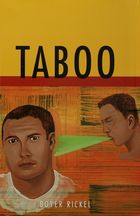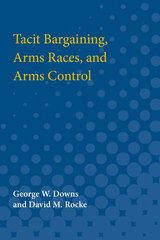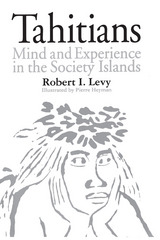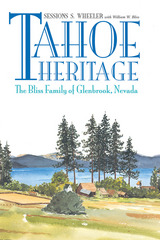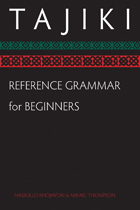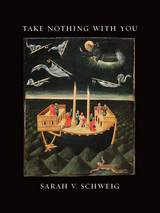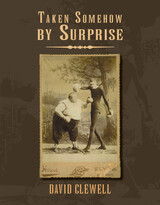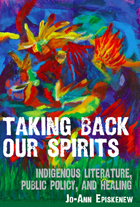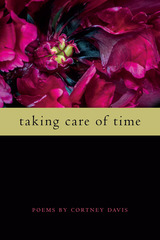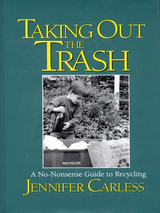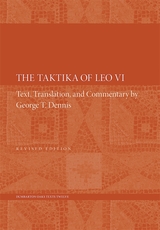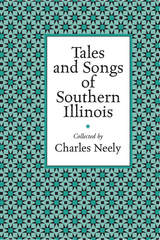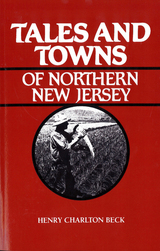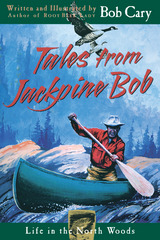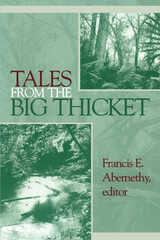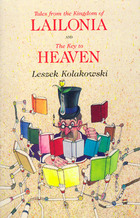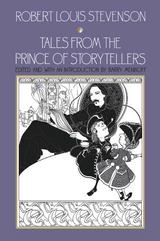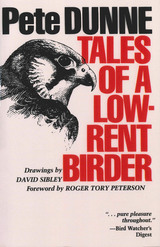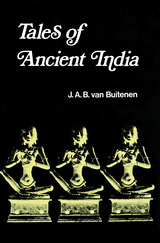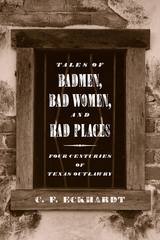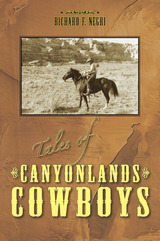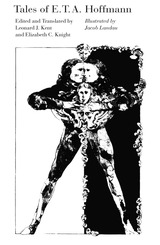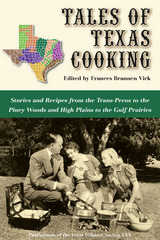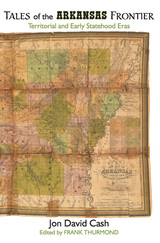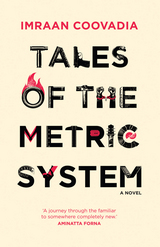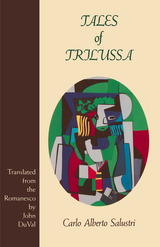 T Bone Burnett: A Life in Pursuit
By Lloyd Sachs
University of Texas Press, 2016 This first critical appreciation of T Bone Burnett reveals how the proponent of Americana music and producer of artists ranging from Robert Plant and Alison Krauss to B. B. King and Elvis Costello has profoundly influenced American music and culture.
T Bone Burnett is a unique, astonishingly prolific music producer, singer-songwriter, guitarist, and soundtrack visionary. Renowned as a studio maven with a Midas touch, Burnett is known for lifting artists to their greatest heights, as he did with Raising Sand, the multiple Grammy Award–winning album by Robert Plant and Alison Krauss, as well as acclaimed albums by Los Lobos, the Wallflowers, B. B. King, and Elvis Costello. Burnett virtually invented “Americana” with his hugely successful roots-based soundtrack for the Coen Brothers film, O Brother, Where Art Thou? Outspoken in his contempt for the entertainment industry, Burnett has nevertheless received many of its highest honors, including Grammy Awards and an Academy Award. T Bone Burnett offers the first critical appreciation of Burnett’s wide-ranging contributions to American music, his passionate advocacy for analog sound, and the striking contradictions that define his maverick artistry. Lloyd Sachs highlights all the important aspects of Burnett’s musical pursuits, from his early days as a member of Bob Dylan’s Rolling Thunder Revue and his collaboration with the playwright Sam Shepard to the music he recently composed for the TV shows Nashville and True Detective and his production of the all-star album Lost on the River: The New Basement Tapes. Sachs also underscores Burnett’s brilliance as a singer-songwriter in his own right. Going well beyond the labels “legendary” or “visionary” that usually accompany his name, T Bone Burnett reveals how this consummate music maker has exerted a powerful influence on American music and culture across four decades.
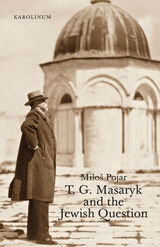 T. G. Masaryk and the Jewish Question
Miloš Pojar
Karolinum Press, 2018 In this book, Miloš Pojar traces the development and transformation of the opinions about Jews and Judaism of the first Czechoslovak president, T. G. Masaryk. Pojar describes the key events and ideas that shaped Masaryk’s attitudes: his first contacts with the Jewish world as a child, and later as a student; his work as a philosopher and sociologist, through which his thinking on Marxism, social issues, Christianity, and Judaism evolved; and his later, pivotal, experience at the time of the anti-Semitic libel trials against Leopold Hilsner, known as the Hilsner Affair. Pojar also details the period when Masaryk, as president, formulated his position on matters such as the Czech-Jewish movement, the question of assimilation, and Zionism. Featuring an entire chapter on Masaryk’s celebrated 1927 trip to Palestine as well as a series of brief profiles of outstanding Jewish figures that explore both Masaryk’s attitudes to their ideas and their opinions of Masaryk, this book is a compelling personal portrait and a substantial contribution to our understanding of the history of Jews in the Czech lands.
 T. S. Eliot: A Short Biography
John Worthen
Haus Publishing, 2009 Biographical writing about Eliot is in a more confused and contested state than is the case with any other major twentieth-century writer. No major biography has been released since the publication of his early poems, Inventions of the March Hare, in 1996, which radically altered the reading public's perception of Eliot. There have been attempts to turn the American woman Emily Hale into the beloved woman of Eliot's middle years; and Eliot has also been blamed for the instability of his first wife and declared a closet homosexual. This biography frees Eliot from such distortions, as well as from his cold and unemotional image. It offers a sympathetic study of his first marriage which does not attempt to blame, but to understand; it shows how Eliot's poetry can be read for its revelations about his inner world. Eliot once wrote that every poem was an epitaph, meaning that it was the inscription on the tombstone of the experience which it commemorated. His poetry shows, however, that the deepest experiences of his life would not lie down and die, and that he felt condemned to write about them.John Worthen is the acclaimed author of D. H. Lawrence: The Life of an Outsider.
 T. S. Eliot and the Cultural Divide
David E. Chinitz
University of Chicago Press, 2003 The modernist poet T. S. Eliot has been applauded and denounced for decades as a staunch champion of high art and an implacable opponent of popular culture. But Eliot's elitism was never what it seemed. T. S. Eliot and the Cultural Divide refurbishes this great writer for the twenty-first century, presenting him as the complex figure he was, an artist attentive not only to literature but to detective fiction, vaudeville theater, jazz, and the songs of Tin Pan Alley.
David Chinitz argues that Eliot was productively engaged with popular culture in some form at every stage of his career, and that his response to it, as expressed in his poetry, plays, and essays, was ambivalent rather than hostile. He shows that American jazz, for example, was a major influence on Eliot's poetry during its maturation. He discusses Eliot's surprisingly persistent interest in popular culture both in such famous works as The Waste Land and in such lesser-known pieces as Sweeney Agonistes. And he traces Eliot's long, quixotic struggle to close the widening gap between high art and popular culture through a new type of public art: contemporary popular verse drama.
What results is a work that will persuade adherents and detractors alike to return to Eliot and find in him a writer who liked a good show, a good thriller, and a good tune, as well as a "great" poem.
The Table: Seasons on a Colorado Ranch
Lara Richardson
University Press of Colorado, 2024 Welcome to The Table where stories of family and faith run deep in ranching tradition. Join Colorado rancher and mother of five, Lara Richardson, as she reveals the complexities of modern frontier life in a picturesque Rocky Mountain valley. She shares seasons of growth and loss in her family and community while exploring the stewardship of land, body, and soul. Richardson lays bare the deep moments of injury, mystery, and death while giving readers a glimpse into the daily demands and generous gifts of a livelihood that is becoming scarcer with each passing year. With her hands in the soil and her heart on each page, Richardson offers recipes for your own table while inviting you to sit a while at hers.
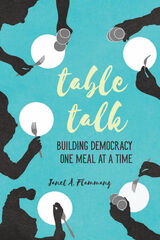 Table Talk: Building Democracy One Meal at a Time
Janet A. Flammang
University of Illinois Press, 2016 The civic virtues of a seat at the table Etiquette books insist that we never discuss politics during a meal. In Table Talk, Janet A. Flammang offers a polite rebuttal, presenting vivid firsthand accounts of people's lives at the table to show how mealtimes can teach us the conversational give-and-take foundational to democracy. Delving into the ground rules about listening, sharing, and respect that we obey when we break bread, Flammang shows how conversations and table activities represent occasions for developing our civil selves. If there are cultural differences over practices--who should speak, what behavior is acceptable, what topics are off limits, how to resolve conflict--our exposure to the making, enforcement, and breaking of these rules offers a daily dose of political awareness and growth. Political table talk provides a forum to practice the conversational skills upon which civil society depends. It also ignites the feelings of respect, trust, and empathy that undergird the idea of a common good that is fundamental to the democratic process.
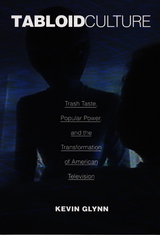 Tabloid Culture: Trash Taste, Popular Power, and the Transformation of American Television
Kevin Glynn
Duke University Press, 2000 During the latter half of the 1980s and throughout the 1990s, television talk shows, infotainment news, and screaming supermarket headlines became ubiquitous in America as the “tabloidization” of the nation’s media took hold. In Tabloid Culture Kevin Glynn draws on diverse theoretical sources and an unprecedented range of electronic and print media in order to analyze important aspects and key debates that have emerged around this phenomenon.
Glynn begins by situating these media shifts within the context of Reaganism, which gave rise to distinctive ideological currents in society and led the socially and economically disenfranchised to access new forms of information via the exploding television industry. He then tackles specific daytime talk shows and tabloid newscasts such as Jerry Springer and A Current Affair, reality-TV programs such as Cops and America’s Most Wanted, and two different supermarket tabloids’ coverage of the O.J. Simpson case. Tabloid Culture is the first book to treat these diverse yet related media forms and events in tandem. Rejecting the elitist dismissal of sensationalist media, Glynn instead traces the cultural currents and countercurrents running through their forms and products. Locating both reactionary and oppositional meanings in these texts, he demonstrates how these particular media genres draw on and contribute to important cultural struggles over the meanings of race, sexuality, gender, class, “normality,” “truth,” and “reality.” The study ends by discussing how the growing use of the Internet provides an entirely new realm in which such material can circulate, distort, inform, and flourish.
This innovative and provocative study of contemporary mainstream media culture in the United States will be valuable to those interested in both print and television media, the cultural-political influence of the Reagan era, and American culture in general.
Taboo
Boyer Rickel
University of Wisconsin Press, 1999 An impressionistic memoir offers images of a life in progress, including scenes from Boyer Rickel’s rural Tempe, Arizona, childhood in the 1950s; his relationship with a physically shrinking father; his eccentric teenage friendships; his growing awareness of his sexuality among young, Hispanic gays; and a trip through Italy with his lover. A personal book, but also wholly universal, Taboo investigates the way one breaks through taboos and becomes a self-realized adult.
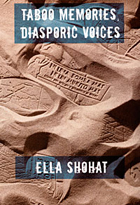 Taboo Memories, Diasporic Voices
Ella Shohat
Duke University Press, 2006 Taboo Memories, Diasporic Voices brings together for the first time a selection of trailblazing essays by Ella Shohat, an internationally renowned theorist of postcolonial and cultural studies of Iraqi-Jewish background. Written over the past two decades, these twelve essays—some classic, some less known, some new—trace a powerful intellectual trajectory as Shohat rigorously teases out the consequences of a deep critique of Eurocentric epistemology, whether to rethink feminism through race, nationalism through ethnicity, or colonialism through sexuality. Shohat’s critical method boldly transcends disciplinary and geographical boundaries. She explores such issues as the relations between ethnic studies and area studies, the paradoxical repercussions for audio-visual media of the “graven images” taboo, the allegorization of race through the refiguring of Cleopatra, the allure of imperial popular culture, and the gender politics of medical technologies. She also examines the resistant poetics of exile and displacement; the staging of historical memory through the commemorations of the two 1492s, the anomalies of the “national” in Zionist discourse, the implications of the hyphen in the concept “Arab-Jew,” and the translation of the debates on orientalism and postcolonialism across geographies. Taboo Memories, Diasporic Voices not only illuminates many of the concerns that have animated the study of cultural politics over the past two decades; it also points toward new scholarly possibilities.
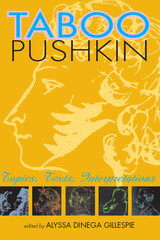 Taboo Pushkin: Topics, Texts, Interpretations
Edited by Alyssa Dinega Gillespie
University of Wisconsin Press, 2012 Since his death in 1837, Alexander Pushkin—often called the “father of Russian literature”—has become a timeless embodiment of Russian national identity, adopted for diverse ideological purposes and reinvented anew as a cultural icon in each historical era (tsarist, Soviet, and post-Soviet). His elevation to mythic status, however, has led to the celebration of some of his writings and the shunning of others. Throughout the history of Pushkin studies, certain topics, texts, and interpretations have remained officially off-limits in Russia—taboos as prevalent in today’s Russia as ever before.
The essays in this bold and authoritative volume use new approaches, overlooked archival materials, and fresh interpretations to investigate aspects of Pushkin’s biography and artistic legacy that have previously been suppressed or neglected. Taken together, the contributors strive to create a more fully realized Pushkin and demonstrate how potent a challenge the unofficial, taboo, alternative Pushkin has proven to be across the centuries for the Russian literary and political establishments.
 Taboo Subjects: Race, Sex, and Psychoanalysis
Gwen Bergner
University of Minnesota Press, 2005 In American literature, a traumatic scene of racial and sexual awakening - frequently involving photographs, mirrors, or acts of witnessing - often precipitates a character's "discovery" of racial identity. Similarly, in the annals of psychoanalysis, notions of self and sexual identity often arise from visual trauma such as the mirror stage and primal scene. Noting this parallel between specular births of racial and sexual subjectivity, Gwen Bergner uses a comparative analysis of psychoanalytic theory and American literature to develop a theory of racialization - the process through which individuals assume an identity as black or white. Examining the primal scenes of double consciousness in works by Frederick Douglass, William Faulkner, and Toni Morrison, among others, alongside the formative visual traumas of psychoanalytic theory of Lacan and Freud, Taboo Subjects reveals how literature disrupts psychoanalysis's conventional models of race and gender identification, forcing a reconfiguration of many foundational psychoanalytic texts. And from psychoanalysis Bergner derives a critical vocabulary for theorizing racialization as it intersects with sex and gender, for both black and white Americans.
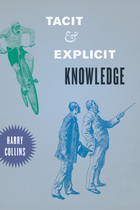 Tacit and Explicit Knowledge
Harry Collins
University of Chicago Press, 2010 Much of what humans know we cannot say. And much of what we do we cannot describe. For example, how do we know how to ride a bike when we can’t explain how we do it? Abilities like this were called “tacit knowledge” by physical chemist and philosopher Michael Polanyi, but here Harry Collins analyzes the term, and the behavior, in much greater detail, often departing from Polanyi’s treatment.
In Tacit and Explicit Knowledge, Collins develops a common conceptual language to bridge the concept’s disparate domains by explaining explicit knowledge and classifying tacit knowledge. Collins then teases apart the three very different meanings, which, until now, all fell under the umbrella of Polanyi’s term: relational tacit knowledge (things we could describe in principle if someone put effort into describing them), somatic tacit knowledge (things our bodies can do but we cannot describe how, like balancing on a bike), and collective tacit knowledge (knowledge we draw that is the property of society, such as the rules for language). Thus, bicycle riding consists of some somatic tacit knowledge and some collective tacit knowledge, such as the knowledge that allows us to navigate in traffic. The intermixing of the three kinds of tacit knowledge has led to confusion in the past; Collins’s book will at last unravel the complexities of the idea.
Tacit knowledge drives everything from language, science, education, and management to sport, bicycle riding, art, and our interaction with technology. In Collins’s able hands, it also functions at last as a framework for understanding human behavior in a range of disciplines.
Tacit Bargaining, Arms Races, and Arms Control
George W. Downs and David M. Rocke
University of Michigan Press, 1990 When most people, including social scientists, reflect on the ways that nations resolve their differences, they tend to think in terms of polar alternatives: war versus negotiation. This perspective ignores a third path: tacit bargaining, which is applicable, as this book shows, to a wide variety of international issues and is especially germane to the problem of treaty maintenance.
 The Tacit Dimension
Michael Polanyi
University of Chicago Press, 2009 “I shall reconsider human knowledge by starting from the fact that we can know more than we can tell,” writes Michael Polanyi, whose work paved the way for the likes of Thomas Kuhn and Karl Popper. The Tacit Dimension argues that tacit knowledge—tradition, inherited practices, implied values, and prejudgments—is a crucial part of scientific knowledge. Back in print for a new generation of students and scholars, this volume challenges the assumption that skepticism, rather than established belief, lies at the heart of scientific discovery. “Polanyi’s work deserves serious attention. . . . [This is a] compact presentation of some of the essentials of his thought.”—Review of Metaphysics “Polanyi’s work is still relevant today and a closer examination of this theory that all knowledge has personal and tacit elements . . . can be used to support and refute a variety of widely held approaches to knowledge management.”—Electronic Journal of Knowledge "The reissuing of this remarkable book give us a new opportunity to see how far-reaching—and foundational—Michael Polanyi's ideas are, on some of the age-old questions in philosophy."—Amartya Sen, from the new Foreword
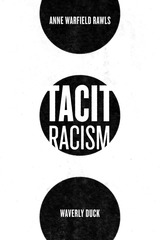 Tacit Racism
Anne Warfield Rawls and Waverly Duck
University of Chicago Press, 2020 We need to talk about racism before it destroys our democracy. And that conversation needs to start with an acknowledgement that racism is coded into even the most ordinary interactions.
Every time we interact with another human being, we unconsciously draw on a set of expectations to guide us through the encounter. What many of us in the United States—especially white people—do not recognize is that centuries of institutional racism have inescapably molded those expectations. This leads us to act with implicit biases that can shape everything from how we greet our neighbors to whether we take a second look at a resume. This is tacit racism, and it is one of the most pernicious threats to our nation.
In Tacit Racism, Anne Warfield Rawls and Waverly Duck illustrate the many ways in which racism is coded into the everyday social expectations of Americans, in what they call Interaction Orders of Race. They argue that these interactions can produce racial inequality, whether the people involved are aware of it or not, and that by overlooking tacit racism in favor of the fiction of a “color-blind” nation, we are harming not only our society’s most disadvantaged—but endangering the society itself.
Ultimately, by exposing this legacy of racism in ordinary social interactions, Rawls and Duck hope to stop us from merely pretending we are a democratic society and show us how we can truly become one.
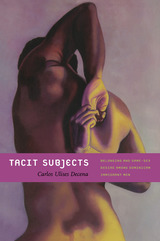 Tacit Subjects: Belonging and Same-Sex Desire among Dominican Immigrant Men
Carlos Ulises Decena
Duke University Press, 2011 Tacit Subjects is a pioneering analysis of how gay immigrant men of color negotiate race, sexuality, and power in their daily lives. Drawing on ethnographic research with Dominicans in New York City, Carlos Ulises Decena explains that while the men who shared their life stories with him may self-identify as gay, they are not the liberated figures of traditional gay migration narratives. Decena contends that in migrating to Washington Heights, a Dominican enclave in New York, these men moved from one site to another within an increasingly transnational Dominican society. Many of them migrated and survived through the resources of their families and broader communities. Explicit acknowledgment or discussion of their homosexuality might rupture these crucial social and familial bonds. Yet some of Decena’s informants were sure that their sexuality was tacitly understood by their family members or others close to them. Analyzing their recollections about migration, settlement, masculinity, sex, and return trips to the Dominican Republic, Decena describes how the men at the center of Tacit Subjects contest, reproduce, and reformulate Dominican identity in New York. Their stories reveal how differences in class, race, and education shape their relations with fellow Dominicans. They also offer a view of “gay New York” that foregrounds the struggles for respect, belonging, and survival within a particular immigrant community.
 Tacky’s Revolt: The Story of an Atlantic Slave War
Vincent Brown
Harvard University Press, 2019 Winner of the Anisfield-Wolf Book Award
Winner of the Frederick Douglass Book Prize
Winner of the Elsa Goveia Book Prize
Winner of the James A. Rawley Prize in the History of Race Relations
Winner of the P. Sterling Stuckey Book Prize
Winner of the Harriet Tubman Prize
Winner of the Phillis Wheatley Book Award
Finalist for the Cundill Prize
“Brilliant…groundbreaking…Brown’s profound analysis and revolutionary vision of the Age of Slave War—from the too-often overlooked Tacky’s Revolt to the better-known Haitian Revolution—gives us an original view of the birth of modern freedom in the New World.”
—Cornel West
“Not only a story of the insurrection, but ‘a martial geography of Atlantic slavery,’ vividly demonstrating how warfare shaped every aspect of bondage…Forty years after Tacky’s defeat, new arrivals from Africa were still hearing about the daring rebels who upended the island.”
—Harper’s
“A sobering read for contemporary audiences in countries engaged in forever wars…It is also a useful reminder that the distinction between victory and defeat, when it comes to insurgencies, is often fleeting: Tacky may have lost his battle, but the enslaved did eventually win the war.”
—New Yorker
In the second half of the eighteenth century, as European imperial conflicts extended their domain, warring African factions fed their captives to the transatlantic slave trade while masters struggled to keep their restive slaves under the yoke. In this contentious atmosphere, a movement of enslaved West Africans in Jamaica organized to throw off that yoke by violence. Their uprising—which became known as Tacky’s Revolt—featured a style of fighting increasingly familiar today: scattered militias opposing great powers, with fighters hard to distinguish from noncombatants. Even after it was put down, the insurgency rumbled throughout the British Empire at a time when slavery seemed the dependable bedrock of its dominion. That certitude would never be the same, nor would the views of black lives, which came to inspire both more fear and more sympathy than before.
Tracing the roots, routes, and reverberations of this event, Tacky’s Revolt expands our understanding of the relationship between European, African, and American history as it speaks to our understanding of wars of terror today.
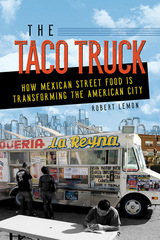 The Taco Truck: How Mexican Street Food Is Transforming the American City
Robert Lemon
University of Illinois Press, 2019 Icons of Mexican cultural identity and America's melting pot ideal, taco trucks have transformed cityscapes from coast to coast. The taco truck radiates Mexican culture within non-Mexican spaces with a presence—sometimes desired, sometimes resented—that turns a public street corner into a bustling business. Drawing on interviews with taco truck workers and his own skills as a geographer, Robert Lemon illuminates new truths about foodways, community, and the unexpected places where ethnicity, class, and culture meet. Lemon focuses on the San Francisco Bay Area, Sacramento, and Columbus, Ohio, to show how the arrival of taco trucks challenge preconceived ideas of urban planning even as cities use them to reinvent whole neighborhoods. As Lemon charts the relationships between food practices and city spaces, he uncovers the many ways residents and politicians alike contest, celebrate, and influence not only where your favorite truck parks, but what's on the menu.
 The Tacos of Texas
By Mando Rayo and Jarod Neece
University of Texas Press, 2016 Rooted in tradición mexicana and infused with Texas food culture, tacos are some of Texans’ all-time favorite foods. In The Tacos of Texas, the taco journalists Mando Rayo and Jarod Neece take us on a muy sabroso taco tour around the state as they discover the traditions, recipes, stories, and personalities behind puffy tacos in San Antonio, trompo tacos in Dallas, breakfast tacos in Austin, carnitas tacos in El Paso, fish tacos in Corpus Christi, barbacoa in the Rio Grande Valley, and much more. Starting with the basics—tortillas, fillings, and salsas—and how to make, order, and eat tacos, the authors highlight ten taco cities/regions of Texas. For each place, they describe what makes the tacos distinctive, name their top five places to eat, and listen to the locals tell their taco stories. They hear from restaurant owners, taqueros, abuelitas, chefs, and patrons—both well-known and everyday folks—who talk about their local taco history and culture while sharing authentic recipes and recommendations for the best taco purveyors. Whether you can’t imagine a day without tacos or you’re just learning your way around the trailers, trucks, and taqueros that make tacos happen, The Tacos of Texas is the indispensable guidebook, cookbook, and testimonio.
 Tactical Inclusion: Difference and Vulnerability in U.S. Military Advertising
Jeremiah Favara
University of Illinois Press, 2024 The revolution in military recruitment advertising to people of color and women played an essential role in making the US military one of the most diverse institutions in the United States. Starting at the dawn of the all-volunteer era, Jeremiah Favara illuminates the challenges at the heart of military inclusion by analyzing recruitment ads published in three commercial magazines: Sports Illustrated, Cosmopolitan, and Ebony. Favara draws on Black feminism, critical race theory, and queer of color critique to reveal how the military and advertisers affected change by deploying a set of strategies and practices called tactical inclusion. As Favara shows, tactical inclusion used representations of servicemembers in the new military to connect with people susceptible to recruiting efforts and rendered these new audiences vulnerable to, valuable to, and subject to state violence. Compelling and eye-opening, Tactical Inclusion combines original analysis with personal experience to chart advertising’s role in building the all-volunteer military.
 Tactical Media
Rita Raley
University of Minnesota Press, 2009 The first book to focus exclusively on the tactics and goals of new media art activists Tactical media describes interventionist media art practices that engage and critique the dominant political and economic order. Rather than taking to the streets and staging spectacular protests, the practitioners of tactical media engage in an aesthetic politics of disruption, intervention, and education. From They Rule, an interactive map of the myriad connections between the world’s corporate and political elite created by Josh On and Futurefarmers, to Black Shoals, a financial market visualization that is intended to be both aesthetically and politically disruptive, they embrace a broad range of oppositional practices. In Tactical Media, Rita Raley provides a critical exploration of the new media art activism that has emerged out of, and in direct response to, postindustrialism and neoliberal globalization. Through close readings of projects by the DoEAT group, the Critical Art Ensemble, Electronic Civil Disobedience, and other tactical media groups, she articulates their divergent methods and goals and locates a virtuosity that is also boldly political. Contemporary models of resistance and dissent, she finds, mimic the decentralized and virtual operations of global capital and the post-9/11 security state to exploit and undermine the system from within. Emphasizing the profound shift from strategy to tactics that informs new media art-activism, Raley assesses the efficacy of its symbolic performances, gamings, visualizations, and hacks. With its cogent analyses of new media art and its social impact, Tactical Media makes a timely and much needed contribution to wider debates about political activism, contemporary art, and digital technology.
Tactical Persistent Surveillance Radar with Applications
David Lynch Jr.
The Institution of Engineering and Technology, 2018 Tactical Persistent Surveillance Radar with Applications introduces technologists to the essential elements of persistent surveillance of tactical targets from both a hardware and software point of view, using simple Mathcad, Excel and Basic examples with real data. It is based on the type of surveillance done by drones like Scan Eagle, Predator, Reaper, Global Hawk, and manned aircraft like U-2, ASTOR, and JSTARS as well as spacecraft. The general topic is cellphone and datalink intercept, ground moving target radar, synthetic aperture radar, navigation, tracking, electronic scanning and cueing electro-optical sensors for activity based surveillance.
 Tactical Urbanism: Short-term Action for Long-term Change
Mike Lydon and Anthony Garcia
Island Press, 2014 In the twenty-first century, cities worldwide must respond to a growing and diverse population, ever-shifting economic conditions, new technologies, and a changing climate. Short-term, community-based projects—from pop-up parks to open streets initiatives—have become a powerful and adaptable new tool of urban activists, planners, and policy-makers seeking to drive lasting improvements in their cities and beyond. These quick, often low-cost, and creative projects are the essence of the Tactical Urbanism movement. Whether creating vibrant plazas seemingly overnight or re-imagining parking spaces as neighborhood gathering places, they offer a way to gain public and government support for investing in permanent projects, inspiring residents and civic leaders to experience and shape urban spaces in a new way.
Tactical Urbanism, written by Mike Lydon and Anthony Garcia, two founders of the movement, promises to be the foundational guide for urban transformation. The authors begin with an in-depth history of the Tactical Urbanism movement and its place among other social, political, and urban planning trends. A detailed set of case studies, from guerilla wayfinding signs in Raleigh, to pavement transformed into parks in San Francisco, to a street art campaign leading to a new streetcar line in El Paso, demonstrate the breadth and scalability of tactical urbanism interventions. Finally, the book provides a detailed toolkit for conceiving, planning, and carrying out projects, including how to adapt them based on local needs and challenges.
Tactical Urbanism will inspire and empower a new generation of engaged citizens, urban designers, land use planners, architects, and policymakers to become key actors in the transformation of their communities.
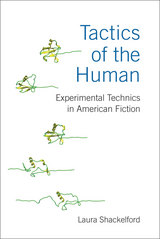 Tactics of the Human: Experimental Technics in American Fiction
Laura Shackelford
University of Michigan Press, 2015 Tactics of the Human returns to American fiction published during the 1990s, formative years for digital cultures, to reconsider these narratives’ comparative literary print methods of critically engaging with digital technologies and their now ubiquitous computation-based modes of circulation, scenes of writing, and social spaces. It finds that fiction by John Barth, Shelley Jackson, Leslie Marmon Silko, Ruth L. Ozeki, and Jeffrey Eugenides, by creatively transposing digital writing, material formats, and spatiotemporal orientations into print, registers shifting relations to technologies at multiple sites and scales. Grappling with the digital practices catalyzed by post–World War II biological, information, and systems theory, these literary narratives tactically enlist, and enable speculative diagnoses of, emerging relations to digital technologies. Their experimental technics comparatively retrace emerging relations to the digital as these impact American nationalisms and their transnational economic networks; processes of gendering and racialization that remain crucial to differential discourses of the human; and as they enter, unnoticed, into micropractices of everyday life and lived space. In the midst of expanding technoscientific processes of digital de- and re-materialization that render multiple, charged boundaries of the human increasingly plastic, Tactics of the Human illustrates why it is ever more crucial to query and assess the divergent (re)understandings of the human now categorized, quite loosely, as posthumanisms with particular attention to women’s, subalterns’, and other knowledges already considered liminal to the human. It identifies here and pursues strains of systems thinking, informed by feminist, new materialist, queer, and subaltern understandings of material practices, revealing why these are so pivotal to ongoing efforts to assess current limits to digital technics and expand upon their biological, cultural, social, and poetic potentialities.
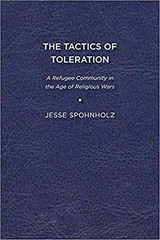 The Tactics of Toleration: A Refugee Community in the Age of Religious Wars
Jesse Spohnholz
University of Delaware Press, 2011 The Tactics of Toleration examines the preconditions and limits of toleration during an age in which Europe was sharply divided along religious lines. During the Age of Religious Wars, refugee communities in borderland towns like the Rhineland city of Wesel were remarkably religiously diverse and culturally heterogeneous places. Examining religious life from the perspective of Calvinists, Lutherans, Mennonites, and Catholics, this book examines how residents dealt with pluralism during an age of deep religious conflict and intolerance. Based on sources that range from theological treatises to financial records and from marriage registries to testimonies before secular and ecclesiastical courts, this project offers new insights into the strategies that ordinary people developed for managing religious pluralism during the Age of Religious Wars. Historians have tended to emphasize the ways in which people of different faiths created and reinforced religious differences in the generations after the Reformation’s break-up of Christianity, usually in terms of long-term historical narratives associated with modernization, including state building, confessionalization, and the subsequent rise of religious toleration after a century of religious wars. In contrast, Jesse Spohnholz demonstrates that although this was a time when Christians were engaged in a series of brutal religious wars against one another, many were also learning more immediate and short-term strategies to live alongside one another. This book considers these “tactics for toleration” from the vantage point of religious immigrants and their hosts, who learned to coexist despite differences in language, culture, and religion. It demands that scholars reconsider toleration, not only as an intellectual construct that emerged out of the Enlightenment, but also as a dynamic set of short-term and often informal negotiations between ordinary people, regulating the limits of acceptable and unacceptable behavior. Published by University of Delaware Press. Distributed worldwide by Rutgers University Press.
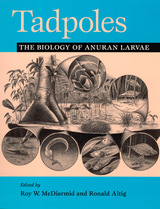 Tadpoles: The Biology of Anuran Larvae
Edited by Roy W. McDiarmid and Ronald Altig
University of Chicago Press, 1999 In our own juvenile stage, many of us received our wide-eyed introduction to the wonders of nature by watching the metamorphosis of swimming tadpoles into leaping frogs and toads. The recent alarming declines in amphibian populations worldwide and the suitability of amphibians for use in answering research questions in disciplines as diverse as molecular systematics, animal behavior, and evolutionary biology have focused enormous attention on tadpoles. Despite this popular and scientific interest, relatively little is known about these fascinating creatures.
In this indispensable reference, leading experts on tadpole biology relate what we currently know about tadpoles and what we might learn from them in the future. Tadpoles provides detailed summaries of tadpole morphology, development, behavior, ecology, and environmental physiology; explores the evolutionary consequences of the tadpole stage; synthesizes available information on their biodiversity; and presents a standardized terminology and an exhaustive literature review of tadpole biology.
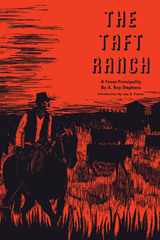 The Taft Ranch: A Texas Principality
By A. Ray Stephens
University of Texas Press, 1964 For fifty years the progressive Coleman-Fulton Pasture Company, popularly known as the Taft Ranch, led in the development of South Texas, and in the early twentieth century achieved national and international repute for its contributions to agriculture. The story of the ranch reaches its climax as the firm is absorbed into the community growing up around it—the same community the ranch had nurtured to an unprecedented prosperity. In 1961 A. Ray Stephens visited Taft, Texas, and received permission to use the dust-covered records, which for thirty years had been closed to historians. These records, plus the valuable supplementary material in the Fulton Collection at the University of Texas, have enabled the author to tell the complete story of the ranch from its inception in 1880 to its dissolution in 1930. In 1880, with a fifty-year charter, the Coleman-Fulton Pasture Company was legally born as a private corporation. For the duration of its history this company aided the advancement of South Texas through effective utilization of the fertile land, through development of agriculture and related industries, and through encouragement of settlers and curious visitors to the Coastal Bend region. Its history is a long, determined fight against severe drought, cattle disease, and financial insolvency. Guided by farsighted men who believed in experimentation in agriculture—and who also promoted the establishment of stores, schools, colleges, churches, and industrial plants—the company not only survived but prospered, and by 1920 its owners could survey their vast properties with well-earned satisfaction. The struggling cattle firm of 1880 had expanded into a multi-interest, profitable corporation that had established and supervised most of the industries in Taft, Texas. Stephens' well-documented 1964 study had been long needed. During the three decades preceding it, the ranch had been well-nigh forgotten; only the handful of people, then still living, who had worked on the ranch had kept its memory fresh, while the voluminous company records remained inaccessible. The author supplemented his study of company records and newspapers with archival material, government records, and information obtained during hours of interviewing. His book will insure for the Taft Ranch its deservedly prominent position in Texas history. The lively introduction was written by Joe B. Frantz (1917–1993) who, in his role of Professor of History at the University of Texas, encouraged the study and watched its development.
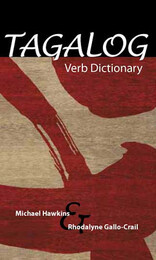 Tagalog Verb Dictionary
Michael Hawkins and Rhodalyne Gallo-Crail
Northern Illinois University Press, 2011
This handy reference is a concise explanatory text and English-Tagalog / Tagalog-English verb guide designed to address and facilitate the most important aspect of Tagalog language learning—understanding and mastering the complex focal orientation of verbs. It is organized into an accessible pattern illustrating the primary conjugations that establish aspect and actor/object focus for each verb. These verbs are further enhanced by sample sentences demonstrating their usage and introducing common cultural contexts for effective communication. In addition to the verb guide, this text also provides a short history of Tagalog, an extensive explanation of verbal function in the language, and a number of learners’ tips intended to ease and expedite the learning process.
Taken together, these materials, along with a persistent willingness to engage the language, will facilitate a quick and effective path to fluency. Whether one is studying within the structured environment of a classroom or independently in their spare time, this book is designed to give special attention to the most critical aspects of Tagalog language learning. Tagalog Verb Dictionary’s orderly and easily accessible layout and neat size make it the ideal companion for students, travelers, and anyone interested in fast fluency in the language.
 Tage Erlander: Serving the Welfare State, 1946-1969
Olof Ruin
University of Pittsburgh Press, 1990
Prime minister of Sweden and leader of the Social Democratic party from 1946-1969, Tage Erlander enjoyed a career that was remarkable both for its major accomplishments and longevity. Under his leadership, Sweden became an exemplary welfare state following World War II. Universal pensions, child support, health insurance, extended paid vacations, subsidized housing, and many other benefits made Sweden's standard of living the envy of the world.
This definitive political biography is both the study of an individual style of leadership and the role of the prime minister in a parliamentary state. It shows Erlander as a complex and engaging intellectual fiercely loyal to his party, agitative yet dedicated to cooperation between parties.
Olof Ruin analyzes Erlander's various roles as Riksdag caucus leader, cabinet organizer, party leader, promoter of domestic consensus, and foreign policy maker. Ruin is the first scholar to be given unrestricted access to Erlander's diaries.
Tahitians: Mind and Experience in the Society Islands
Robert I. Levy llustrated by Pierre Heyman
University of Chicago Press, 1975 This seminal work in several fields—person-centered anthropology, comparative psychology, and social history—documents the inner life of the Tahitians with sensitivity and insight. At the same time Levy reveals the ways in which private and public worlds interact. Tahitians is an ethnography focused on private but culturally organized behavior resulting in a wealth of material for the understanding of the interaction among historical, cultural, and personal spheres.
"This is a unique addition to anthropological literature. . . . No review could substitute for reading it."—Margaret Mead, American Anthropologist
Tahoe Heritage: The Bliss Family Of Glenbrook, Nevada
Sessions S Wheeler
University of Nevada Press, 1997 Tahoe Heritage is a lively chronicle of four generations of the pioneering Bliss family, beginning with Duane L. Bliss, a visionary who built an impressive lumbering business and later the renowned Glenbrook Inn. The inn was completed in 1907 and quickly became a destination for the elite of San Francisco. The hotel register contains the names of national figures who loved and frequented Glenbrook: Ulysses Grant, Joaquin Miller, Thomas Edison, Henry Ford, Clark Gable, and Rita Hayworth, to name a few. The Bliss family closed the inn in 1976. Anyone who has visited the Tahoe area, now a very different place from the idyllic days of Bliss family management, will enjoy this account of its growth and the remarkable family which brought it about.
Tahrir Suite: Poems
Matthew Shenoda
Northwestern University Press, 2015 Winner, Arab American National Museum's 2015 George Ellenbogen Poetry Award
Tahrir Suite is a book-length poem that contemplates immigration, homeland, and diaspora in the twenty-first century. The poem, inspired by recent events in Egypt, cycles through the journey of two Egyptians moving across borders, languages, cultures, landscapes, and political systems while their life in the U.S. diaspora evolves and their home country undergoes revolutionary change. Written from a perspective and about a place that is virtually unexplored in contemporary American poetry, Tahrir Suite works to capture the complicated essence of what it means to be from a specific place that is experiencing such radical change and how our understandings of “home” and “place” constantly evolve. Tahrir Suite is a musical meditation on what it means to be a global citizen in contemporary times.
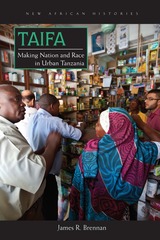 Taifa: Making Nation and Race in Urban Tanzania
James R. Brennan
Ohio University Press, 2012 Taifa is a story of African intellectual agency, but it is also an account of how nation and race emerged out of the legal, social, and economic histories in one major city, Dar es Salaam. Nation and race—both translatable as taifa in Swahili—were not simply universal ideas brought to Africa by European colonizers, as previous studies assume. They were instead categories crafted by local African thinkers to make sense of deep inequalities, particularly those between local Africans and Indian immigrants. Taifa shows how nation and race became the key political categories to guide colonial and postcolonial life in this African city. Using deeply researched archival and oral evidence, Taifa transforms our understanding of urban history and shows how concerns about access to credit and housing became intertwined with changing conceptions of nation and nationhood. Taifa gives equal attention to both Indians and Africans; in doing so, it demonstrates the significance of political and economic connections between coastal East Africa and India during the era of British colonialism, and illustrates how the project of racial nationalism largely severed these connections by the 1970s.
 The Tail of the Dragon: New Dance, 1976–1982
Marcia B. Siegel
Duke University Press, 1991 In The Tail of the Dragon, Marcia B. Siegel and Nathaniel Tileston track the evolution of new dance in New York during the rich and crucial transitional period from the mid-1970s to the early 1980s. Siegel, one of America’s most important dance critics, and Tileston, an accomplished dance photographer, focus on the choreographers who were propelled into rebellion against conventional modern dance by the Judson Dance Theater and other countercultural movements born of the 1960s.
This collection of Siegel’s writing, compiled from reviews in Soho Weekly News and New York Magazine, as well as from longer essays and notebook pieces, forms an insightful commentary--occasionally wry, always perceptive—on the absorption of a radical art form by the mainstream. From minimalism, improvisation, street dancing, body awareness, and “poor theater” experimental strategies, these young rebels identified and adopted personal styles of movement and dancemaking; from that, they turned gradually to tamer, more accessible work, marked by virtuosic dancing, proscenium-ready repertoires, and touring companies.
Included in this story are the principal players in the “postmodernist” dance movement—Merce Cunningham, Twyla Tharp, Trisha Brown, David Gordon—now well known internationally as leaders of dance in the 1990s. Siegel also looks at artists who worked steadily but less visibly, influential ones who drifted out of dance, and unknowns who have gained prominence. The dances described here are formal and outlandish, scruffy and beautiful, endearingly fallible and icily perfect.
In rightfully celebrating the importance of dances long forgotten, The Tail of the Dragon produces a vibrant portrait of a generation of dance.
 Tail of the Storm: Flying Missions in the First Gulf War
Alan Cockrell
University of Alabama Press, 1995 Cockrell writes lyrically about flying and about the emotional and intellectual satisfaction enjoyed by those who fly
Within days of Saddam Hussein’s invasion of Kuwait, the far reaching arm of American airpower sprang into action. The skyscapes of the North Atlantic, Europe, and the Mediterranean became laced with the contrails of great jets flowing day and night toward the Persian Gulf. From the skies, manpower and material poured onto the bleak sands under the ominous clouds of the gathering storm, and in only a few weeks the size of the effort eclipsed that of the Berlin Airlift. The thousands of crewmembers flying the jets, as well as those servicing and managing them, became the backbone of history’s largest air logistical operation. Many of these men and women were Air Force reservists, and the author participated as a pilot of a C-141B Starlifter with the Mississippi Air National Guard.
Cockrell writes lyrically about flying and about the emotional and intellectual satisfaction enjoyed by those who fly. His focus is on the people recalled to active duty, who flew thousands of hours, coping with fatigue, cracked wings, missile attacks, and, in some cases, deteriorating businesses and families at home. Tail of the Storm gives expression to their love of flight, as well as their dedication to the endangered values of duty, honor, country. This story is good reading—not only for those who share the author’s enthusiasm for flying but also for those who read for pleasure and have a curiosity about a pilot’s world.
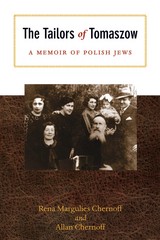 The Tailors of Tomaszow: A Memoir of Polish Jews
Rena Margulies Chernoff
Texas Tech University Press, 2014 Preserving the collective memory of a community that is no more
Seven decades after the Nazis annihilated the Jewish community of Tomaszow-Mazowiecki, Poland, comes a gripping eyewitness narrative told by one of the youngest survivors of the Holocaust, as well as through first-hand accounts of other Tomaszow survivors. This unique communal memoir presents a rare view of Eastern European Jewry, before, during, and after World War II. It is both the memoir of a child and of a lost Jewish community, an unvarnished story in which disputes, controversy, and scandal all play a role in capturing the true flavor of life in this time and place.
Nearly 14,000 Jews, one-third of the town’s population, resided in Tomaszow-Mazowiecki before World War II, many making their living as tailors and seamstresses. Only 250 of them survived the Holocaust, in part because of their skill with a needle and thread.
Engaging and highly accessible, The Tailors of Tomaszow is a powerful resource for educators and a compelling read for anyone wishing to gain a deeper, more personal understanding of Eastern European Jewry and the Holocaust.
The Tain of the Mirror: Derrida and the Philosophy of Reflection
Rodolphe Gasché
Harvard University Press, 1986 Deconstruction is no game of mirrors, revealing the text as a play of surface against surface. Its more radical philosophical effort is to get behind the mirror and question the very nature of reflection. The Tain of the Mirror (tain names the tinfoil, or lusterless back of the mirror) explores that gritty surface without which no reflection would be possible. Rodolphe Gasché does what no one has done before in many discussions of Derrida, namely to tie his work in an authoritative way to its origins in the history of the criticism of reflexivity.
 Tainted Earth: Smelters, Public Health, and the Environment
Sullivan, Marianne
Rutgers University Press, 2014 Smelting is an industrial process involving the extraction of metal from ore. During this process, impurities in ore—including arsenic, lead, and cadmium—may be released from smoke stacks, contaminating air, water, and soil with toxic-heavy metals. The problem of public health harm from smelter emissions received little official attention for much for the twentieth century. Though people living near smelters periodically complained that their health was impaired by both sulfur dioxide and heavy metals, for much of the century there was strong deference to industry claims that smelter operations were a nuisance and not a serious threat to health. It was only when the majority of children living near the El Paso, Texas, smelter were discovered to be lead-exposed in the early 1970s that systematic, independent investigation of exposure to heavy metals in smelting communities began. Following El Paso, an even more serious led poisoning epidemic was discovered around the Bunker Hill smelter in northern Idaho. In Tacoma, Washington, a copper smelter exposed children to arsenic—a carcinogenic threat. Thoroughly grounded in extensive archival research, Tainted Earth traces the rise of public health concerns about nonferrous smelting in the western United States, focusing on three major facilities: Tacoma, Washington; El Paso, Texas; and Bunker Hill, Idaho. Marianne Sullivan documents the response from community residents, public health scientists, the industry, and the government to pollution from smelters as well as the long road to protecting public health and the environment. Placing the environmental and public health aspects of smelting in historical context, the book connects local incidents to national stories on the regulation of airborne toxic metals. The nonferrous smelting industry has left a toxic legacy in the United States and around the world. Unless these toxic metals are cleaned up, they will persist in the environment and may sicken people—children in particular—for generations to come. The twentieth-century struggle to control smelter pollution shares many similarities with public health battles with such industries as tobacco and asbestos where industry supported science created doubt about harm, and reluctant government regulators did not take decisive action to protect the public’s health.
 Taiwan: The Land Colonialisms Made
Arik Dirlik, Ping-Hui Liao, and Ya-Chung Chang, special issue editors
Duke University Press, 2018 The contributors to this special issue examine the role successive colonialisms played in forging a distinct Taiwanese identity and the theoretical implications the Taiwanese experience of colonialism raises regarding the making of modern national identities. In addition to its indigenous culture, a long succession of colonial rulers—variously the Netherlands, Spain, the kingdom of Tungning, the Ming and Qing dynasties, Japan, and Kuomintang China—have forged a distinctive Taiwanese national identity. The Taiwan case suggests that it is misleading to approach colonialism as an obstacle to national identity without also accounting for the ways in which colonialism has historically factored into the constitution of national identities. The contributors address the ways in which the colonizer’s culture transformed the colonized, setting them in new historical directions, even if those directions were not what the colonizers expected.
Contributors: Shu-jung Chen, Leo T. S. Ching, Ya-Chung Chuang, Arif Dirlik, P. Kerim Friedman, Ping-hui Liao, Nikky Lin, Jing Tsu, Yin Wang, Fang-chih Irene Yang
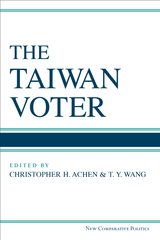 The Taiwan Voter
Christopher H. Achen and T. Y. Wang, Editors
University of Michigan Press, 2017 The Taiwan Voter examines the critical role ethnic and national identities play in politics, utilizing the case of Taiwan. Although elections there often raise international tensions, and have led to military demonstrations by China, no scholarly books have examined how Taiwan’s voters make electoral choices in a dangerous environment. Critiquing the conventional interpretation of politics as an ideological battle between liberals and conservatives, The Taiwan Voter demonstrates in Taiwan the party system and voters’ responses are shaped by one powerful determinant of national identity—the China factor.
Taiwan’s electoral politics draws international scholarly interest because of the prominent role of ethnic and national identification. While in most countries the many tangled strands of competing identities are daunting for scholarly analysis, in Taiwan the cleavages are powerful and limited in number, so the logic of interrelationships among issues, partisanship, and identity are particularly clear. The Taiwan Voter unites experts to investigate the ways in which social identities, policy views, and partisan preferences intersect and influence each other. These novel findings have wide applicability to other countries, and will be of interest to a broad range of social scientists interested in identity politics.
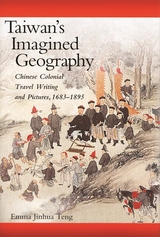 Taiwan’s Imagined Geography: Chinese Colonial Travel Writing and Pictures, 1683–1895
Emma Jinhua Teng
Harvard University Press, 2004 Until 300 years ago, the Chinese considered Taiwan a "land beyond the seas," a "ball of mud" inhabited by "naked and tattooed savages." The incorporation of this island into the Qing empire in the seventeenth century and its evolution into a province by the late nineteenth century involved not only a reconsideration of imperial geography but also a reconceptualization of the Chinese domain. The annexation of Taiwan was only one incident in the much larger phenomenon of Qing expansionism into frontier areas that resulted in a doubling of the area controlled from Beijing and the creation of a multi-ethnic polity. The author argues that travelers' accounts and pictures of frontiers such as Taiwan led to a change in the imagined geography of the empire. In representing distant lands and ethnically diverse peoples of the frontiers to audiences in China proper, these works transformed places once considered non-Chinese into familiar parts of the empire and thereby helped to naturalize Qing expansionism.
By viewing Taiwan-China relations as a product of the history of Qing expansionism, the author contributes to our understanding of current political events in the region.
 Taj Mahal
Giles Tillotson
Harvard University Press, 2008 An enduring monument of haunting beauty, the Taj Mahal seems a symbol of stability itself. The familiar view of the glowing marble mausoleum from the gateway entrance offers the very picture of permanence. And yet this extraordinary edifice presents a shifting image to observers across time and cultures. The meaning of the Taj Mahal, the perceptions and responses it prompts, ideas about the building and the history that shape them: these form the subject of Giles Tillotson’s book. More than a richly illustrated history—though it is that as well—this book is an eloquent meditation on the place of the Taj Mahal in the cultural imagination of India and the wider world.
Since its completion in 1648, the mausoleum commissioned by the fifth Mughal emperor, Shah Jahan, for his wife Mumtaz Mahal, has come to symbolize many things: the undying love of a man for his wife, the perfection of Mughal architecture, the ideal synthesis of various strands of subcontinental aesthetics, even an icon of modern India itself. Exploring different perspectives brought to the magnificent structure—by a Mughal court poet, an English Romantic traveler, a colonial administrator, an architectural historian, or a contemporary Bollywood filmmaker—this book is an incomparable guide through the varied and changing ideas inspired by the Taj Mahal, from its construction to our day. In Tillotson’s expert hands, the story of a seventeenth-century structure in the city of Agra reveals itself as a story about our own place and time.
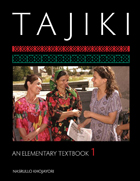 Tajiki: An Elementary Textbook, Volume 1
Nasrullo Khojayori
Georgetown University Press, 2009 Tajiki, a variety of modern Persian spoken in Central Asia, is the official language of Tajikistan; most speakers of Tajiki live in Tajikistan and Uzbekistan. Volume 1 of Tajiki: An Elementary Textbook is designed to cover the first semester of beginning-level language instruction; together, Volumes 1 and 2 of Tajiki cover one year of instruction. Each volume of Tajiki: An Elementary Textbook uses the latest pedagogical thinking to teach basic communication skills and linguistic forms in their cultural context. Tested in the classroom, Tajiki enhances students' exposure to the language by providing the only authentic video and audio available in Tajiki. Each volume contains a CD-ROM that includes authentic audio and video materials to accompany the text and extra exercises, all in Flash format and all of which are keyed to the textbook. Each book also includes an extensive glossary, maps of the world labeled in Tajiki, and four-color illustrations and photographs throughout. Topics Covered
Volume One (first semester): Greetings, the Tajiki alphabet, the classroom, professions, introductions, nationalities and places of origin, weather, telling time, family, money, food Volume Two (second semester): Sports, cooking and ordering meals, clothing, travel, months, seasons, holidays, body parts, medicine, university life, housing (city and village), regions and religions of Tajikistan Minimum System Requirements • Intel Pentium II 450 MHz or faster processor (or equivalent); Mac OS 10.4 or higher
• 128 MB of RAM
• CD Drive
• Speakers or headphones
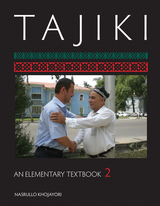 Tajiki: An Elementary Textbook, Volume 2
Nasrullo Khojayori
Georgetown University Press, 2009 Enhances students’ exposure to the language, providing the only authentic multimedia available in Tajiki Tajiki, a variety of modern Persian spoken in Central Asia, is the official language of Tajikistan; most speakers of Tajiki live in Tajikistan and Uzbekistan. Volume 2 of Tajiki: An Elementary Textbook is designed to cover the second semester of beginning- or lower-intermediate-level language instruction; together, Volumes 1 and 2 of Tajiki cover one year of instruction. Each volume of Tajiki: An Elementary Textbook uses the latest pedagogical thinking to teach basic communication skills and linguistic forms in their cultural context. Tested in the classroom, Tajiki enhances students’ exposure to the language by providing the only authentic video and audio available in Tajiki. Each volume includes
-Authentic audio and video materials to accompany the text, available for free on GUPTextbooks.com
-An extensive glossary
-Maps of the world labeled in Tajiki
-Color illustrations and photographs throughout Topics Covered Volume One (first semester): Greetings, the Tajiki alphabet, the classroom, professions, introductions, nationalities and places of origin, weather, telling time, family, money, food Volume Two (second semester): Sports, cooking and ordering meals, clothing, travel, months, seasons, holidays, body parts, medicine, university life, housing (city and village), regions and religions of Tajikistan
Tajiki Reference Grammar for Beginners
Nasrullo Khojayori and Mikael Thompson
Georgetown University Press, 2010 Tajiki Reference Grammar for Beginners features straightforward explanations of Tajiki grammar and pronunciation along with examples of the concepts. This handy reference grammar is designed for beginning-level language students and—although keyed to both volumes of Tajiki: An Elementary Textbook and a natural resource for students using those textbooks—it is also useful to scholars and students of Central Asian languages and linguistics who wish to learn more about Tajiki.
 Take Care: Communicating in English with Health Care Workers
Nina Ito and Christopher Mefford
University of Michigan Press, 2023 A high level of communicative skills are essential and expected for health care workers. Take Care is designed to give readers the strategies and tools to build, maintain, and repair communication within interactions that take place in health care settings. It is designed for students who are enrolled in health care training as well as nurses or health care workers who are already on the job but may want to improve their English. This text is designed to provide readers with a firm grasp of verbal and non-verbal communication strategies for more successful interactions. It will also help readers develop strategic competence by asking them to practice formulaic phrases needed to get things done. Carefully selected situations will also help readers to understand some of the social situations health care workers need to prepare for, such as apologizing, expressing condolences, or giving advice.
Take Care breaks each unit into the following sections to teach readers new skills: - Listening for Language
- Dialogue
- Vocabulary
- Communication Strategy
- Pronunciation
- Dialogue Review
- Role Plays
- End-of-Unit Discussion
- Culture Point
This revised edition is updated to include information about pandemics, vaccines, and other medical developments. Audio files for the listening activities are available online.
 Take Care: Communicating in English with U.S. Health Care Workers
Nina Ito and Christopher Mefford
University of Michigan Press, 2011
Take Care was written to help nursing students and other health care workers communicate better in health care settings, with a focus on improving speaking and listening skills, vocabulary, and pronunciation. The aim was to provide users with the tools and specific communication strategies to build, maintain, or repair interactions that take place on the job. This book is also designed to develop the pragmatic competence necessary to get things done on the job and to understand some of the social situations required by health care workers, like expressing condolences or giving advice.
The individuals most likely to benefit from the material in the book are:
- Nursing students enrolled in community college (e.g., pre-nursing courses or RN students who have a special class)
· ESL students enrolled in specific CNA or medical assistant classes
· ESL students enrolled in U.S. universities who are here to learn more about nursing or health care as profession (they may or may not already have a degree in their own countries)
· Nurses or health care workers who already work in a health care setting but who are not proficient in English and so may be taking an English course sponsored by the hospital or local health system
It is therefore generally assumed that students have some knowledge of common medical and health care terms, so the book does not attempt to teach medical terminology, except in the context of communicating effectively in a health care setting. The various Vocabulary sections in each unit can therefore be used as review or as a new lesson—whatever works best for your students.
Instructors using this book do not need knowledge of the field of nursing or health care because the majority of material covered focuses on the language, not the industry.
 Take Down Flag & Feed Horses
Bill Everhart
University of Illinois Press, 1998 Part memoir, part reportage, and all good reading, Take Down Flag & Feed Horses is the first volume devoted to the daily work of staff members at Yellowstone National Park. Written by a retired National Park Service historian, the book is divided into two parts, the first chronicling daily life at Yellowstone and the second detailing the savage fires that hit the park during the summer of 1988 and their aftermath. Bill Everhart lived at the park during the summer of 1978, accompanying the superintendent and his staff of rangers, naturalists, and scientists on daily rounds. His lively anecdotes and observations will lure readers farther and farther into the book and perhaps into the park as well. He gives a gripping account of the unstoppable fires of 1988 and shows how fire, a presence in the Yellowstone ecosystem for thousands of years,
ensures biological diversity.
One of an elite cadre of Park Service employees who served in the system for many years, Everhart would smile knowingly at a comrade's recollection of an old-timer who left often unnecessary instructions that regularly concluded with, "Take down flag & feed horses (TDF &; FH)." His book, a gentle excursion through places and among people, will be attractive to a wide range of readers.
 Take Heart: Encouragement for Earth’s Weary Lovers
Kathleen Dean Moore
Oregon State University Press, 2022 Earth’s weary lovers are tired, perplexed, and battered from all directions. Their hearts have so often been broken. It’s hard to go on, but it is morally impossible to quit. How do Earth’s protectors find the heart to continue the struggle?
To this question, environmental philosopher Kathleen Dean Moore and Canadian artist Bob Haverluck bring twenty-two life-affirming essays and drawings. Their entwined art offers pluck, stubborn resolve, and even some laughter to those who have for years been working for environmental sanity, social justice, and ecological thriving.
What Moore and Haverluck offer is encouragement to join or keep on with Earth’s work—not distractions, but deep and honest reasons to remember that the struggle matters. Rather than another to-do list or an empty promise of hope, Take Heart is a thank-you gift to the multitudes of Earth’s defenders. Inside its pages, they will find reason to take heart.
Taking heart is not hope exactly, but maybe it’s courage. Not solutions to the planetary crisis, but some modest advice for the inevitable crisis of the heart. A rueful grin, and gratitude to be part of this strange and necessary work for the endangered Earth.
Take Heart: The Life and Prescription for Living of Dr. Paul Dudley White
Oglesby Paul
Harvard University Press, 1986 Dr. Paul Dudley White was the premier heart specialist of this century. He was recognized as an outstanding bedside doctor, a great teacher, and a widely respected investigator. By his optimism, his pioneer message encouraging physical activity, and his emphasis on avoiding unnecessary invalidism, he changed the outlook of thousands of patients with heart disease and changed it for the better. He was the heart specialist called to see President Eisenhower at the time of his heart attack, and by his frank and authoritative discussions with representatives of the media set a precedent for the handling of all future Presidential illnesses. Known around the world, he used his position as a noted scientist and humanitarian to foster international understanding and the quest for world peace.
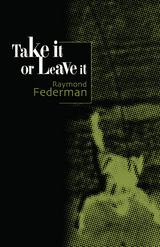 Take It or Leave It
Raymond Federman
University of Alabama Press, 1976 As told, or rather retold second-hand, by the narrator, Take It or Leave It relates the hilarious and amorous adventures of a young Frenchman who has been drafted into the U.S. Army and is being shipped Overseas to fight in Korea. The obsessed narrator retells, as best as he can, what the young man supposedly told him as they sat under a tree. He recounts how the young man escaped German persecution during World War Two, how he came to America and struggled to survive before joining the "rah rah spitshine" 82nd Airborne Division, and how, because of a "typical Army goof," he must travel in an old beat-up Buick Special from Fort Bragg to Camp Drum to collect the money the Army owes him, before he can set out for "the great journey cross-country" to San Francisco where he will embark for Overseas.
Moving freely from past to present (and Vice Versa), and from place to place leap-frogging from digression to digression, Take It or Leave It explores new possibilities of narrative technique. Whie the story of Frenchy is being told, the narrator involves his listeners in digressive arguments about politics, sex, America, literature, laughter, death, and the telling of the story itself. Consequently, as this "exaggerated second-hand tale to be read aloud either standing or sitting" progresses, it also deviates from its course, and eventually cancels itself as the voices of the fiction multiply. Take It or Leave It, the ultimate postmodern novel, makes a shamble of traditional fiction and conventional modes of writing, and does so with effrontery and laughter.
 Take Me to My Paradise: Tourism and Nationalism in the British Virgin Islands
Cohen, Colleen B
Rutgers University Press, 2010 The British Virgin Islands (BVI) markets itself to international visitors as a paradise. But just whose paradise is it? Colleen Ballerino Cohen looks at the many players in the BVI tourism culture, from the tourists who leave their graffiti at beach bars that are popularized in song, to the waiters who serve them and the singers who entertain them.
Interweaving more than twenty years of field notes, Cohen provides a firsthand analysis of how tourism transformed the BVI from a small neglected British colony to a modern nation that competes in a global economic market. With its close reading of everything from advertisements to political manifestos and constitutional reforms, Take Me to My Paradise deepens our understanding of how nationalism develops hand-in-hand with tourism, and documents the uneven impact of economic prosperity upon different populations. We hear multiple voices, including immigrants working in a tourism economy, nationalists struggling to maintain some control, and the anthropologist trying to make sense of it all. The result is a richly detailed and accessible ethnography on the impact of tourism on a country that came into being as a tourist destination.
Take Me to Stavanger: Poems
Anzhelina Polonskaya
University of Pittsburgh Press, 2023 A Bilingual Collection of Poems for a Dispirited Society
Amid the din of Russia’s patriotic sentiments and Instagram instants, is there any room left for the voice of a poet? Despite the many entertainments and distractions of modern life, Anzhelina Polonskaya’s spare but cutting poems in Take Me to Stavanger declare a wholehearted “Yes.” This bilingual Russian-English volume makes a refuge for the poet and her readers, plumbing the depths of contemporary melancholy and ennui. Beautifully crafted idiosyncratic dissections of a strong individual who refuses to go along with the currents of popular culture or political jingoism invite readers to slow down and pay attention.
Take Me with You, Wherever You're Going
Jessica Jacobs
Four Way Books, 2019 A memoir-in-poems about coming of age in sultry Florida and navigating a complex lesbian relationship grounded in the daily world.
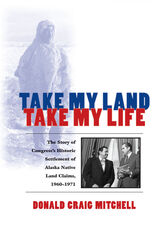 Take My Land, Take My Life: The Story of Congress's Historic Settlement of Alaska Native Land Claims 1960-1971
Donald Craig Mitchell
University of Alaska Press, 2001 In Take My Land, Take My Life, Mitchell concludes the story of the 134-year history of the U.S. government's relations with Alaska's Native people begun in Sold American:The Story of Alaska Natives and Their Land, 1867-1959. The culmination of that tale occurred in 1971 when Congress enacted the Alaska Native Claims Settlement Act. ANCSA authorized Alaska Natives to be paid $962.5 million and to be conveyed title to 44 million acres of land. Though highly controversial, ANCSA remains the most generous settlement of aboriginal land claims in the nation's history. Mitchell's insightful, exhaustively researched work also describes the political history during the first decade of Alaska statehood, from the rise of Native organizations such as the Alaska Federation of Natives to the battles for power in the subcommittees of Congress. Insightful and drawn from years of painstaking research of primary source materials, Sold American and Take My Land, Take My Life are an indispensable resource for readers who are interested in the history of the nation's largest state and of the federal government's involvement with Alaska's indigenous peoples.
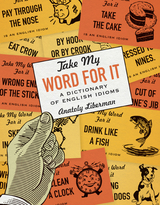 Take My Word for It: A Dictionary of English Idioms
Anatoly Liberman
University of Minnesota Press, 2022 Three centuries of English idioms—their unusual origins and unexpected interpretations
To pay through the nose. Raining cats and dogs. By hook or by crook. Curry favor. Drink like a fish. Eat crow. We hear such phrases every day, but this book is the first truly all-encompassing etymological guide to both their meanings and origins. Spanning more than three centuries, Take My Word for It is a fascinating, one-of-a-kind window into the surprisingly short history of idioms in English. Widely known for his studies of word origins, Anatoly Liberman explains more than one thousand idioms, both popular and obscure, occurring in both American and British standard English and including many regional expressions. The origins, and even the precise meaning, of most idioms are often obscure and lost in history. Based on a critical analysis of countless conjectures, with exact, in-depth references (rare in the literature on the subject), Take My Word for It provides not only a large corpus of idiomatic phrases but also a vast bibliography. Detailed indexes and a thesaurus make the content accessible at a glance, and Liberman’s introduction and conclusion add historical dimensions. The result of decades of research by a leading authority, this book is both instructive and absorbing for scholars and general readers, who won’t find another resource as comparable in scope or based on data even remotely as exhaustive.
Take Nothing With You
Sarah V. Schweig
University of Iowa Press, 2016 There are worlds we can imagine, but we live in this one: contingent and absurd. In her first full-length collection, Sarah V. Schweig aims to capture something essential and universal about this faulted inheritance.
These poems operate on the notion that the lyric can be discovered in scattered headlines, office-wide emails, road signs—the detritus of the everyday. But a poem doesn’t stop at found fragments; it creates something from them. These poems question and re-question what can be truthfully said, rediscovering the lyric in the very process of thinking, revising, and re-envisioning.
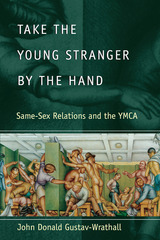 Take the Young Stranger by the Hand: Same-Sex Relations and the YMCA
John Donald Gustav-Wrathall
University of Chicago Press, 1998 Now associated with family health clubs, the YMCA's bland image is the result of relentless outreach and the studied avoidance of controversy. But, as John Gustav-Wrathall shows in his revealing social history of the organization, the life of the YMCA has been filled with strife, tragedy, and irony, a life that itself reflects the struggle over the shifting societal mores regarding masculine friendship and intimacy. Take the Young Stranger by the Hand presents the YMCA as an institution of profound contradictions, reflective of society's views of same-sex love and sexuality.
"Gustav-Wrathall's book offers an in-depth history of the origins and purposes of the Young Men's Christian Association and how it evolved into—and out of—a gay playland."—Arnie Kantrowitz, Lambda Book Report
"The book's absorbing exploration of the sometimes schismatic, sometimes synergistic relationship between spirituality and sexuality is a fascinating addition to the growing body of social history."—Jim Van Buskirk, San Francisco Bay Guardian
Take Two: Adapting the Contemporary American Novel to Film
Barbara Tepa Lupack
University of Wisconsin Press, 1994 From Edwin S. Porter to Mike Nichols, from D. W. Griffith to Steven Spielberg, American filmmakers have looked to the novel for story ideas.
Different in its complexities from the classic novels of Dickens, London, and Tolstoy to which earlier filmmakers turned, the contemporary American novel poses a real challenge to the filmmaker, who must translate its occasionally unfilmable essence for a new audience. Take Two closely analyzes the adaptations of ten such works: Catch-22, One Flew over the Cuckoo's Nest, Slaughterhouse-Five, Being There, The World According to Garp, Sophie’s Choice, The Color Purple, Ironweed, Tough Guys Don't Dance, and Billy Bathgate.
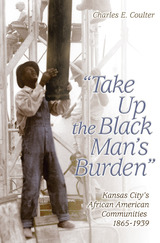 Take Up the Black Man's Burden: Kansas City's African American Communities, 1865-1939
Charles E. Coulter
University of Missouri Press, 2006 Unlike many cities farther north, Kansas City, Missouri—along with its sister city in Kansas—had a significant African American population by the midnineteenth century and also served as a way station for those migrating north or west. “Take Up the Black Man’s Burden” focuses on the people and institutions that shaped the city’s black communities from the end of the Civil War until the outbreak of World War II, blending rich historical research with first-person accounts that allow participants in this historical drama to tell their own stories of struggle and accomplishment.
Charles E. Coulter opens up the world of the African American community in its formative years, making creative use of such sources as census data, black newspapers, and Urban League records. His account covers social interaction, employment, cultural institutions, housing, and everyday lives within the context of Kansas City’s overall development, placing a special emphasis on the years 1919 to 1939 to probe the harsh reality of the Depression for Kansas City blacks—a time when many of the community’s major players also rose to prominence.
“Take Up the Black Man’s Burden” is a rich testament not only of high-profile individuals such as publisher Chester A. Franklin, activists Ida M. Becks and Josephine Silone Yates, and state legislator L. Amasa Knox but also of ordinary laborers in the stockyards, domestics in white homes, and railroad porters. It tells how various elements of the population worked together to build schools, churches, social clubs, hospitals, the Paseo YMCA/YWCA, and other institutions that made African American life richer. It also documents the place of jazz and baseball, for which the community was so well known, as well as movie houses, amusement parks, and other forms of leisure. While recognizing that segregation and discrimination shaped their reality, Coulter moves beyond race relations to emphasize the enabling aspects of African Americans’ lives and show how people defined and created their world. As the first extensive treatment of black history in Kansas City, “Take Up the Black Man’s Burden” is an exceptional account of minority achievement in America’s crossroads. By showing how African Americans saw themselves in their own world, it gives readers a genuine feel for the richness of black life during the interwar years of the twentieth century.
 Taken by Design: Photographs from the Institute of Design, 1937-1971
Edited by David Travis and Elizabeth Siegel
University of Chicago Press, 2002 One of Chicago's great cultural achievements, the Institute of Design was among the most important schools of photography in twentieth-century America. It began as an outpost of experimental Bauhaus education and was home to an astonishing group of influential teachers and students, including Lázló Moholy-Nagy, Harry Callahan, and Aaron Siskind. To date, however, the ID's enormous contributions to the art and practice of photography have gone largely unexplored. Taken by Design is the first publication to examine thoroughly this remarkable institution and its lasting impact.
With nearly 300 illustrations, including many never-before published photographs, Taken by Design examines the changing nature of photography over this critical period in America's midcentury. It starts by documenting the experimental nature of Moholy's Bauhaus approach and photography's new and enhanced role in training the "complete designer." Next it traces the formal and abstract camera experiments under Harry Callahan and Aaron Siskind, which aimed at achieving a new kind of photographic subjectivity. Finally, it highlights the ID's focus on conscious references to the processes of the photographic medium itself. In addition to photographs by Moholy, Callahan, and Siskind, the book showcases works by Barbara Crane, Yasuhiro Ishimoto, Joseph Jachna, Kenneth Josephson, Gyorgy Kepes, Nathan Lerner, Ray K. Metzker, Richard Nickel, Arthur Siegel, Art Sinsabaugh, and many others. Major essays from experts in the field, biographies, a chronology, and reprints of critical essays are also included, making Taken by Design an essential work for anyone interested in the history of American photography.
Contributors include:
Keith Davis, Lloyd Engelbrecht, John Grimes, Nathan Lyons, Hattula Moholy-Nagy, Elizabeth Siegel, David Travis, Larry Viskochil, James N. Wood
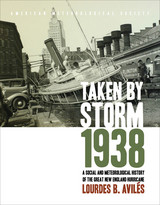 Taken by Storm, 1938: A Social and Meteorological History of the Great New England Hurricane
Lourdes B. Avilés
American Meteorological Society, 2013 On September 21, 1938 one of the most powerful storms of the twentieth century came unannounced into the lives of New Yorkers and New Englanders, leaving utter devastation in its wake. The Great Hurricane, as it came to be known, changed everything, from the landscape and its inhabitants’ lives, to Weather Bureau practices, to the measure and kind of relief New Englanders would receive during the Great Depression and the resulting pace of regional economic recovery.
The storm formed near the Cape Verde Islands on September 10 but was not spotted until several days later, and was predicted by the understaffed Weather Bureau to head toward Florida. Junior forecaster Charlie Pierce correctly projected the northerly storm track, but senior meteorologists ignored his forecast, a mistake that cost many lives—including those of immigrants who had arrived to the Northeast in waves in the preceding decades. To be published on the storm’s 75th anniversary, this compelling history successfully weaves science, historical accounts, and social analyses to create a comprehensive picture of the most powerful and devastating hurricane to hit New England to date.
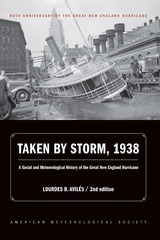 Taken by Storm, 1938: A Social and Meteorological History of the Great New England Hurricane
Lourdes B. Avilés
American Meteorological Society, 2018 On September 21, 1938, one of the most powerful storms of the twentieth century came unannounced into the lives of New Yorkers and New Englanders, leaving utter devastation in its wake. The Great Hurricane, as it came to be known, changed everything from the landscape and its inhabitants’ lives, to Weather Bureau practices and the measure of relief New Englanders would receive in the final years of the Great Depression.
The storm formed near the Cape Verde Islands on September 10, but was not spotted until several days later, and was predicted by the understaffed Weather Bureau to head toward Florida. Junior forecaster Charlie Pierce correctly projected the northerly storm track, but senior meteorologists ignored his forecast, a mistake that cost many lives—including those of immigrants who had arrived to the Northeast in waves in the preceding decades. Updated for the 80th anniversary of the hurricane, this compelling history successfully weaves science, historical accounts, and social analyses to create a comprehensive picture of the most powerful and devastating hurricane to hit New England to date.
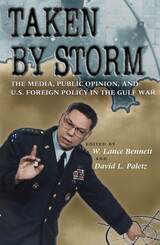 Taken by Storm: The Media, Public Opinion, and U.S. Foreign Policy in the Gulf War
Edited by W. Lance Bennett and David L. Paletz
University of Chicago Press, 1994 In the most comprehensive study of the media and foreign policy, twenty distinguished scholars and analysts explain the role played by the mass media and public opinion in the development of United States foreign policy in the Gulf War.
Tracing the flow of news, public opinion, and policy decisions from Sadam Hussein's rise to power in 1979, to the Iraqi invasion of Kuwait, through the outbreak and conclusion of the war, the contributors look at how the media have become key players in the foreign policy process. They examine the pre-war media debate, news coverage during and after the war, how the news-gathering process shaped the content of the coverage, and the media's effect on public opinion and decision makers. We see what goes on behind the scenes in the high tech world of political communication, and are confronted by troubling questions about the ways the government managed coverage of the war and captured journalists at their own news game.
Taken by Storm also examines more general patterns in post-Cold war journalism and foreign policy, particularly how contemporary journalistic practices determine whose voices and what views are heard in foreign policy coverage. At stake are the reactions of a vast media audience and the decision of government officials who see both the press and the public and key elements of the policy game.
The first book to fully integrate our understanding of the news business, public opinion, and government action, Taken by Storm transcends the limits of the Gulf War to illuminate the complex relationship between the media, the public, and U.S. foreign policy in the late twentieth century.
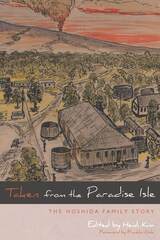 Taken from the Paradise Isle: The Hoshida Family Story
Heidi Kim
University Press of Colorado, 2015 Crafted from George Hoshida’s diary and memoir, as well as letters faithfully exchanged with his wife Tamae, Taken from the Paradise Isle is an intimate account of the anger, resignation, philosophy, optimism, and love with which the Hoshida family endured their separation and incarceration during World War II.
George and Tamae Hoshida and their children were a Japanese American family who lived in Hawai‘i. In 1942, George was arrested as a “potentially dangerous alien” and interned in a series of camps over the next two years. Meanwhile, forced to leave her handicapped eldest daughter behind in a nursing home in Hawai‘i, Tamae and three daughters, including a newborn, were incarcerated at the Jerome Relocation Center in Arkansas. George and Tamae regularly exchanged letters during this time, and George maintained a diary including personal thoughts, watercolors, and sketches. In Taken from the Paradise Isle these sources are bolstered by extensive archival documents and editor Heidi Kim’s historical contextualization, providing a new and important perspective on the tragedy of the incarceration as it affected Japanese American families in Hawai‘i.
This personal narrative of the Japanese American experience adds to the growing testimony of memoirs and oral histories that illuminate the emotional, psychological, physical, and economic toll suffered by Nikkei as the result of the violation of their civil rights during World War II.
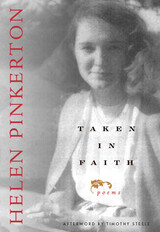 Taken In Faith: Poems
Helen Pinkerton
Ohio University Press, 2002 In 1967, Yvor Winters wrote of Helen Pinkerton, “she is a master of poetic style and of her material. No poet in English writes with more authority.” Unfortunately, in 1967 mastery of poetic style was not, by and large, considered a virtue, and Pinkerton’s finely crafted poems were neglected in favor of more improvisational and flashier talents. Though her work won the attention and praise of serious readers, who tracked her poems as they appeared in such journals as The Paris Review, The Sewanee Review, and The Southern Review, her verse has never been available in a trade book. Taken in Faith remedies that situation, bringing Pinkerton’s remarkable poems to a general audience for the first time. Even her very earliest works embody a rare depth and seriousness. Primarily lyrical and devotional, they always touch on larger issues of human struggle and conduct. More recent poems, concerned in part with history, exhibit a stylistic as well as a thematic shift, moving away from the rhymed forms of her devotional works into a blank verse marked by a quiet flexibility and contemplative grace. Like Virginia Adair, another poet who waited long for proper recognition, Pinkerton speaks as a woman who has lived fully and observed acutely and who has set the life and observations down in memorable verse. Taken in Faith represents a half-century of her poetic efforts.
Taken Somehow By Surprise
David Clewell
University of Wisconsin Press, 2011 David Clewell’s spirited poems cut through the noise we too often accommodate in our daily lives. Breath by surprising breath, this poet takes us into chambers of the heart that have never been mapped quite this way before. By turns raucous and strangely soothing, narrative and lyrical, Clewell traffics in unlikely and compelling details of our mostly discernible world: a school custodian’s role in the burgeoning Space Race, the vastness of abandoned missile silos, the first lawn flamingos, and the living fossil still using a typewriter.
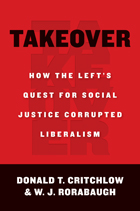 Takeover: How the Left's Quest for Social Justice Corrupted Liberalism
Donald T. Critchlow
Intercollegiate Studies Institute, 2012
How did liberals get to be the way they are today?
That’s the question many Americans have been asking—particularly after the ascent of Barack Obama, the most left-wing president in American history. At last, historians Donald T. Critchlow and W. J. Rorabaugh supply the answer.
The authors show that it is a mistake to see the Obama administration’s sweeping agenda as a single man’s vision. Equally flawed, they reveal, is the now-common argument that today’s liberalism is simply a continuation of the progressivism that Woodrow Wilson embodied a century ago. Today’s Left has embraced a more radical vision for transformative change: to remake nearly every aspect of American life.
Takeover completely reshapes our understanding of America’s current political situation. This bold revisionist history delineates the sharp break in the history of modern liberalism that began in the 1960s, when new-style progressive activists left behind their protest rallies to infiltrate the establishment.
Critchlow and Rorabaugh reveal:
•How Obama almost certainly could not have become president if 1970s progressive activists had not rewritten the Democratic Party’s presidential nominating rules
•How radical leaders pioneered the use of the courts to impose their agenda
•From Roe v. Wade to Dr. Kevorkian: how partial-birth abortion became “the right to choose” and euthanasia became “the right to die with dignity”
•The inside story of liberals’ decades-long struggle to nationalize health care
•How today’s environmentalism reflects the Left’s anticorporate, anticonsumption ethos
•The progressive paradox: how elites gain more control even as they employ the rhetoric of “choice” and “power to the people”
Critchlow and Rorabaugh masterfully connect the dots in America’s recent history, showing the close links among such seemingly unrelated causes as radical environmentalism, nationalized health care, class warfare, abortion rights, feminism, caps on energy use, assisted suicide, and sex education. Takeover will forever change how you view liberalism and the political debate in America.
 Taking Advance Directives Seriously: Prospective Autonomy and Decisions Near the End of Life
Robert S. Olick
Georgetown University Press, 2001 In the quarter century since the landmark Karen Ann Quinlan case, an ethical, legal, and societal consensus supporting patients' rights to refuse life-sustaining treatment has become a cornerstone of bioethics. Patients now legally can write advance directives to govern their treatment decisions at a time of future incapacity, yet in clinical practice their wishes often are ignored. Examining the tension between incompetent patients' prior wishes and their current best interests as well as other challenges to advance directives, Robert S. Olick offers a comprehensive argument for favoring advance instructions during the dying process. He clarifies widespread confusion about the moral and legal weight of advance directives, and he prescribes changes in law, policy, and practice that would not only ensure that directives count in the care of the dying but also would define narrow instances when directives should not be followed. Olick also presents and develops an original theory of prospective autonomy that recasts and strengthens patient and family control. While focusing largely on philosophical issues the book devotes substantial attention to legal and policy questions and includes case studies throughout. An important resource for medical ethicists, lawyers, physicians, nurses, health care professionals, and patients' rights advocates, it champions the practical, ethical, and humane duty of taking advance directives seriously where it matters most-at the bedside of dying patients.
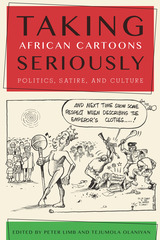 Taking African Cartoons Seriously: Politics, Satire, and Culture
Peter Limb
Michigan State University Press, 2018 Cartoonists make us laugh—and think—by caricaturing daily events and politics. The essays, interviews, and cartoons presented in this innovative book vividly demonstrate the rich diversity of cartooning across Africa and highlight issues facing its cartoonists today, such as sociopolitical trends, censorship, and use of new technologies. Celebrated African cartoonists including Zapiro of South Africa, Gado of Kenya, and Asukwo of Nigeria join top scholars and a new generation of scholar-cartoonists from the fields of literature, comic studies and fine arts, animation studies, social sciences, and history to take the analysis of African cartooning forward. Taking African Cartoons Seriously presents critical thematic studies to chart new approaches to how African cartoonists trade in fun, irony, and satire. The book brings together the traditional press editorial cartoon with rapidly diverging subgenres of the art in the graphic novel and animation, and applications on social media. Interviews with bold and successful cartoonists provide insights into their work, their humor, and the dilemmas they face. This book will delight and inform readers from all backgrounds, providing a highly readable and visual introduction to key cartoonists and styles, as well as critical engagement with current themes to show where African political cartooning is going and why.
 Taking Aim: Target Populations and the Wars on AIDS and Drugs
Mark C. Donovan
Georgetown University Press, 2001 As elected lawmakers confront complex social problems, they inevitably make choices to single out certain populations for government-sanctioned benefits or burdens. Why some groups and not others are targeted is the central question explored in this analysis of the congressional response to two related public health crises. Weaving case studies from the wars against AIDS and drugs with an empirical analysis of fifteen years of congressional action on these issues, Mark Donovan shows how members of Congress balance problem solving with re-election concerns, paying particular attention to their need to craft compelling rationales for their actions. His analysis shows that, counterintuitive as it may seem, most target populations with negative public images are selected to receive benefits rather than burdens. Demonstrating that it is possible to analyze simultaneously both policy rhetoric and policy outputs, this book shows how problem frames and policy decisions evolve through the dynamic interplay of conflict participants.
Taking Back Eden: Eight Environmental Cases that Changed the World
Oliver A. Houck
Island Press, 2010 Taking Back Eden is a set of case studies of environmental lawsuits brought in eight countries around the world, including the U.S, beginning in the 1960s. The book conveys what is in fact a revolution in the field of law: ordinary citizens (and lawyers) using their standing as citizens in challenging corporate practices and government policies to change not just the way the environment is defended but the way that the public interest is recognized in law. Oliver Houck, a well-known environmental attorney, professor of law, and extraordinary storyteller, vividly depicts the places protected, as well as the litigants who pursued the cases, their strategies, and the judges and other government officials who ruled on them. This book will appeal to upperclass undergraduates, graduate students, and to all citizens interested in protecting the environment.
 Taking Books to the World: American Publishers and the Cultural Cold War
Amanda Laugesen
University of Massachusetts Press, 2017 Franklin Publications, or Franklin Book Programs, was started in 1952 as a form of cultural diplomacy. Until it folded in the 1970s, Franklin translated, printed, and distributed American books around the world, with offices in Egypt, Indonesia, Iran, Nigeria, Afghanistan, and Pakistan. Although it was a private firm, Franklin received funding from the United States Information Agency. This was an ambitious and idealistic postwar effort that ultimately became the victim of shifting politics.
In Taking Books to the World, Amanda Laugesen tells the story of this purposeful enterprise, demonstrating the mix of goodwill and political drive behind its efforts to create modern book industries in developing countries. Examining the project through a clarifying lens, she reveals the ways Franklin's work aligned with cultural currents, exposing the imperial beliefs, charitable hopes, and intellectual reasoning behind this global experiment.
Taking Care of Time
Cortney Davis
Michigan State University Press, 2018 For poet and nurse practitioner Cortney Davis, the truth revealed through poetry is similar to what she has experienced in the heightened and urgent dramas that occur in health care—those suspended moments in which a dying heart might be revived or unbearable suffering relieved. We are vulnerable, her poems say, and we are dependent on one another—on the ways in which we care or fail to care for one another, in how we love or fail to love. In poems that are sensual, emotionally searing, and yet unfailingly tender, Davis shines a caregiver’s light on the most intimate details of the human body and the spirit within—how the flesh might betray, how it endures, and how ultimately it triumphs.
 Taking Chances: The Coast after Hurricane Sandy
O'Neill, Karen M.
Rutgers University Press, 2016 Humanity is deeply committed to living along the world’s shores, but a catastrophic storm like Sandy—which took hundreds of lives and caused many billions of dollars in damages—shines a bright light at how costly and vulnerable life on a shoreline can be. Taking Chances offers a wide-ranging exploration of the diverse challenges of Sandy and asks if this massive event will really change how coastal living and development is managed. Bringing together leading researchers—including biologists, urban planners, utilities experts, and climatologists, among others—Taking Chances illuminates reactions to the dangers revealed by Sandy. Focusing on New Jersey, New York, and other hard-hit areas, the contributors explore whether Hurricane Sandy has indeed transformed our perceptions of coastal hazards, if we have made radically new plans in response to Sandy, and what we think should be done over the long run to improve coastal resilience. Surprisingly, one essay notes that while a large majority of New Jerseyans identified Sandy with climate change and favored carefully assessing the likelihood of damage from future storms before rebuilding the Shore, their political leaders quickly poured millions into reconstruction. Indeed, much here is disquieting. One contributor points out that investors scared off from further investments on the shore are quickly replaced by new investors, sustaining or increasing the overall human exposure to risk. Likewise, a study of the Gowanus Canal area of Brooklyn shows that, even after Sandy swamped the area with toxic flood waters, plans to convert abandoned industrial lots around the canal into high-density condominiums went on undeterred. By contrast, utilities, emergency officials, and others who routinely make long-term plans have changed operations in response to the storm, and provide examples of adaptation in the face of climate change. Will Sandy be a tipping point in coastal policy debates—or simply dismissed as a once-in-a-century anomaly? This thought-provoking collection of essays in Taking Chances makes an important contribution to this debate.
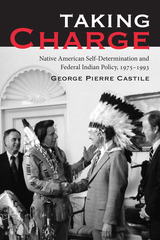 Taking Charge: Native American Self-Determination and Federal Indian Policy, 1975–1993
George Pierre Castile
University of Arizona Press, 2006 The Indian Self-Determination Act of 1975 sought to restore self-government to peoples whose community affairs had long been administered by outsiders. This book explores whether that bold ambition was actually realized. Taking Charge is a sequel to the author’s landmark work To Show Heart, which examined Indian policy through 1975. George Castile now explores federal Indian policy in the Carter, Reagan, and first Bush administrations, tracing developments triggered by executive and congressional action—or inaction—and focusing on the dynamics of self-determination as both policy objective and byword in the wake of the landmark 1975 legislation. Drawing on unpublished presidential papers and other archival sources, Castile chronicles the efforts of three presidents to uphold Richard Nixon’s commitment to policy change, weighing such issues as the impact of Reaganomics and the advent of Indian gaming. He examines the marginalizing of Indian policy in both the executive and legislative branches in the face of larger issues, as well as the recurring tendency of policy to be driven by a single determined individual, such as South Dakota senator James Abourezk. Although self-determination is roundly advocated by all concerned with federal Indian policy, until now no book has provided a grasp of both its background and its implications. Taking Charge is an essential contribution to the critical study of that policy that allows a better understanding of contemporary Indian affairs.
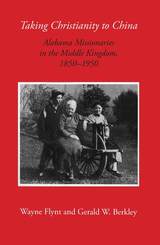 Taking Christianity to China: Alabama Missionaries in the Middle Kingdom, 1850–1950
Wayne Flynt and Gerald W. Berkley
University of Alabama Press, 2017 Beginning early in the 19th century, the American missionary movement made slow headway in China. Alabamians became part of that small beachhead. After 1900 both the money and personnel rapidly expanded, peaking in the early 1920s. By the 1930s many American denominations became confused and divided over the appropriateness of the missionary endeavor. Secular American intellectuals began to criticize missionaries as meddling do-gooders trying to impose American Evangelicalism on a proud, ancient culture.
By examining the lives of 47 Alabama missionaries who served in China between 1850 and 1950, Flynt and Berkley reach a different conclusion. Although Alabama missionaries initially fit the negative description of Americans trying to superimpose their own values and beliefs on "heathen," they quickly learned to respect Chinese civilization. The result was a new synthesis, neither entirely southern nor entirely Chinese. Although previous works focus on the failure of Christianity to change China, this book focuses on the degree to which their service in China changed Alabama missionaries. And the change was profound.
In their consideration of 47 missionaries from a single state--their call to missions, preparation for service in China, living, working, contacts back home, cultural clashes, political views, internal conflicts, and gender relations--the authors suggest that the efforts by Baptist, Methodist, and Presbyterian missionaries from Alabama were not the failure judged by many historians. In fact, the seeds sown in the hundred years before the Communist revolution in 1950 seem to be reaping a rich harvest in the declining years of the 20th century, when the number of Chinese Christians is estimated by some to be as high as one hundred million.
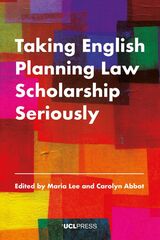 Taking English Planning Law Scholarship Seriously
Edited by Maria Lee and Carolyn Abbot
University College London, 2022 Insight into planning law and its place within broader institutional and legal frameworks.
Planning is at the heart of the response to many of the significant challenges of our time, from the climate and environmental crises to social and economic inequalities. It is embedded in, as well as partially constituting, our democratic systems, so that the challenges of democratic decision-making in a complex society cannot be avoided when thinking about planning. Planning law raises some of the most fundamental questions faced by legal scholars, from the legitimacy of authority to the relationship between public and private rights and interests. And yet, planning law has been relatively neglected by legal scholars. This book helps rectify that by showcasing planning law scholarship in all of its variety and complexity. The chapters reflect this by covering a range of the objects of planning (from housing to energy to highways) and a multiplicity of planning tasks and tools (from compulsory purchase to contracting to planning inquiries).
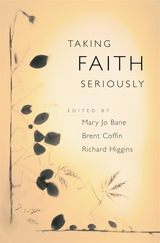 Taking Faith Seriously
Mary Jo Bane
Harvard University Press, 2005 Whether simply uneasy or downright hostile, the relation between religion and liberal democracy in this country has long been vexed and complex--and crucial to what America is and aspires to be. Amid increasingly contentious exchanges over fundamentalism, abortion rights, secularism, and pluralism, this book reminds us of the critical role that religion plays in the health and well-being of a democracy.
A healthy democracy draws strength from a rich civic and social life, many forms of which are religious. Moreover, these contributions are anchored in the intrinsic commitments of faith, commitments that extend over time, linking generations past and present. Strengthening these commitments and practices, the authors suggest, will also fortify pluralistic civil society and democratic participation. Their book provides the analytical tools and historical perspective for building and reinforcing such a constructive engagement between religion and liberal democracy--and for understanding the ongoing dialogue between secular political philosophy and communities of faith.
Taking Faith Seriously offers nine case studies that describe the multiple and subtle roles that religion plays on many levels in our civic life: increasing moral and social "capital," inspiring citizens to serve their neighbors, building relationships across barriers of race and income, and providing a moral vision of what kind of society we are called to be.
 Taking Flight: A History of Birds and People in the Heart of America
Michael Edmonds
Wisconsin Historical Society Press, 2018 A dynamic account of ornithological history in America’s heartland.
Today, more than fifty million Americans traipse through wetlands at dawn, endure clouds of mosquitoes, and brave freezing autumn winds just to catch a glimpse of a bird. The human desire to connect with winged creatures defies age and generation. In the Midwest, humans and birds have lived together for more than twelve thousand years. Taking Flight explores how and why people have worshipped, feared, studied, hunted, eaten, and protected the birds that surrounded them.
Author and birder Michael Edmonds has combed archaeological reports, missionaries’ journals, travelers’ letters, early scientific treatises, the memoirs of American Indian elders, and the folklore of hunters, farmers, and formerly enslaved people throughout the Midwest to reveal how our ancestors thought about the very same birds we see today. Whether you’re a casual bird-watcher, a hard-core life-lister, or simply someone who loves the outdoors, you’ll look at birds differently after reading this book.
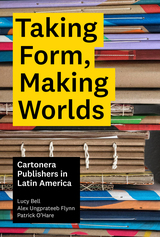 Taking Form, Making Worlds: Cartonera Publishers in Latin America
Lucy Bell, Alex Ungprateeb Flynn, Patrick O’Hare
University of Texas Press, 2022 2023 LASA Visual Culture Studies Section Book Prize, Latin American Studies Association (LASA)
The first comprehensive study of cartonera, a vibrant publishing phenomenon born in Latin America.
A publishing phenomenon and artistic project, cartonera was born in the wake of Argentina’s 2001 economic crisis. Infused with a rebellious spirit, it has exploded in popularity, with hundreds of publishers across Latin America and Europe making colorful, low-cost books out of cardboard salvaged from the street. Taking Form, Making Worlds is the first comprehensive study of cartonera. Drawing on interdisciplinary research conducted across Mexico, Brazil, and Argentina, the authors show how this hands-on practice has fostered a politically engaged network of writers, artists, and readers. More than a social movement, cartonera uses texts, workshops, encounters, and exhibitions to foster community and engagement through open-ended forms that are at once artistic and social. For various groups including waste-pickers, Indigenous communities, rural children, and imprisoned women, cartonera provides a platform for unique stories and sparks collaborations that bring the walls of the “lettered city” tumbling down. In contexts of stigma and exclusion, cartonera collectives give form to a decolonial aesthetics of resistance, making possible a space of creative experimentation through which plural worlds can be brought to life.
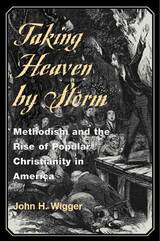 Taking Heaven by Storm: Methodism and the Rise of Popular Christianity in America
John H. Wigger
University of Illinois Press, 1998 In 1770 there were fewer than 1,000 Methodists in America. Fifty years later, the church counted more than 250,000 adherents. Identifying Methodism as America's most significant large-scale popular religious movement of the antebellum period, John H. Wigger reveals what made Methodism so attractive to post-revolutionary America.
Taking Heaven by Storm shows how Methodism fed into popular religious enthusiasm as well as the social and economic ambitions of the "middling people on the make"--skilled artisans, shopkeepers, small planters, petty merchants--who constituted its core. Wigger describes how the movement expanded its reach and fostered communal intimacy and "intemperate zeal" by means of an efficient system of itinerant and local preachers, class meetings, love feasts, quarterly meetings, and camp meetings. He also examines the important role of African Americans and women in early American Methodism and explains how the movement's willingness to accept impressions, dreams, and visions as evidence of the work and call of God circumvented conventional assumptions about education, social standing, gender, and race.
A pivotal text on the role of religion in American life, Taking Heaven by Storm shows how the enthusiastic, egalitarian, entrepreneurial, lay-oriented spirit of early American Methodism continues to shape popular religion today.
 Taking Her Seriously: Penelope and the Plot of Homer's Odyssey
Richard Heitman
University of Michigan Press, 2005 "[Heitman] provides a sensitive critical study of the Odyssey in which he strives to better appreciate the poem by focusing on the familial interactions in Ithaca . . . Heitman's interpretations . . . are unfailingly clear and thought-provoking. Highly recommended."
---Choice "It is an example of a neat and valuable contribution which is both intelligible to non-specialists and inspiring for psychologists and classicists. It demonstrates that research into Homer still is . . . capable of extracting ever-new exciting ideas from Homer's texts."
---Bryn Mawr Classical Review Taking Her Seriously is a reevaluation of Penelope, one of the most universally admired female characters in Western classical literature. Casting her in a new light, Richard Heitman emphasizes the courage, steadfastness, and integrity of this iconic figure while she faces potentially tragic decisions. Homer's treatment of events in Ithaca and the motivations of Penelope throughout the denser books of the Odyssey reveals a complicated, serious, independent, and insightful thinker whose actions are crucial to guaranteeing the well-being of her home and a safe future for her son, and for Odysseus as well. Through this thematic approach to the text, Penelope comes into focus as a loving wife whose role is far more important than passive fidelity to a wandering husband. Her integrity and wisdom in Odysseus' absence set the stage for his violent and triumphant return, and secure her place as a female role model in even the most modern of contexts. Richard Heitman is Assistant Professor of Classics and Philosophy at Carthage College.
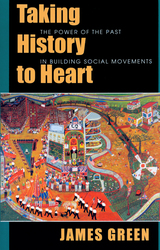 Taking History to Heart: The Power of the Past in Building Social Movements
James Green
University of Massachusetts Press, 2000 Deftly blending autobiography and history, James Green here reflects on thirty years as an activist, educator, and historian. He recounts how he became deeply immersed in political protest and in recovering and preserving the history of progressive social movements, and how the two are linked. His book, written in an engaging and accessible style, tells powerful stories of people in struggle, framed by the personal account of his own development. As a historian, Green gives voice to generations of Americans who banded together to fight for social justice. His subjects range from the martyrs of the Haymarket tragedy to the Bread and Roses strikers of 1912, from depression-era struggles for democracy to the civil rights crusaders, from recent Rainbow Coalition campaigns to the latest union organizing drives. As an activist, Green describes how his participation in the civil rights and labor movements of our own time has transformed his life, first as a student and radical scholar in the 1960s, then as a public historian and teacher of working-class students. He also describes his efforts to break free from academic confinement and "tell movement stories in public," in an attempt to offer hope and counsel to those still fighting for equality and fairness. He concludes with a revealing look at how awareness of past social activism has contributed to the revival of the labor movement during the last ten years, an effort in which Green has been vigorously engaged.
 Taking Issue: Pluralism and Casuistry in Bioethics
Baruch A. Brody
Georgetown University Press, 2003 A pioneer in the theory of pluralistic casuistry, the idea that there are almost as many facets to moral choices as there are cases that call for choices, Baruch Brody takes issue with conventional bioethical wisdom and challenges the rigid principalism of contemporary bioethics. His views have been seen as controversial, but they are firmly held, and convincingly argued—all of which have led him to be one of the most widely discussed and highly admired bioethicists of our time. He argues for the fundamental distinction between active and passive euthanasia, for a need to reconceptualize approaches to brain death, and for the right of providers to unilaterally discontinue life support. He shows support for the waiving of the requirement of informed consent for some research, for the widespread use of animals in research, and for the use of placebos in many international clinical trials. When it comes to morality as it is practiced in medicine, Brody makes clear that the ethical issues are never as simple as black and white—that there are myriad factors and fine nuances that can and should challenge decision making as it is commonly practiced in difficult medical cases. In this collection, delving thoughtfully and systematically into methodology, research ethics, clinical ethics, and Jewish medical ethics, he tackles thorny life-and-death questions head-on and fearlessly. He casts a light into all the corners of end-of-life decisions—a field in which he has exemplary credentials—while illuminating a new understanding of morality and ethics. The introduction outlines Brody's approach, defines the terminology used, and contrasts his ethical positions with much of the competing literature. Taking Issue will be invaluable to students and scholars in medical ethics, bioethics, and philosophy of medicine.
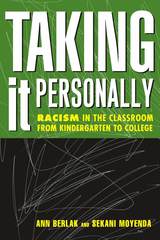 Taking It Personally: Racism In Classroom From Kinderg To College
Ann Berlak
Temple University Press, 2001 When Sekani Moyenda, an African American elementary school teacher, accepted an invitation to speak at a graduate education class, neither the students nor Ann Berlak, their professor, could guess that her presentation would spark an outpouring of emotion and a reexamination of race from everyone involved.
The "encounter" -- as it was called -- was an expression of Moyenda's anger at the institutionalized racism of our educational system, a system whose foundations are reinforced and whose assumptions about race are reproduced in the graduate school classroom. Forcing everyone involved to rethink their own race consciousness, Taking it Personally is a chronicle of two teachers and their own educational progress. In processing their own responses to the encounter, along with their students', Berlak and Moyenda meditate not only on their own ideas on teaching and learning, but also redefine the obligation a teacher has to his or her students.
Personal in its approach, yet grounded in significant currents of educational thought, Taking it Personally will be a must-read for any educator or educator-to-be who is committed to teaching in our diverse classrooms.
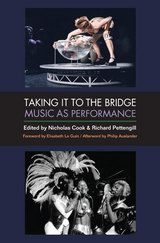 Taking It to the Bridge: Music as Performance
Nicholas Cook and Richard Pettengill
University of Michigan Press, 2013 The overriding aim of this groundbreaking volume—whether the subject is vocal ornamentation in 19th-century opera or the collective improvisation of the Grateful Dead—is to give new recognition to performance as the core of musical culture. The collection brings together renowned scholars from performance studies and musicology (including Philip Auslander, David Borgo, Daphne Brooks, Nicholas Cook, Maria Delgado, Susan Fast, Dana Gooley, Philip Gossett, Jason King, Elisabeth Le Guin, Aida Mbowa, Ingrid Monson, Roger Moseley, Richard Pettengill, Joseph Roach, and Margaret Savilonis), with the intent of sparking a productive new dialogue on music as performance. Taking It to the Bridge is on the one hand a series of in-depth studies of a broad range of performance artists and genres, and on the other a contribution to ongoing methodological developments within the study of music, with the goal of bridging the approaches of musicology and performance studies, to enable a close, interpretive listening that combines the best of each. At the same time, by juxtaposing musical genres that range from pop and soul to the classics, and from world music to games and web-mediated performances, Taking It to the Bridge provides an inventory of contrasted approaches to the study of performance and contributes to its developing centrality within music studies.
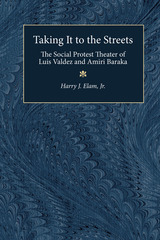 Taking It to the Streets: The Social Protest Theater of Luis Valdez and Amiri Baraka
Harry J. Elam, Jr.
University of Michigan Press, 2001 The performances of Luis Valdez's El Teatro Campesino, the farmworkers' theater, and Amiri Baraka's (LeRoi Jones's) Black Revolutionary Theater (BRT) during the 1960s and 1970s, offer preeminent examples of social protest theater during a momentous and tumultuous historical juncture. The performances of these groups linked the political, the cultural, and the spiritual, while agitating against the dominant power structure and for the transformation of social and theatrical practices in the U.S. Founded during the Delano Grape Pickers' Strike and Black Power rebellions of the mid-1960s, both El Teatro and the BRT professed cultural pride and group unity as critical corollaries to self-determination and revolutionary social action.
Taking It to the Streets compares the performance methodologies, theories, and practices of the two groups, highlighting their cross-cultural commonalties, and providing insights into the complex genre of social protest performance and its interchange with its audience. It examines the ways in which ritual can be seen to operate within the productions of El Teatro and the BRT, uniting audience and performers in subversive, celebratory protest by transforming spectators into active participants within the theater walls --and into revolutionary activists outside. During this critical historical period, these performances not only encouraged community empowerment, but they inculcated a spirit of collective faith and revolutionary optimism. Elam's critical reexamination and recontextualization of the ideologies and practices of El Teatro and the BRT aid in our understanding of contemporary manipulations of identity politics, as well as current strategies for racial representation and cultural resistance.
"A major contribution to our understanding of how social protest came to be so strong and how Black and Chicano theatre contributed to the synergy of those times." --Janelle Reinelt, University of California, Davis
Harry J. Elam, Jr., is Associate Professor of Drama and Director of the Committee on Black Performing Arts, Stanford University.
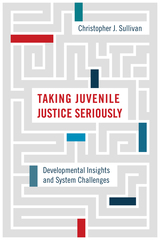 Taking Juvenile Justice Seriously: Developmental Insights and System Challenges
Christopher J. Sullivan
Temple University Press, 2019 The juvenile justice system navigates a high degree of variation in youthful offenders. While professionals with insights about reform and adolescent development consider the risks, the needs, and the patterns of delinquency of youth, too little attention is paid to the responses and practicalities of a system that is both complex and limited in its resources. In his essential book, Taking Juvenile Justice Seriously, Christopher Sullivan systematically analyzes key facets of justice-involved youth populations and parses cases to better understand core developmental influences that affect delinquency. He takes a comprehensive look at aspects of the life-course affected by juvenile justice as well as at the juvenile justice system’s operations and its multifaceted mission of delivering both treatment and sanctions to a varied population of youths. Taking Juvenile Justice Seriously first provides an overview of the youth who encounter the system, then describes its present operations and obstacles, synthesizes relevant developmental insights, and reviews current practices. Drawing on research, theory, and evidence regarding innovative policies, Sullivan offers a series of well-grounded recommendations that suggest how to potentially—and realistically—implement a more effective juvenile justice system that would benefit all.
 Taking Language Seriously: The Narrative Foundations of Public Administration Research
Jay D. White
Georgetown University Press The logic of research in public administration, argues Jay D. White, may be more like that of storytelling than of conventional social science research. In Taking Language Seriously, he examines the linguistic, discursive, and narrative foundations of public administration research and develops a narrative theory of knowledge development and use for the field. White builds his case for this narrative theory by showing how research on complex problems is grounded in language and discourse. He then explains how a variety of recent developments in philosophy and the humanities—positivism, postpositivism, hermeneutics, critical and legal theory, postmodernism, and poststructuralism—can contribute to our understanding of public administration research. Focusing on the logical structures of three modes of research—explanatory, interpretive, and critical—White shows how each is equally legitimate, depending on the nature of the research questions. This comprehensive yet clear discussion of the philosophical foundations of research in public administration advances an alternative theory of knowledge development that will be valuable for everyone in fields seeking to affect social, political, economic, and organizational change.
Taking Leave
Deborah Kapchan
Duke University Press, 2025 Deborah Kapchan’s Taking Leave is a lyrical memoir that encompasses journeys both inner and outer, physical and spiritual. Taking readers from New York, Paris, and Casablanca to Jerusalem and Abu Dhabi while exploring her Christian childhood, Jewish lineage, and the release she found in Islam, Kapchan examines the extent to which we can take leave of who we are to live between categories. She meditates on absence, presence, and the sublime to weave an existential tale that honors the three traditions that made her, ultimately desiring to take leave of them all. Taking Leave is an urgent plea for anti-tribalism and a timely treatise for compassionate coexistence in the spaces in-between.
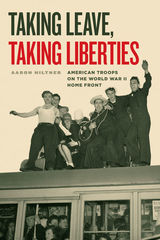 Taking Leave, Taking Liberties: American Troops on the World War II Home Front
Aaron Hiltner
University of Chicago Press, 2020 American soldiers overseas during World War II were famously said to be “overpaid, oversexed, and over here.” But the assaults, rapes, and other brutal acts didn’t only happen elsewhere, far away from a home front depicted as safe and unscathed by the “good war.” To the contrary, millions of American and Allied troops regularly poured into ports like New York and Los Angeles while on leave. Euphemistically called “friendly invasions,” these crowds of men then forced civilians to contend with the same kinds of crime and sexual assault unfolding in places like Britain, France, and Australia.
With unsettling clarity, Aaron Hiltner reveals what American troops really did on the home front. While GIs are imagined to have spent much of the war in Europe or the Pacific, before the run-up to D-Day in the spring of 1944 as many as 75% of soldiers were stationed in US port cities, including more than three million who moved through New York City. In these cities, largely uncontrolled soldiers sought and found alcohol and sex, and the civilians living there—women in particular—were not safe from the violence fomented by these de facto occupying armies. Troops brought their pocketbooks and demand for “dangerous fun” to both red-light districts and city centers, creating a new geography of vice that challenged local police, politicians, and civilians. Military authorities, focused above all else on the war effort, invoked written and unwritten legal codes to grant troops near immunity to civil policing and prosecution.
The dangerous reality of life on the home front was well known at the time—even if it has subsequently been buried beneath nostalgia for the “greatest generation.” Drawing on previously unseen military archival records, Hiltner recovers a mostly forgotten chapter of World War II history, demonstrating that the war’s ill effects were felt all over—including by those supposedly safe back home.
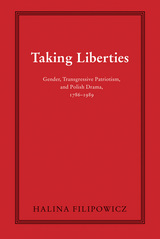 Taking Liberties: Gender, Transgressive Patriotism, and Polish Drama, 1786–1989
Halina Filipowicz
Ohio University Press, 2014 As narrow, nationalist views of patriotic allegiance have become widespread and are routinely invoked to justify everything from flag-waving triumphalism to xenophobic bigotry, the concept of a nonnationalist patriotism has vanished from public conversation. Taking Liberties is a study of what may be called patriotism without borders: a nonnational form of loyalty compatible with the universal principles and practices of democracy and human rights, respectful of ethnic and cultural diversity, and, overall, open-minded and inclusive.
Moving beyond a traditional study of Polish dramatic literature, Halina Filipowicz turns to the plays themselves and to archival materials, ranging from parliamentary speeches to polemical pamphlets and verse broadsides, to explore the cultural phenomenon of transgressive patriotism and its implications for society in the twenty-first century.
In addition to recovering lost or forgotten materials, the author builds an innovative conceptual and methodological framework to make sense of those materials. The result is not only a significant contribution to the debate over the meaning and practice of patriotism, but a masterful intellectual history.
The Taking of Ticonderoga in 1775: the British Story: A Study of Captors and Captives, Based upon Material Hitherto Unpublished
Allen French
Harvard University Press Fort Ticonderoga was taken from the British in May, 1775, and ever since there has been controversy as to certain of the events, particularly the services of Ethan Allen and Benedict Arnold. All these years there has remained, unsuspected, in the papers of Thomas Gage, commander-in-chief in America at that time, the detailed report of the officer who confronted Allen and Arnold on their entering the fort. The Gage papers, now owned by Lord Gage, were first opened to American students last summer; and Mr. French, the first to examine them, has used the British Ticonderoga report as a basis of a new study of the capture. Depending only on contemporary material, American as well as British, he gives the facts of the story as they will be accepted in the future.
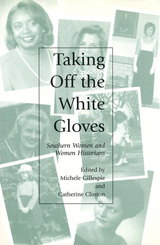 Taking Off the White Gloves: Southern Women and Women Historians
Edited & Intro by Michele Gillespie & Catherine Clinton
University of Missouri Press, 1998
When southern women remove their gloves, they speak their minds. The ten timely and provocative essays in Taking Off the White Gloves represent the collective wisdom of some of the finest scholars on women's history in the American South. On the eve of the thirtieth anniversary of the Southern Association for Women Historians, this volume brings together some of the outstanding lectures delivered by distinguished members of the association over the past fifteen years.
Spanning four centuries of women's experiences in the South, the topics featured in Taking Off the White Gloves range from Native American sexuality and European conquest to woman suffrage in the South, from black women's protest history to the status of women in the historical profession at the end of the twentieth century.
Despite diverse subject matter, these rich essays share a number of important qualities. They take an integrative approach, combining literary analysis, social history, cultural interpretation, labor history, popular culture, and oral history. Embracing the distinctiveness of the southern past and women's experiences within that past, they also recognize the inextricability of critical categories such as sexuality and gender, race and gender, and women and work. Finally, these essays emphasize the authors' commitment to the belief that the personal is political; they reveal the subtle and not so subtle ways that women transform theory into practice.
Taking Off the White Gloves invites a new understanding of the complexities that surround the history of southern women across race, class, place, and time. A model of innovative and imaginative scholarly historical writing, this book provides fertile ground for young scholars and is sure to inspire new research. This thought- provoking volume has much to offer scholars and students, as well as the general reader.
 Taking Place: Location and the Moving Image
John David Rhodes
University of Minnesota Press, 2011 Taking Place argues that the relation between geographical location and the moving image is fundamental and that place grounds our experience of film and media. Its original essays analyze film, television, video, and installation art from diverse national and transnational contexts to rethink both the study of moving images and the theorization of place. Through its unprecedented—and at times even obsessive— attention to actual places, this volume traces the tensions between the global and the local, the universal and the particular, that inhere in contemporary debates on global cinema, television, art, and media. Contributors: Rosalind Galt, U of Sussex; Frances Guerin, U of Kent; Ji-hoon Kim; Hugh S. Manon, Clark U; Ara Osterweil, McGill U; Brian Price, U of Toronto; Linda Robinson, U of Wisconsin–Whitewater; Michael Siegel; Noa Steimatsky, U of Chicago; Meghan Sutherland, U of Toronto; Mark W. Turner, Kings College London; Aurora Wallace, New York U; Charles Wolfe, U of California, Santa Barbara.
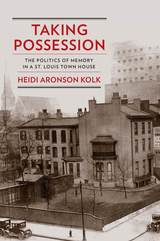 Taking Possession: The Politics of Memory in a St. Louis Town House
Heidi Aronson Kolk
University of Massachusetts Press, 2019 West of downtown St. Louis sits an 1851 town house that bears no obvious relationship to the monumental architecture, trendy condominiums, and sports stadia of its surroundings. Originally the residence of a fur-trade tycoon and now the Campbell House Museum, the house has been subject to energetic preservation and heritage work for some 130 years.
In Taking Possession, Heidi Aronson Kolk explores the complex and sometimes contradictory motivations for safeguarding the house as a site of public memory. Crafting narratives about the past that comforted business elites and white middle-class patrons, museum promoters assuaged concerns about the city's most pressing problems, including racial and economic inequality, segregation and privatization, and the legacies of violence for which St. Louis has been known since Ferguson. Kolk's case study illuminates the processes by which civic pride and cultural solidarity have been manufactured in a fragmented and turbulent city, showing how closely linked are acts of memory and forgetting, nostalgia and shame.
 Taking Rights Seriously: With a New Appendix, a Response to Critics
Ronald Dworkin
Harvard University Press, 1978 What is law? What is it for? How should judges decide novel cases when the statutes and earlier decisions provide no clear answer? Do judges make up new law in such cases, or is there some higher law in which they discover the correct answer? Must everyone always obey the law? If not, when is a citizen morally free to disobey?
A renowned philosopher enters the debate surrounding these questions. Clearly and forcefully, Ronald Dworkin argues against the “ruling” theory in Anglo-American law—legal positivism and economic utilitarianism—and asserts that individuals have legal rights beyond those explicitly laid down and that they have political and moral rights against the state that are prior to the welfare of the majority.
Mr. Dworkin criticizes in detail the legal positivists’ theory of legal rights, particularly H. L. A. Hart’s well-known version of it. He then develops a new theory of adjudication, and applies it to the central and politically important issue of cases in which the Supreme Court interprets and applies the Constitution. Through an analysis of John Rawls’s theory of justice, he argues that fundamental among political rights is the right of each individual to the equal respect and concern of those who govern him. He offers a theory of compliance with the law designed not simply to answer theoretical questions about civil disobedience, but to function as a guide for citizens and officials. Finally, Professor Dworkin considers the right to liberty, often thought to rival and even preempt the fundamental right to equality. He argues that distinct individual liberties do exist, but that they derive, not from some abstract right to liberty as such, but from the right to equal concern and respect itself. He thus denies that liberty and equality are conflicting ideals.
Ronald Dworkin’s theory of law and the moral conception of individual rights that underlies it have already made him one of the most influential philosophers working in this area. This is the first publication of these ideas in book form.
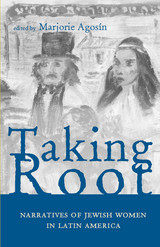 Taking Root: Narratives of Jewish Women in Latin America
Marjorie Agosín
Ohio University Press, 2002 In Taking Root, Latin American women of Jewish descent, from Mexico to Uruguay, recall their coming of age with Sabbath candles and Hebrew prayers, Ladino songs and merengue music, Queen Esther and the Virgin of Guadalupe. Rich and poor, Sephardi and Ashkenazi, Jewish immigrant families searched for a new home and identity in predominantly Catholic societies. The essays included here examine the religious, economic, social, and political choices these families have made and continue to make as they forge Jewish identities in the New World. Marjorie Agosín has gathered narratives and testimonies that reveal the immense diversity of Latin American Jewish experience. These essays, based on first- and second-generation immigrant experience, describe differing points of view and levels of involvement in Jewish tradition. In Taking Root, Agosín presents us with a contemporary and vivid account of the Jewish experience in Latin America. Taking Root documents the sadness of exile and loss but also a fierce determination to maintain Jewish traditions. This is Jewish history but it is also part of the untold history of Brazil, Argentina, El Salvador, Ecuador, Chile, Peru, and all of Latin America.
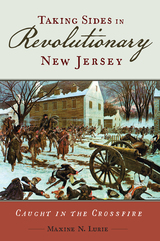 Taking Sides in Revolutionary New Jersey: Caught in the Crossfire
Maxine N. Lurie
Rutgers University Press, 2022 The American Revolution in New Jersey lasted eight long years, during which many were caught in the middle of a vicious civil war. Residents living in an active war zone took stands that varied from “Loyalist” to “Patriot” to neutral and/or "trimmer" (those who changed sides for a variety of reasons). Men and women, Blacks and whites, Native Americans, and those from a wide variety of ethnic backgrounds, with different religious affiliations all found themselves in this difficult middle ground. When taking sides, sometimes family was important, sometimes religion, or political principles; the course of the war and location also mattered. Lurie analyzes the difficulties faced by prisoners of war, the refugees produced by the conflict, and those Loyalists who remained, left as exiles, or surprisingly later returned. Their stories are interesting, often dramatic, and include examples of those literally caught in the crossfire. They illustrate the ways in which this was an extremely difficult time and place to live. In the end more of the war was fought in New Jersey than elsewhere, resulting in the highest number of casualties, and a great deal of physical damage. The costs were high no matter what side individuals took. Taking Sides uses numerous brief biographies to illustrate the American Revolution’s complexity; it quotes from documents, pamphlets, diaries, letters, and poetry, a variety of sources to provide insight into the thoughts and reactions of those living through it all. It focuses on people rather than battles and provides perspective for the difficult choices we make in our own times. Supplemental Instructor Resources for Taking Sides in Revolutionary New Jersey: Questions (https://d3tto5i5w9ogdd.cloudfront.net/wp-content/uploads/2022/07/19144155/Taking-Sides-Supplementary-Instructor-Resources-Questions.pdf) Bibliography (https://d3tto5i5w9ogdd.cloudfront.net/wp-content/uploads/2022/07/19144154/Taking-Sides-Supplementary-Instructor-Resources-Bibliography.pdf)
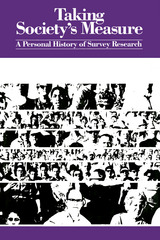 Taking Society's Measure: A Personal History of Survey Research
Herbert Hyman
Russell Sage Foundation, 1991 How are we, as members of a society, informed of conditions that affect our social welfare? How does the government register the impact of its actions on its citizens? The turbulent 1930s saw the emergence of sample survey research as an increasingly valuable technique of social inquiry. Perhaps no one championed this nascent discipline as vigorously as Herbert Hyman, one of those pioneering investigators whose talents were so closely associated with the rapid growth of survey research that their professional careers and reputations became virtually indistinguishable from the field itself. Hyman's personal account is a remarkable contribution to the history and sociology of social research. His experiences with the U.S. Department of Agriculture, the Office of War Information, the U.S. Bombing Surveys of Germany and Japan, the National Opinion Research Center, and the Bureau of Applied Social Research are all documented with fascinating insight into the critical events and prominent individuals that shaped the field of survey research between the late 1930s and the late 1950s.
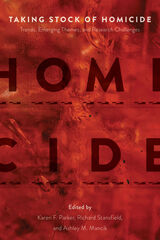 Taking Stock of Homicide: Trends, Emerging Themes, and Research Challenges
Edited by Karen F. Parker, Richard Stansfield, and Ashley M. Mancik
Temple University Press, 2024 Taking Stock of Homicide provides a critical look at homicide, offering a comprehensive review of the major areas of homicide research, including topics largely unexplored in the literature, such as qualitative and historical accounts.
Featuring leading scholars, this volume is organized around key themes and areas that reflect major contemporary trends and patterns in criminological literature. Chapters consider fundamentals such as data collection, sources, and histories; structural dynamics, including methodologies and fieldwork plus factors involving race and public health; the circumstances, types, and variations in homicide, from intimate partner violence to gangs, drugs, and firearms; as well as the prevention of and responses to homicide.
An essential state-of-the-discipline examination, Taking Stock of Homicide expands our knowledge while offering a toolkit for how to conduct future research on this serious, violent crime.
Contributors: Mark Berg, Laura Boisten, Anthony Braga, Fiona Brookman, Shytierra Gaston, Veronica Valencia Gonzalez, Elizabeth Griffiths, Chris Guerra, John Hipp, John Jarvis, Helen Jones, Sharon Jones-Eversley, Jungmyung Kim, Kenneth Land, Marieke Liem, Michael Light, Xiaoshuang Iris Luo, Amy Magnus, Patricia McCall, Erin Orrick, Alex Piquero, William Pridemore, David Pyrooz, Arnaldo Rabolini, Kasey Ragan, Wendy Regoeczi, Johnny Rice II, Jacqueline Rhoden-Trader, Ethan Rogers, Meghan Rodgers, Randolph Roth, Jose Antonio Sanchez, Daniel Semenza, James Tuttle, Jolien van Breen, Kirk Williams, and the editors
Taking Stock of the Profession & Teaching the Faerie Queen, Volume 3
Jennifer L. Holberg and Marcy Taylor, eds.
Duke University Press This issue fuses theoretical approaches and practical realities with its two featured symposiums of articles on Gerald Graff and teaching conflicts and on how to teach Spenser’s The Faerie Queene in a week.
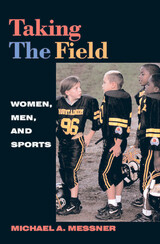 Taking The Field: Women, Men, and Sports
Michael A. Messner
University of Minnesota Press, 2002 In the past, when sport simply excluded girls, the equation of males with active athletic power and of females with weakness and passivity seemed to come easily, almost naturally. Now, however, with girls’ and women’s dramatic movement into sport, the process of exclusion has become a bit subtler, a bit more complicated-and yet, as Michael Messner shows us in this provocative book, no less effective. In Taking the Field, Messner argues that despite profound changes, the world of sport largely retains and continues its longtime conservative role in gender relations. To explore the current paradoxes of gender in sport, Messner identifies and investigates three levels at which the "center" of sport is constructed: the day-to-day practices of sport participants, the structured rules and hierarchies of sport institutions, and the dominant symbols and belief systems transmitted by the major sports media. Using these insights, he analyzes a moment of gender construction in the lives of four- and five-year-old children at a soccer opening ceremony, the way men’s violence is expressed through sport, the interplay of financial interests and dominant men’s investment in maintaining the status quo in the face of recent challenges, and the cultural imagery at the core of sport, particularly televised sports. Through these examinations Messner lays bare the practices and ideas that buttress-as well as those that seek to disrupt-the masculine center of sport. Taking the Field exposes the subtle and not-so-subtle ways in which men and women collectively construct gender through their interactions-interactions contextualized in the institutions and symbols of sport.
 Taking the Heat: Women Chefs and Gender Inequality in the Professional Kitchen
Harris, Deborah A
Rutgers University Press, 2015 A number of recent books, magazines, and television programs have emerged that promise to take viewers inside the exciting world of professional chefs. While media suggest that the occupation is undergoing a transformation, one thing remains clear: being a chef is a decidedly male-dominated job. Over the past six years, the prestigious James Beard Foundation has presented 84 awards for excellence as a chef, but only 19 were given to women. Likewise, Food and Wine magazine has recognized the talent of 110 chefs on its annual “Best New Chef” list since 2000, and to date, only 16 women have been included. How is it that women—the gender most associated with cooking—have lagged behind men in this occupation? Taking the Heat examines how the world of professional chefs is gendered, what conditions have led to this gender segregation, and how women chefs feel about their work in relation to men. Tracing the historical evolution of the profession and analyzing over two thousand examples of chef profiles and restaurant reviews, as well as in-depth interviews with thirty-three women chefs, Deborah A. Harris and Patti Giuffre reveal a great irony between the present realities of the culinary profession and the traditional, cultural associations of cooking and gender. Since occupations filled with women are often culturally and economically devalued, male members exclude women to enhance the job’s legitimacy. For women chefs, these professional obstacles and other challenges, such as how to balance work and family, ultimately push some of the women out of the career. Although female chefs may be outsiders in many professional kitchens, the participants in Taking the Heat recount advantages that women chefs offer their workplaces and strengths that Harris and Giuffre argue can help offer women chefs—and women in other male-dominated occupations—opportunities for greater representation within their fields. Click here to access the Taking the Heat teaching guide (https://d3tto5i5w9ogdd.cloudfront.net/wp-content/uploads/2021/09/02142601/Taking-the-Heat-Questions-for-Instructors.docx).
 Taking the Initiative: Leadership Agendas in Congress and the "Contract With America"
John B. Bader
Georgetown University Press, 1996 Taking the Initiative shows that majority party leaders in Congress have set and successfully pushed their own policy agendas for decades—revealing the 'Contract With America' as only the most recent, and certainly not the most successful, example of independent policy making. Cutting deeply into the politics and personalities of three decades of party leadership, John B. Bader probes the strategies and evaluates the effectiveness of House and Senate leaders operating in a divided government, when Congress and the presidency are controlled by different political parties. He provides a historical context for analyzing the"Contract" and shows that aggressive agenda-setting has long been a regular feature of majority party leadership. Bader interviewed more than seventy congressional leaders, staff members, party officials, and political consultants, including speakers Thomas "Tip" O'Neill and Jim Wright, for this book. He supplemented these interviews with research in largely unexplored archival materials such as press conference transcripts, notes from White House leadership meetings, and staff memoranda on strategy.
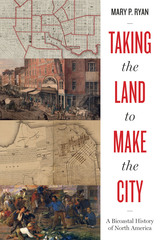 Taking the Land to Make the City: A Bicoastal History of North America
By Mary P. Ryan
University of Texas Press, 2019 The history of the United States is often told as a movement westward, beginning at the Atlantic coast and following farmers across the continent. But cities played an equally important role in the country’s formation. Towns sprung up along the Pacific as well as the Atlantic, as Spaniards and Englishmen took Indian land and converted it into private property. In this reworking of early American history, Mary P. Ryan shows how cities—specifically San Francisco and Baltimore—were essential parties to the creation of the republics of the United States and Mexico. Baltimore and San Francisco share common roots as early trading centers whose coastal locations immersed them in an international circulation of goods and ideas. Ryan traces their beginnings back to the first human habitation of each area, showing how the juggernaut toward capitalism and nation-building could not commence until Europeans had taken the land for city building. She then recounts how Mexican ayuntamientos and Anglo American city councils pioneered a prescient form of municipal sovereignty that served as both a crucible for democracy and a handmaid of capitalism. Moving into the nineteenth century, Ryan shows how the citizens of Baltimore and San Francisco molded landscape forms associated with the modern city: the gridded downtown, rudimentary streetcar suburbs, and outlying great parks. This history culminates in the era of the Civil War when the economic engines of cities helped forge the East and the West into one nation.
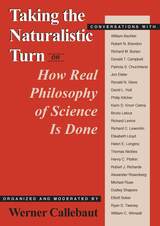 Taking the Naturalistic Turn, Or How Real Philosophy of Science Is Done
Edited Organized and Moderated by Werner Callebaut
University of Chicago Press, 1993 Philosophers of science traditionally have ignored the details of scientific research, and the result has often been theories that lack relevance either to science or to philosophy in general. In this volume, leading philosophers of biology discuss the limitations of this tradition and the advantages of the "naturalistic turn"—the idea that the study of science is itself a scientific enterprise and should be conducted accordingly.
This innovative book presents candid, informal debates among scholars who examine the benefits and problems of studying science in the same way that scientists study the natural world. Callebaut achieves the effect of face-to-face engagement through separate interviews with participants.
Contributors include William Bechtel, Robert Brandon, Richard M. Burian, Donald T. Campbell, Patricia Churchland, Jon Elster, Ronald N. Giere, David L. Hull, Philip Kitcher, Karin Knorr Cetina, Bruno Latour, Richard Levins, Richard C. Lewontin, Elisabeth Lloyd, Helen Longino, Thomas Nickles, Henry C. Plotkin, Robert J. Richards, Alexander Rosenberg, Michael Ruse, Dudley Shapere, Elliott Sober, Ryan Tweney, and William Wimsatt.
"Why can't we have both theoretical ecology and natural histories, lovingly done?"—Philip Kitcher
"Don't underestimate the arrogance of philosophers!"—Elisabeth Lloyd
Taking the Risk Out of Democracy: Corporate Propaganda versus Freedom and Liberty
Alex Carey
University of Illinois Press, 1995 Alex Carey documents the twentieth-century history of corporate propaganda as practiced by U.S. businesses, and its export to and adoption by Western democracies like the United Kingdom and Australia. The collection, drawn from Carey's voluminous unpublished writings, examines how and why the business elite successfully sold its values and perspectives to the rest of society.
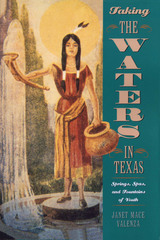 Taking the Waters in Texas: Springs, Spas, and Fountains of Youth
By Janet Mace Valenza
University of Texas Press, 2000 "It is well known that Southern Texas possesses a greater variety of Mineral Waters than any other country on the globe" enthused a promotion for one of Texas' many watering spas of the nineteenth century. Though most are closed and nearly forgotten today, Texas spas and resorts once drew thousands of visitors from across the country, seeking healing of body and spirit in the rejuvenating mineral waters. This book offers the first comprehensive history of Texas' healing springs. Janet Valenza tracks the rise, popularity, and decline of the "water cure" from the 1830s to the present day. She follows the development of major spas and resorts, such as Mineral Wells and Indian Hot Springs near El Paso, as well as of smaller, family-run springs. She also describes how mineral waters influenced patterns of settlement, transportation routes, commerce, and people's attitudes toward the land. Period photos and quotes from those seeking cures offer vivid glimpses into the daily life at the springs, which Valenza lists and describes county-by-county in the appendix.
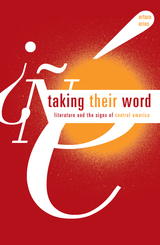 Taking Their Word: Literature and the Signs of Central America
Arturo Arias
University of Minnesota Press, 2007 Central Americans are one of the largest Latino population groups in the United States. Yet, Arturo Arias argues, the cultural production of Central Americans remains little known to North Americans. In Taking Their Word, Arias complicates notions of the cultural production of Central America, from Mexico in the North to Panama in the South. He charts the literature of Central America’s liberation struggles of the 1970s and 1980s, its transformation after peace treaties were signed, the emergence of a new Maya literature that decenters Latin American literature written in Spanish, and the rise and fall of testimonio. Arias demonstrates that Central America and its literature are marked by an indigenousness that has never before been fully theorized or critically grasped. Never one to avoid controversy, Arias proffers his views of how the immigration of Central Americans to North America has changed the cultural topography of both zones. With this groundbreaking work, Arias establishes the importance of Central American literature and provides a frame for future studies of the region’s culture. Arturo Arias is director of Latin American studies at the University of Redlands. He is the author of six novels in Spanish and editor of The Rigoberta Menchú Controversy (Minnesota, 2001).
 Taking Time
Mindy Fried
Temple University Press, 1998 There is a growing movement among corporations to provide family benefits in order to attract and retain women workers. They recognize that these benefits have become a cost of doing business. Many of these benefits, like child care and older care, are aimed at supporting employees' ability to stay on the job. Parental leave policies are an exception, because they involve taking time away from the job.
This timely book provides an inside look at life in a major U.S. corporation, focusing on the impact of workplace culture on the use of parental leave and those who use it. Fried begins by describing why parental leave is critical to making parenting the job of both parents in two-parent families. She examines the varied experiences of different levels of workers in how parental leave policy is used.
The author tells a rich and textured tale of day-to-day life in the skyscraper offices of a large corporation. How people dress, what their offices look like, which cafeteria they eat in, how the supervisors and supervised talk -- all these things are part of the fabric of corporate culture that Fried describes.
Most of us live in work cultures that value overtime. Fried argues that, as a "time policy" parental leave clashes with the powerful norm that corporate employees must work long and hard. Taking time for parenting -- a job that is devalued in our culture -- may be perceived as "taking time away" from the company, and, in particular, from the company's productivity.
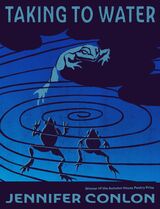 Taking to Water
Jennifer Conlon
Autumn House Press, 2023 A debut collection of poems that question gender and embrace queerness through the natural world of North Carolina.
A tender imagining and devastating reckoning, Jennifer Conlon’s debut presents a poetry collection of gender questioning, concerned with the survival of trans and nonbinary kids who live in places that do not allow them to thrive. The speaker of these poems wrestles with and envisions a life beyond their traumatic childhood as a genderqueer child in a small Southern Bible Belt town. Through retelling and reinterpreting moments of sexual shame and religious oppression, while navigating impossible expectations from a gender-binary society, Conlon shows readers that queerness and the natural world are inseparable. In their poems, Conlon comes to reject oppressive patriarchal figures, turning their gaze toward the natural world that catalyzes dreams of possibility, transformation, and safety—wasps protect them, an oak tree contains a new god, and flathead catfish guide them to a newly imagined body. Through thick North Carolina woods, Conlon searches for a language to celebrate queerness, finding it in ponds, hillsides, and within themselves.
Taking to Water was selected by Carl Phillips as the winner of the 2022 Autumn House Poetry Prize.
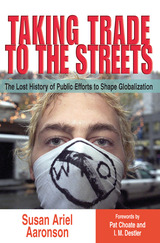 Taking Trade to the Streets: The Lost History of Public Efforts to Shape Globalization
Susan Ariel Aaronson
University of Michigan Press, 2002 In the wake of civil protest in Seattle during the 1999 World Trade Organization meeting, many issues raised by globalization and increasingly free trade have been in the forefront of the news. But these issues are not necessarily new. Taking Trade to the Streets describes how so many individuals and nongovernmental organizations came over time to see trade agreements as threatening national systems of social and environmental regulations. Using the United States as a case study, Susan Ariel Aaronson examines the history of trade agreement critics, focusing particular attention on NAFTA (the North American Free Trade Agreement between Canada, Mexico, and the United States) and the Tokyo and Uruguay Rounds of trade liberalization under the GATT. She also considers the question of whether such trade agreement critics are truly protectionist.
The book explores how trade agreement critics built a fluid global movement to redefine the terms of trade agreements (the international system of rules governing trade) and to redefine how citizens talk about trade. (The "terms of trade" is a relationship between the prices of exports and of imports.) That movement, which has been growing since the 1980s, transcends borders as well as longstanding views about the role of government in the economy. While many trade agreement critics on the left say they want government policies to make markets more equitable, they find themselves allied with activists on the right who want to reduce the role of government in the economy.
Aaronson highlights three hot-button social issues--food safety, the environment, and labor standards--to illustrate how conflicts arise between trade and other types of regulation. And finally she calls for a careful evaluation of the terms of trade from which an honest debate over regulating the global economy might emerge.
Ultimately, this book links the history of trade policy to the history of social regulation. It is a social, political, and economic history that will be of interest to policymakers and students of history, economics, political science, government, trade, sociology, and international affairs.
Susan Ariel Aaronson is Senior Fellow at the National Policy Institute and occasional commentator on National Public Radio's "Morning Edition."
Taking Up McLuhan's Cause: Perspectives on Media and Formal Causality
Edited by Corey Anton, Robert K. Logan, and Lance Strate
Intellect Books, 2017 This book brings together a number of prominent scholars to explore a relatively under-studied area of Marshall McLuhan’s thought: his idea of formal cause and the role that formal cause plays in the emergence of new technologies and in structuring societal relations. Aiming to open a new way of understanding McLuhan’s thought in this area, and to provide methodological grounding for future media ecology research, the book runs the gamut, from contributions that directly support McLuhan’s arguments to those that see in them the germs of future developments in emergent dynamics and complexity theory.
 Taking Your Medicine: Drug Regulation in the United States
Peter Temin
Harvard University Press, 1980 In a timely book about contemporary life, Peter Temin describes the way in which the government has taken control over the safety and use of medicinal drugs. From the turn of the century to the present, the Food and Drug Administration increasingly has controlled the use of non-narcotic drugs both by direct regulation and by delegating the growth of federal authority to doctors. This vivid history chronicles how the growth of federal control has expanded from verifying ingredients to guaranteeing their safety and then to ensuring efficacy. The effects of the long tradition of control can be seen in the pattern of drug regulation and in the structure of the drug industry today.
More than a narrative of drug regulation, Temin’s book analyzes how doctors, lay people as consumers and patients, and government act and react in situations requiring medicines. Temin reveals that uncertainty and imperfect knowledge about the comparative effects of taking different drugs pervades such situations, and that the way people choose drugs is affected by this uncertainty. Unable to obtain feedback about the competing merits of alternative therapies in many cases, doctors and consumers rely on medical customs in making their choices. Customs are functional in the sense that they are validated by experience, but they lack the ability of instrumental behavior (in which people alter actions in response to outcomes) to adapt smoothly to changing information.
In this context, the FDA has enlarged the scope of its authority throughout the twentieth century and made increasingly detailed decisions on behalf of us all. The agency has diminished consumer control over drug use even though doctors prescribe drugs largely by customary means and consumer ignorance is in part a consequence of the agency’s own regulations. In a careful and learned book, Temin suggests how changes and revisions in laws and regulations could redress the balance of responsibility toward doctor and patient.
 The Takings Issue: Constitutional Limits On Land Use Control And Environmental Regulation
Robert Meltz, Dwight H. Merriam, and Richard M. Frank; Foreword by Fred Bosselman David Callies John Banta
Island Press, 1999 As challenges to land use and environmental controls by landowners and the property-rights movement have become more frequent, the concept of "takings" -- government action that excessively limits a property-owner's use of private land -- has become both increasingly familiar to the public, and increasingly problematic for planners, local officials, and anyone involved with making day-to-day decisions about land use. A vast and diverse body of case law has come into existence over the past several decades, and the controversy generated by recent legal decisions has resulted in a significant level of ideological bias in much of what has been written on the topic.This volume is an objective and authoritative examination that considers all aspects of the takings issue. It is a much-needed guide and overview that introduces and explains issues surrounding regulatory takings on the local, state, and federal level for anyone involved with private land and government limitation of its permissible use. The authors describe where the law is now, predict where it might go in the future, and review conflict-reducing solutions to a variety of situations. They condense an immense amount of information into a clear and accesible format, making the book equally valuable for lawyers and non-lawyers alike.The Takings Issue addresses procedural hurdles involved in getting a takings issue heard by a court, examines what does and does not constitute a taking, and considers the remedies available to landowners involved in takings actions. It treats concerns such as zoning, dedications and exactions, subdivision platting, and other local issues in some detail, and also considers state and federal issues involving industrial site approval, endangered species and wetlands protection, restrictions on access to resources on federal lands, and other topics.The book is an essential reference for planners, land use lawyers, developers, and students of planning and law, as well as for policymakers and citizens involved with takings issues.
 Takings: Private Property and the Power of Eminent Domain
Richard A. Epstein
Harvard University Press, 1985 If legal scholar Richard Epstein is right, then the New Deal is wrong, if not unconstitutional. Epstein reaches this sweeping conclusion after making a detailed analysis of the eminent domain, or takings, clause of the Constitution, which states that private property shall not be taken for public use without just compensation. In contrast to the other guarantees in the Bill of Rights, the eminent domain clause has been interpreted narrowly. It has been invoked to force the government to compensate a citizen when his land is taken to build a post office, but not when its value is diminished by a comprehensive zoning ordinance.
Epstein argues that this narrow interpretation is inconsistent with the language of the takings clause and the political theory that animates it. He develops a coherent normative theory that permits us to distinguish between permissible takings for public use and impermissible ones. He then examines a wide range of government regulations and taxes under a single comprehensive theory. He asks four questions: What constitutes a taking of private property? When is that taking justified without compensation under the police power? When is a taking for public use? And when is a taking compensated, in cash or in kind?
Zoning, rent control, progressive and special taxes, workers’ compensation, and bankruptcy are only a few of the programs analyzed within this framework. Epstein’s theory casts doubt upon the established view today that the redistribution of wealth is a proper function of government. Throughout the book he uses recent developments in law and economics and the theory of collective choice to find in the eminent domain clause a theory of political obligation that he claims is superior to any of its modern rivals.
 The Taktika of Leo VI
Leo VI
Harvard University Press, 2010 Although he probably never set foot on a battlefield, the Byzantine emperor Leo VI (886–912) had a lively interest in military matters. Successor to Caesar Augustus, Constantine, and Justinian, he was expected to be victorious in war and to subject barbarian peoples to Rome, so he set out to acquire a solid knowledge of military equipment and practice. The Byzantines had inherited a voluminous series of military treatises from antiquity on nearly every aspect of warfare, from archery to battle formations and the art of besieging or defending. Leo intended to review all this, summarize it, and present an elementary handbook for his officers on how to prepare soldiers for war and how to move them on campaign and on the battlefield. He included a chapter on naval warfare and he explained Saracen (Arab) methods of war and how to defeat them. The Tactical Constitutions, or Taktika, were the result. Painstakingly prepared from a tenth century manuscript now in Florence, this is the first modern critical edition of the complete text of the Taktika and includes a facing English translation, explanatory notes, and extensive indexes.
The Taktika of Leo VI: Revised Edition
Leo VI
Harvard University Press, 2014 Although he probably never set foot on a battlefield, the Byzantine emperor Leo VI (886-912) had a lively interest in military matters. Successor to Caesar Augustus, Constantine, and Justinian, he was expected to be victorious in war and to subject barbarian peoples to Rome, so he set out to acquire a solid knowledge of military equipment and practice. The Tactical Constitutions, or Taktika, were the result. First published by Dumbarton Oaks in 2010 as part of the Corpus Fontium Historiae Byzantinae series, and now available in this updated, revised paper edition, this is the first modern critical edition of the complete text of the Taktika, including a facing English translation, explanatory notes, and extensive indexes.
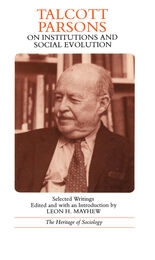 Talcott Parsons on Institutions and Social Evolution: Selected Writings
Talcott Parsons
University of Chicago Press, 1983 Talcott Parsons is regarded, by admirers and critics alike, as a major creator of the sociological thought of our time. Despite the universal recognition of his influence, however, Parsons's thought is not well understood, in part because his work presents the reader with almost legendary difficulties. Most of his important essays and books presume that the reader is familiar with his rather specialized vocabulary, and even when Parsons begins by defining basic terms, his special uses for words and his style of exposition strike many readers as forbidding.
In his extensive introduction to this volume, Leon H. Mayhew brings a new focus and clarity to Talcott Parsons's work. Explicating Parsons on his own terms, Mayhew discusses the basic tools of Parsonian analysis and interprets the larger themes of his work. He provides a chronological account of the development of Parsons's thought, his presuppositions, and his position on the ideological spectrum of social thought.
Mayhew then presents twenty of Parsons's essays, touching on each of the major aspects of his work, including "action" theory and the celebrated four-function scheme. Other topics covered include the role of theory in social research, evolutionary universals in society, influence, control, and the mass media.
"Talcott Parsons on Institutions and Social Evolution will become a standard reference for those studying that development of his sociological ideas."—Martin Bulmer, The Times Higher Education Supplement
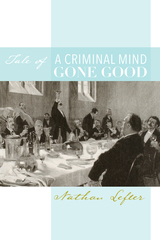 Tale of a Criminal Mind Gone Good
Nathan Lefler
St. Augustine's Press, 2021 In this concise and creative book, Nathan Lefler places G. K. Chesterton and René Girard in conversation on the art of being deceived. The campaign to get rid of (or mythicize) the Judaic and the Christian is not progress, it is a fog. Girard noted early on that returning preeminent status to the Judeo-Christian influence would have the (paradoxical) effect of clearing the air, such that humans might actually breathe and reason well again.
Entrée G. K. Chesterton. If Girard recognizes the talent certain literary figures have for observing what celebrated philosophers fail to see, Chesterton is one of these men of real vision. Lefler in his match-making is interested in “Romance and the romantic,” and placing Girard and Chesterton in a kind of dialogue he draws a clearer concept of Romanticism. Who is the Romatic hero? And why do we so badly need to know? If what Lefler sees in Chesterton and Girard requires “special pleading” on the part of the reader for the author to make himself more clear, Lefler obliges. He takes a sharp turn into the Father Brown stories and points the reader to Chesterton’s famous villain: Flambeau, the “colossus of crime”. The moral transition from sinner to saint in Flambeau is strikingly anti-Romantic and, with Girard in mind, also very much anti-mimetic. Or is it? Lefler argues that even Girard would have “inclined his own regal forehead in delight and awe” at Chesterton’s portrayal of the crowning Romantic quality and unlikely machete in an overgrown jungle of the self-intoxicated modern imagination––namely, humility.
Lefler makes his mark in several places with this new study. As literary critic, both Chesterton and Girard are honored. As philosopher, Lefler speaks as if somehow he managed to find a pocket of unpolluted air to breath. As theologian, he betrays that he also loves what Chesterton and Girard loved. And as special service to the reader, the full text of Chesterton’s The Queer Feet is provided.
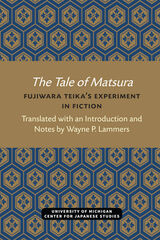 The Tale of Matsura: Fujiwara Teika’s Experiment in Fiction
Translated with an Introduction and Notes by Wayne P. Lammers
University of Michigan Press, 1992 Fujiwara Teika is known as the premier poet and literary scholar of the early 13th century. It is not so widely known that he also tried his hand at fiction: Mumyōzōshi (Untitled Leaves; ca. 1201) refers to “several works” by Teika and then names Matsura no miya monogatari (The Tale of Matsura; ca. 1190) as the only one that can be considered successful. The work is here translated in full, with annotation. Set in the pre-Nara period, The Tale of Matsura is the story of a young Japanese courtier, Ujitada, who is sent to China with an embassy and has a number of supernatural experiences while there. Affairs of the heart dominate The Tale of Matsura, as is standard for courtly tales. Several of its other features break the usual mold, however: its time and setting; the military episode that would seem to belong instead in a war tale; scenes depicting the sovereign’s daily audiences, in which formal court business is conducted; a substantial degree of specificity in referring to things Chinese; a heavy reliance on fantastic and supernatural elements; an obvious effort to avoid imitating The Tale of Genji as other late-Heian tales had done; and a most inventive ending. The discussion in the introduction briefly touches upon each of these features, and then focuses at some length on how characteristics associated with the poetic ideal of yōen inform the tale. Evidence relating to the date and authorship of the tale is explored in two appendixes.
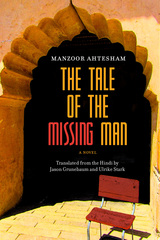 The Tale of the Missing Man: A Novel
Manzoor Ahtesham, translated from the Hindi by Jason Grunebaum and Ulrike Stark
Northwestern University Press, 2018 Winner of the Global Humanities Translation Prize
The Tale of the Missing Man (Dastan-e Lapata) is a milestone in Indo-Muslim literature. A refreshingly playful novel, it explores modern Muslim life in the wake of the 1947 partition of India and Pakistan. Zamir Ahmad Khan suffers from a mix of alienation, guilt, and postmodern anxiety that defies diagnosis. His wife abandons him to his reflections about his childhood, writing, ill-fated affairs, and his hometown, Bhopal, as he attempts to unravel the lies that brought him to his current state (while weaving new ones).
A novel of a heroic quest gone awry, The Tale of the Missing Man artfully twists the conventions of the Urdu romance, or dastan, tradition, where heroes chase brave exploits that are invariably rewarded by love. The hero of Ahtesham’s tale, living in the fast-changing city of Bhopal during the 1970s and ’80s, suffers an identity crisis of epic proportions: he is lost, missing, and unknown both to himself and to others. The result is a twofold quest in which the fate of protagonist and writer become inextricably and ironically linked. The lost hero sets out in search of himself, while the author goes in search of the lost hero, his fictionalized alter ego.
New York magazine cited the book as one of “the world's best untranslated novels.” In addition to raising important questions about Muslim identity, Ahtesham offers a very funny and thoroughly self-reflective commentary on the modern author’s difficulties in writing autobiography.
The Global Humanities Translation Prize is awarded annually to a previously unpublished translation that strikes the delicate balance between scholarly rigor, aesthetic grace, and general readability, as judged by a rotating committee of Northwestern faculty, distinguished international scholars, writers, and public intellectuals. The Prize is organized by the Global Humanities Initiative, which is jointly supported by Northwestern University’s Buffett Institute for Global Studies and Kaplan Institute for the Humanities.
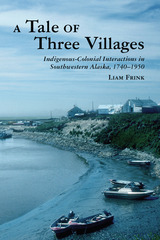 A Tale of Three Villages: Indigenous-Colonial Interactions in Southwestern Alaska, 1740–1950
Liam Frink
University of Arizona Press, 2016 People are often able to identify change agents. They can estimate possible economic and social transitions, and they are often in an economic or social position to make calculated—sometimes risky—choices. Exploring this dynamic, A Tale of Three Villages is an investigation of culture change among the Yup’ik Eskimo people of the southwestern Alaskan coast from just prior to the time of Russian and Euro-North American contact to the mid-twentieth century.
Liam Frink focuses on three indigenous-colonial events along the southwestern Alaskan coast: the late precolonial end of warfare and raiding, the commodification of subsistence that followed, and, finally, the engagement with institutional religion. Frink’s innovative interdisciplinary methodology respectfully and creatively investigates the spatial and material past, using archaeological, ethnoecological, and archival sources.
The author’s narrative journey tracks the histories of three villages ancestrally linked to Chevak, a contemporary Alaskan Native community: Qavinaq, a prehistoric village at the precipice of colonial interactions and devastated by regional warfare; Kashunak, where people lived during the infancy and growth of the commercial market and colonial religion; and Old Chevak, a briefly occupied “stepping-stone” village inhabited just prior to modern Chevak. The archaeological spatial data from the sites are blended with ethnohistoric documents, local oral histories, eyewitness accounts of people who lived at two of the villages, and Frink’s nearly two decades of participant-observation in the region.
Frink provides a model for work that examines interfaces among indigenous women and men, old and young, demonstrating that it is as important as understanding their interactions with colonizers. He demonstrates that in order to understand colonial history, we must actively incorporate indigenous people as actors, not merely as reactors.
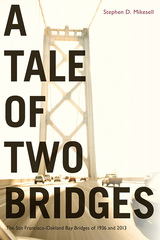 A Tale of Two Bridges: The San Francisco–Oakland Bay Bridges of 1936 and 2013
Stephen Mikesell
University of Nevada Press, 2017 A Tale of Two Bridges is a history of two versions of the San Francisco—Oakland Bay Bridge: the original bridge built in 1936 and a replacement for the eastern half of the bridge finished in 2013. The 1936 bridge revolutionized transportation in the Bay Area and profoundly influenced settlement patterns in the region. It was also a remarkable feat of engineering. In the 1950s the American Society of Civil Engineers adopted a list of the “Seven Engineering Wonders” of the United States. The 1936 structure was the only bridge on the list, besting even the more famous Golden Gate Bridge. One of its greatest achievements was that it was built on time (in less than three years) and came in under budget. Mikesell explores in fascinating detail how the bridge was designed by a collection of the best-known engineers in the country as well as the heroic story of its construction by largely unskilled laborers from California, joined by highly skilled steel workers.
By contrast, the East Span replacement, which was planned between 1989 and 1998, and built between 1998 and 2013, fell victim to cost overruns in the billions of dollars, was a decade behind schedule, and suffered from structural problems that has made it a perpetual maintenance nightmare.
This is narrative history in its purest form. Mikesell excels at explaining highly technical engineering issues in language that can be understood and appreciated by general readers. Here is the story of two very important bridges, which provides a fair but uncompromising analysis of why one bridge succeeded and the other did not.
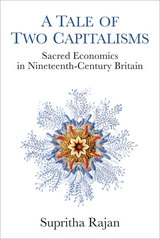 A Tale of Two Capitalisms: Sacred Economics in Nineteenth-Century Britain
Supritha Rajan
University of Michigan Press, 2015 No questions are more pressing today than the ethical dimensions of global capitalism in relation to an unevenly secularized modernity. A Tale of Two Capitalisms offers a timely response to these questions by reexamining the intellectual history of capitalist economics during the nineteenth century. Rajan’s ambitious book traces the neglected relationships between nineteenth-century political economy, anthropology, and literature in order to demonstrate how these discourses buttress a dominant narrative of self-interested capitalism that obscures a submerged narrative within political economy. This submerged narrative discloses political economy’s role in burgeoning theories of religion, as well as its underlying ethos of reciprocity, communality, and just distribution. Drawing on an impressive range of literary, anthropological, and economic writings from the eighteenth through the twenty-first century, Rajan offers an inventive, interdisciplinary account of why this second narrative of capitalism has so long escaped our notice. The book presents an unprecedented genealogy of key anthropological and economic concepts, demonstrating how notions of sacrifice, the sacred, ritual, totemism, and magic remained conceptually intertwined with capitalist theories of value and exchange in both sociological and literary discourses. Rajan supplies an original framework for discussing the ethical ideals that continue to inform contemporary global capitalism and its fraught relationship to the secular. Its revisionary argument brings new insight into the history of capitalist thought and modernity that will engage scholars across a variety of disciplines.
 A Tale of Two Colonies: What Really Happened in Virginia and Bermuda?
Virginia Bernhard
University of Missouri Press, 2011 In 1609, two years after its English founding, colonists struggled to stay alive in a tiny fort at Jamestown.John Smith fought to keep order, battling both English and Indians. When he left, desperate colonists ate lizards, rats, and human flesh. Surviving accounts of the “Starving Time” differ, as do modern scholars’ theories. Meanwhile, the Virginia-bound Sea Venture was shipwrecked on Bermuda, the dreaded, uninhabited “Isle of Devils.” The castaways’ journals describe the hurricane at sea as well as murders and mutinies on land. Their adventures are said to have inspired Shakespeare’s The Tempest. A year later, in 1610, the Bermuda castaways sailed to Virginia in two small ships they had built. They arrived in Jamestown to find many people in the last stages of starvation; abandoning the colony seemed their only option. Then, in what many people thought was divine providence, three English ships sailed into Chesapeake Bay. Virginia was saved, but the colony’s troubles were far from over. Despite glowing reports from Virginia Company officials, disease, inadequate food, and fear of Indians plagued the colony. The company poured thousands of pounds sterling and hundreds of new settlers into its venture but failed to make a profit, and many of the newcomers died. Bermuda—with plenty of food, no native population, and a balmy climate—looked much more promising, and in fact, it became England’s second New World colony in 1612. In this fascinating tale of England’s first two New World colonies, Bernhard links Virginia and Bermuda in a series of unintended consequences resulting from natural disaster, ignorance of native cultures, diplomatic intrigue, and the fateful arrival of the first Africans in both colonies. Written for general as well as academic audiences, A Tale of Two Colonies examines the existing sources on the colonies, sets them in a transatlantic context, and weighs them against circumstantial evidence. From diplomatic correspondence and maps in the Spanish archives to recent archaeological discoveries at Jamestown, Bernhard creates an intriguing history. To weave together the stories of the two colonies, which are fraught with missing pieces, she leaves nothing unexamined: letters written in code, adventurers’ narratives, lists of Africans in Bermuda, and the minutes of committees in London. Biographical details of mariners, diplomats, spies, Indians, Africans, and English colonists also enrich the narrative. While there are common stories about both colonies, Bernhard shakes myth free from truth and illuminates what is known—as well as what we may never know—about the first English colonies in the New World.
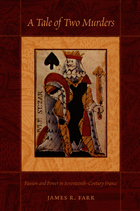 A Tale of Two Murders: Passion and Power in Seventeenth-Century France
James R. Farr
Duke University Press, 2005 As scandalous as any modern-day celebrity murder trial, the “Giroux affair” was a maelstrom of intrigue, encompassing daggers, poison, adultery, archenemies, servants, royalty, and legal proceedings that reached the pinnacle of seventeenth-century French society. In 1638 Philippe Giroux, a judge in the highest royal court of Burgundy, allegedly murdered his equally powerful cousin, Pierre Baillet, and Baillet’s valet, Philibert Neugot. The murders were all the more shocking because they were surrounded by accusations (particularly that Giroux had been carrying on a passionate affair with Baillet’s wife), conspiracy theories (including allegations that Giroux tried to poison his mother-in-law), and unexplained deaths (Giroux’s wife and her physician died under suspicious circumstances). The trial lasted from 1639 until 1643 and came to involve many of the most distinguished and influential men in France, among them the prince of Condé, Henri II Bourbon; the prime minister, Cardinal Richelieu; and King Louis XIII. James R. Farr reveals the Giroux affair not only as a riveting murder mystery but also as an illuminating point of entry into the dynamics of power, justice, and law in seventeenth-century France. Drawing on the voluminous trial records, Farr uses Giroux’s experience in the court system to trace the mechanisms of power—both the formal power vested by law in judicial officials and the informal power exerted by the nobility through patron-client relationships. He does not take a position on Giroux’s guilt or innocence. Instead, he allows readers to draw their own conclusions about who did what to whom on that ill-fated evening in 1638.
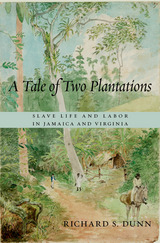 A Tale of Two Plantations: Slave Life and Labor in Jamaica and Virginia
Richard S. Dunn
Harvard University Press, 2014 Forty years ago, after publication of his pathbreaking book Sugar and Slaves, Richard Dunn began an intensive investigation of two thousand slaves living on two plantations, one in North America and one in the Caribbean. Digging deeply into the archives, he has reconstructed the individual lives and collective experiences of three generations of slaves on the Mesopotamia sugar estate in Jamaica and the Mount Airy plantation in tidewater Virginia, to understand the starkly different forms slavery could take. Dunn’s stunning achievement is a rich and compelling history of bondage in two very different Atlantic world settings.
From the mid-eighteenth century to emancipation in 1834, life in Mesopotamia was shaped and stunted by deadly work regimens, rampant disease, and dependence on the slave trade for new laborers. At Mount Airy, where the population continually expanded until emancipation in 1865, the “surplus” slaves were sold or moved to distant work sites, and families were routinely broken up. Over two hundred of these Virginia slaves were sent eight hundred miles to the Cotton South.
In the genealogies that Dunn has painstakingly assembled, we can trace a Mesopotamia fieldhand through every stage of her bondage, and contrast her harsh treatment with the fortunes of her rebellious mulatto son and clever quadroon granddaughter. We track a Mount Airy craftworker through a stormy life of interracial sex, escape, and family breakup. The details of individuals’ lives enable us to grasp the full experience of both slave communities as they labored and loved, and ultimately became free.
A Tale of Two Villages: Coerced Modernization in the East European Countryside
Alina Mungiu-Pippidi
Central European University Press, 2010 This dramatic story of land and power from twentieth-century Eastern Europe is set in two extraordinary villages: a rebel village, where peasants fought the advent of Communism and became its first martyrs, and a model village turned forcibly into a town, Dictator Ceausescu's birthplace. The two villages capture among themselves nearly a century of dramatic transformation and social engineering, ending up with their charged heritage in the present European Union.
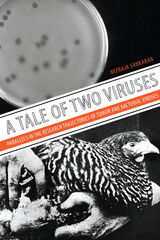 A Tale of Two Viruses: Parallels in the Research Trajectories of Tumor and Bacterial Viruses
Neeraja Sankaran
University of Pittsburgh Press, 2020 In 1965, French microbiologist André Lwoff was awarded the Nobel Prize in Physiology or Medicine for his work on lysogeny—one of the two types of viral life cycles—which resolved a contentious debate among scientists about the nature of viruses. A Tale of Two Viruses is the first study of medical virology to compare the history of two groups of medically important viruses—bacteriophages, which infect bacteria, and sarcoma agents, which cause cancer—and the importance of Lwoff’s discovery to our modern understanding of what a virus is. Although these two groups of viruses may at first glance appear to have little in common, they share uniquely parallel histories. The lysogenic cycle, unlike the lytic, enables viruses to replicate in the host cell without destroying it and to remain dormant in a cell’s genetic material indefinitely, or until induced by UV radiation. But until Lwoff’s discovery of the mechanism of lysogeny, microbiologist Félix d’Herelle and pathologist Peyton Rous, who themselves first discovered and argued for the viral identity of bacteriophages and certain types of cancer, respectively, faced opposition from contemporary researchers who would not accept their findings. By following the research trajectories of the two virus groups, Sankaran takes a novel approach to the history of the development of the field of medical virology, considering both the flux in scientific concepts over time and the broader scientific landscapes or styles that shaped those ideas and practices.
 A Tale of Two Worlds
Vjenceslav Novak
Central European University Press, 2014 In this novel, written by the esteemed novelist in 1901, a provincial composer and organist from Croatia struggles to find his way along the perilous frontier between the worlds of artistic vocation and humdrum family life. The local kapellmeister—-a Czech, in good Habsburg tradition, and a confidant of Gaj and Palacky, influential politicians of the time—-recognizes young Amadej Zlatanic as a prodigy and persuades the stingy mayor and stubborn parish priest to pack the teenager off to the conservatory in Prague. After several years of sordid student purgatory, Amadej returns to Croatia—-ready for love and ready to make great art.The world of Central Europe in the 1860s flows past, and Amadej tries to keep abreast of political change. At the same time he ducks and dodges predatory relatives and townspeople in his native district, to which he has returned for the sake of employment. Despite his marriage to the impressionable and vulnerable local beauty, Adelka, and his devotion to their daughter Veruska, Amadej is sorely troubled by the political corruption and isolation of Croatia. His wife takes ill and his family is poor. Yet ultimately it is the vulgar, populist notion of Croatian "identity"—-symbolized by the worship of the tamburica, a local musical instrument—-that crushes Amadej's career. As it does so, he contemplates the two worlds of national greatness, amidst the Croatian national awakening, and international fame. Finally, frustrated beyond relief by unsuccessful affairs both amorous and professional, and tortured by the philistinism surrounding him, Amadej leaves the world of sanity for a mind-blowing descent into the maniacal and inescapable world of hallucination, paganism, and paranoia.
 Talent and Education: Present Status and Future Directions
E. Torrance
University of Minnesota Press, 1960
Talent and Education was first published in 1960. Minnesota Archive Editions uses digital technology to make long-unavailable books once again accessible, and are published unaltered from the original University of Minnesota Press editions.The problem of identification, development, and utilization of talented young people is a matter of prime concern to all who are interested in the welfare of the individual and the future of the nation. This book, constituting a progress report on research related to the problem, will be of particular value to educators, psychologists, social workers, community leaders, and others who are engaged in the effort to make the most of our human resources.The volume contains chapters by a number of contributors drawn from various fields in elementary, secondary, and higher education. The contributors include John E. Anderson, Robert H. Beck, Florence N. Brumbaugh, Walter W. Cook, Willis E. Dugan, Dale B. Harris, Arthur J. Lewis, Catherine Cox Miles, Mary Pilch, Maynard C. Reynolds, Anne Roe, Merrill F. Roff, Paul C. Rosenbloom, Audrey Shechtman, and E. Paul Torrance. Orville L. Freeman, governor of Minnesota, writes an indtroduction.Among the topics discussed are the nature and scientific measurement of talent, the effects of life experiences on the development of talent, the enrichment of school curricula, special grouping and acceleration in the schools, psychological aspects of some of the problems, and Russian methods of dealing with individual differences. The volume is based on papers from an Institute on Exceptional Children held at the University of Minnesota.
 Tales and Sketches, vol. 1: 1831-1842
Edgar Allan Poe
University of Illinois Press, 1978 Esteemed as a literary critic and poet, Edgar Allan Poe was most highly acclaimed for his tales and sketches. He transformed the short story from anecdote to art, virtually created the detective story, and perfected the psychological thriller. This volume is the first of two, edited by the consummate Poe scholar Thomas Ollive Mabbott, collecting all the tales of this master of the uncanny, the unnerving, and the terrifying.
Poe's stories reflect his professed method of "writing as if the author were firmly impressed with the truth, yet astonished at the immensity of the wonders he related." Marrying grotesque inventiveness with superb plot construction, Poe's strikingly original tales often use only one main character and one main incident. In many of them, horror and suspense, revenge and torture, are laced with hilarious satire. Each volume is enriched with Mabbott's detailed and authoritative notes on sources, the history and collation of all known texts authorized by Poe, and variants of Poe's "final" version.
Volume 1 includes Poe's earliest parodies, beginning in 1831, and gathers his gothic tales written through 1842. The stories collected in this volume include "Ms. Found in a Bottle," the horrific "Berenice," "Ligeia" (which Poe considered his finest tale), "The Murders in the Rue Morgue," and one of his most famous stories, "The Fall of the House of Usher."
Promising spine-tingling delights and sleepless nights, this annotated edition of Tales and Sketches is a treasure trove for scholars and general readers alike, confirming Poe's status as one of literary art's "most brilliant but erratic stars."
 Tales and Sketches, vol. 2: 1843-1849
Edgar Allan Poe
University of Illinois Press, 1978 Esteemed as a literary critic and poet, Edgar Allan Poe was most highly acclaimed for his tales and sketches. He transformed the short story from anecdote to art, virtually created the detective story, and perfected the psychological thriller. This volume is the second of two, edited by the consummate Poe scholar Thomas Ollive Mabbott, collecting all the tales of this master of the uncanny, the unnerving, and the terrifying.
Poe's stories reflect his professed method of "writing as if the author were firmly impressed with the truth, yet astonished at the immensity of the wonders he related." Marrying grotesque inventiveness with superb plot construction, Poe's strikingly original tales often use only one main character and one main incident. In many of them, horror and suspense, revenge and torture, are laced with hilarious satire. Each volume is enriched with Mabbott's detailed and authoritative notes on sources, the history and collation of all known texts authorized by Poe, and variants of Poe's "final" version.
Volume 2 contains stories written between 1843 and Poe's death, including "The Tell-Tale Heart," "The Purloined Letter," and "The Cask of Amontillado."
Promising spine-tingling delights and sleepless nights, this annotated edition of Tales and Sketches is a treasure trove for scholars and general readers alike, confirming Poe's status as one of literary art's "most brilliant but erratic stars."
Tales and Songs of Southern Illinois
Collected by Charles Neely
Southern Illinois University Press, 1998 First published in 1938, this lively collection of over 150 tales and songs runs the gamut from joy to woe, from horror to humor. In forming the collection, Charles Neely required only that the tales and songs—whether home grown or transplanted from the great body of world lore— had taken root somehow in the area of southern Illinois known as Egypt. Notable tales include "Bones in the Well," "A Visit from Jesse James," "The Flight of the Naked Teamsters," "The Dug Hill Boger," and "How Death Came to Ireland"; among the songs and ballads are "Barbara Allen," "Hog and Hominy," "The Drunkard’s Lone Child," "The Belleville Convent Fire," "Shawneetown Flood," and "The Death of Charlie Burger."
Tales and Towns of Northern New Jersey
Beck, Henry
Rutgers University Press, 1967 Long regarded as folklife classics, Henry Charlton Beck's books are vivid recreations of the back roads, small towns, and legends that give New Jersey its special character. Rutgers University Press is pleased to make these important books available again in newly designed editions.
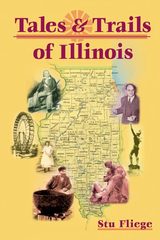 Tales and Trails of Illinois
Stu Fliege
University of Illinois Press, 2002 Based on a collection of fifty-two vignettes of Illinois history originally published as weekly columns in newspapers and revised for publication in book form, Tales and Trails of Illinois presents little-known episodes and adds perspective to tales of the state’s varied past. Pairing readable commentary with striking description and detail, the book is a useful compendium of Illinois heritage in an accessible and entertaining format.
Stu Fliege highlights historical events, such as the Herrin Massacre and Chicago’s Iroquois Theatre fire, and covers the diverse terrain of Illinois’s natural and constructed wonders, from Lusk Creek Canyon to Robert Allerton Park. Readers will meet a colorful cast of characters including pioneers, squatters, miners, gangsters, and utopian leaders. They’ll travel back in time to when salt production was the state’s main industry and learn of the Illinois ingenuity that spawned inventions including barbed wire, the steel plow, and the Ferris wheel. From Oquawka’s elephant memorial to Murphysboro’s mysterious mud monster, the book also offers quirky facts and spooky stories that aren’t found in the average history book.
Liberally illustrated and clearly written, Tales and Trails of Illinois is a helpful learning tool for Illinoisans of all ages, perfect for families, history buffs, libraries, and the classroom.
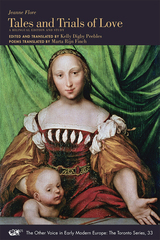 Tales and Trials of Love, Concerning Venus’s Punishment of Those Who Scorn True Love and Denounce Cupid’s Sovereignty: A Bilingual Edition and Study
Jeanne Flore
Iter Press, 2014 Kelly Peebles’s excellent translation and edition of Jeanne Flore’s Comptes amoureux / Tales and Trials of Love (Lyon, 1542) puts Flore back on the map of important French female authors, both for English-speaking readers and for scholars interested more broadly in early modern French print culture. The transcription of the French text, complete with bibliographic details from the first edition, pairs beautifully with Peebles’s dynamic and engaging translation. Peebles’s introduction elegantly shows how Flore’s text stands as a significant textual and material representative of one of the most artistically rich and culturally tumultuous times in early modern France. Her edition and translation will no doubt become a principal reference for future scholarly work not only on Jeanne Flore, but also on female authorship, gender, and print culture in early modern France and Europe.
Tales from a Free-Range Childhood
Donald Davis
Parkhurst Brothers, Inc., 2022 A cycle of twenty stories, each of which is focused on childhood friends, the antics of his neighborhood and school chums, and the mysteries of adult life seen through a child’s unerring eye.
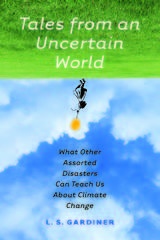 Tales from an Uncertain World: What Other Assorted Disasters Can Teach Us About Climate Change
L. S. Gardiner
University of Iowa Press, 2018 So far, humanity hasn’t done very well in addressing the ongoing climate catastrophe. Veteran science educator L. S. Gardiner believes we can learn to do better by understanding how we’ve dealt with other types of environmental risks in the past and why we are dragging our feet in addressing this most urgent emergency. Weaving scientific facts and research together with humor and emotion, Gardiner explores human responses to erosion, earthquakes, fires, invasive species, marine degradation, volcanic eruptions, and floods in order to illuminate why we find it so challenging to deal with climate change. Insight emerges from unexpected places—a mermaid exhibit, a Magic 8 Ball, and midcentury cartoons about a future that never came to be. Instead of focusing on the economics and geopolitics of the debate over climate change, this book brings large-scale disaster to a human scale, emphasizing the role of the individual. We humans do have the capacity to deal with disasters. When we face threatening changes, we don’t just stand there pretending it isn’t so, we do something. But because we’re human, our responses aren’t always the right ones the first time—yet we can learn to do better. This book is essential reading for all who want to know how we can draw on our strengths to survive the climate catastrophe and forge a new relationship with nature.
Tales From Jackpine Bob
Bob Cary
University of Minnesota Press, 2003 Bob Cary’s entertaining stories of life in the outdoors will touch your heart and make you laugh. Despite Bob’s many years as an expert woodsman, when he relates an adventure or a misadventure, the joke is always on him. Whether you read Tales from Jackpine Bob by firelight or lamplight, you’ll enjoy Bob’s warm humor and buoyant spirit.
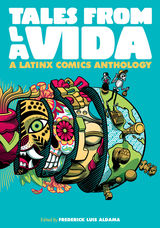 Tales from la Vida: A Latinx Comics Anthology
Edited by Frederick Luis Aldama
Ohio State University Press, 2018 In the Latinx comics community, there is much to celebrate today, with more Latinx comic book artists than ever before. The resplendent visual-verbal storyworlds of these artists reach into and radically transform so many visual and storytelling genres. Tales from la Vida celebrates this space by bringing together more than eighty contributions by extraordinary Latinx creators. Their short visual-verbal narratives spring from autobiographical experience as situated within the language, culture, and history that inform Latinx identity and life. Tales from la Vida showcases the huge variety of styles and worldviews of today’s Latinx comic book and visual creators. Whether it’s detailing the complexities of growing up—mono- or multilingual, bicultural, straight, queer, or feminist Latinx—or focusing on aspects of pop culture, these graphic vignettes demonstrate the expansive complexity of Latinx identities. Taken individually and together, these creators—including such legendary artists as Jaime and Gilbert Hernandez, Roberta Gregory, and Kat Fajardo, to name a few—and their works show the world that when it comes to Latinx comics, there are no limits to matters of content and form. As we travel from one story to the next and experience the unique ways that each creator chooses to craft his or her story, our hearts and minds wake to the complex ways that Latinxs live within and actively transform the world.
Tales from Luristan
Sekandar Amanolahi
Harvard University Press, 1986 Little is known of the Luri dialect of Khurramabad, but Professor Amanolahi of Shiraz University has collected various stories from his native town in the local language. Together with Wheeler Thackston of Harvard he has prepared a compact volume covering the tales in transcription, translations into English, a short grammatical sketch, and a Luri-English vocabulary (Luristan is a province of western Iran in the Zagros Mountains). The traditional grammatical analysis of the dialect is easy to follow and the translations of both poetry and prose closely follow the original, a tribute to the close collaboration of the two scholars. This unique volume will be of great interest to students of the folklore, linguistics, and customs of the inhabitants of the center of Luristan.
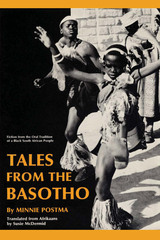 Tales from the Basotho
By Minnie Postma
University of Texas Press, 1974 "They say that the eldest of the chief's daughters..." So begins a tale from the Basotho, unfolded by the meager light of a dung fire that burns smokily behind the reed screen sheltering the entrance of the hut. The old ones of the tribe wait until dark before telling their stories, for everyone knows horns will grow from the head of one who tells a story during daylight hours. Tales from the Basotho abounds with elements familiar to folk narrative. The heroes and heroines are the chiefs and their wives, their sons and their daughters. Fantastic creatures frequent the narratives. exhibiting their awful powers. Rustic peace and beauty pervade the stories, as Minnie Postma amply demonstrates in her versions of the tales. Something fearful may be occurring—the dreaded Koeoko pulling the only son of the chief under water—but, at the same time, girls with babies tied to their backs are searching for edible bulbs in the veld, and an old woman dreams in the gentle sunlight in front of the huts. These tales from the Basotho are for entertainment only. There is a tabu against telling tales while the sun shines, because daylight hours must be saved for work. The telling itself is the· reason the story exists, for the audience is already aware of the outcome of each tale. As Wm. Hugh Jansen emphasizes in his foreword, "text" and "context" are often easily interpreted and made accessible in a translation, but Tales from the Basotho is ultimately successful for its rendering of "texture." And texture is doubly hard to convey when the telling itself is of primary importance. Minnie Postma and Susie McDermid have transferred the art of the Basotho raconteur onto the printed page. All the simple, understandable formulas, exclamations, and repetitions used so skillfully by the native storyteller are present. Rhythm is an important element in the tales, and a word, a phrase, even a whole paragraph will be repeated until the rhythm satisfies the storyteller, in tum increasing the appreciation of the listeners.
Tales from the Big Thicket
Francis Edward Abernethy
University of North Texas Press, 2002 Abernethy presents the history and folklore of the Big Thicket and its people, including a collection of Alabama-Coushatta tales, a search for hidden Jayhawkers during the Civil War, a nineteenth-century travel account, and a family history of the legendary Hooks.
Tales from the Kingdom of Lailonia and The Key to Heaven
Leszek Kolakowski
University of Chicago Press, 1989 This volume contains two unusual and appealing satirical works by the well-known European philosopher Kolakowski. The first, Tales from the Kingdom of Lailonia, is set in a fictional land. Each story illustrates some aspect of human inability to come to terms with imperfection, infinitude, history, and nature. The second, The Key to Heaven, is a collection of seventeen biblical tales from the Old Testament told in such a way that the story and the moral play off each other to illustrate political, moral, or existential foibles and follies.
Tales from the Prince of Storytellers
Robert Louis Stevenson
Northwestern University Press, 1993 Robert Louis Stevenson is widely known for his novels Dr. Jekyll and Mr. Hyde, Treasure Island, and Kidnapped. His reputation as a "romantic" writer and children's author, however, reflects only a portion of his literary achievement. This collection of stories features an introduction by Stevenson scholar Barry Menikoff which places Stevenson's writing in a new context. Menikoff argues that Stevenson is misunderstood by academic readers and critics and presents him as a writer whose subjects and methods are clearly modernist.
Included in this volume for the first time are versions of the stories "Markheim" and "The Isle of Voices" as they appear in Stevenson' s holograph manuscripts, plus his classics The Suicide Club, The Rajah's Diamond, "The Bottle Imp," "The Pavilion on the Links," "A Lodging for the Night," "The Merry Men," and "Thrawn Janet."
Tales Never Told Around Campfire: True Tales Of Frontier America
Mark Dugan
Ohio University Press, 1992 Ten outlaws, ten states, ten stories of nineteenth-century fugitives remarkable because the events really took place. Mark Dugan’s latest outlaw chase reins in enough evidence to corral the cynics. There is new information on the strange relationship between Wild Bill Hickok, his enemy and victim, David McCanles, and the beautiful Sarah Shull of North Carolina. Was Tom Horn a hired killer for the big cattlemen in the unsolved Wyoming ambush? How much do we really know about Deputy U.S. Marshall Ed Short, legendary for his gun duel with Black-Faced Charley Bryant of the Dalton Gang in Oklahoma? Or Cora Hubbard, who led a bank robbery in Missouri, then went home to Kansas to change back into a dress and bury the stolen money in her potato patch? What became of Punch Collins, black leader of a New Mexico train bold up in 1884?
Tales of a Low-Rent Birder
By Pete Dunne
University of Texas Press, 1994 Tales of a Low-Rent Birder is a collection of nineteen essays and sketches written between 1977 and 1985. It was originally published in 1986.
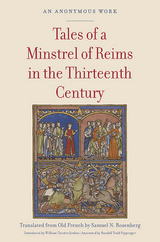 Tales of a Minstrel of Reims in the Thirteenth Century
Samuel N. Rosenberg
Catholic University of America Press, 2021 An anonymous minstrel in thirteenth-century France composed this gripping account of historical events in his time. Crusaders and Muslim forces battle for control of the Holy Land, while power struggles rage between and among religious authorities and their conflicting secular counterparts, pope and German emperor, the kings of England and the kings of France. Meanwhile, the kings cannot count on their independent-minded barons to support or even tolerate the royal ambitions. Although politics (and the collapse of a royal marriage) frame the narrative, the logistics of war are also in play: competing military machinery and the challenges of transporting troops and matariel. Inevitably, the civilian population suffers.
The minstrel was a professional story-teller, and his livelihood likely depended on his ability to captivate an audience. Beyond would-be objective reporting, the minstrel dramatizes events through dialogue, while he delves into the motives and intentions of important figures, and imparts traditional moral guidance. We follow the deeds of many prominent women and witness striking episodes in the lives of Eleanor of Aquitaine, Richard the Lionhearted, Blanche of Castile, Frederick the Great, Saladin, and others. These tales survive in several manuscripts, suggesting that they enjoyed significant success and popularity in their day.
Samuel N. Rosenberg produced this first scholarly translation of the Old French tales into English. References that might have been obvious to the minstrel’s original audience are explained for the modern reader in the indispensable annotations of medieval historian Randall Todd Pippenger. The introduction by eminent medievalist William Chester Jordan places the minstrel’s work in historical context and discusses the surviving manuscript sources.
 Tales of an American Hobo
Charles Elmer Fox
University of Iowa Press, 1989 "Reefer Charlie" Fox rode the rails from 1928 to 1939; from 1939 to 1965 he hitched rides in automobiles and traveled by foot. From Indiana to British Columbia, from Arkansas to Texas, from Utah to Mexico, he was part of the grand hobo tradition that has all but passed away from American life. He camped in hobo jungles, slept under bridges and in sand houses at railroad yards, ate rattlesnake meat, fresh California grapes, and fish speared by the Indians of the Northwest. He quickly learned both the beauty and the dangers of his chosen way of life. One lesson learned early on was that there are distinct differences among hoboes, tramps, and bums. As the all-time king of hoboes, Jeff Davis, used to say, "Hoboes will work, tramps won't, and bums can't." Tales of an American Hobo is a lasting legacy to conventional society, teaching about a bygone era of American history and a rare breed of humanity who chose to live by the rails and on the road.
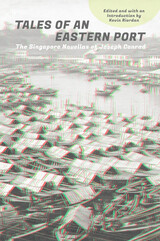 Tales of an Eastern Port: The Singapore Novellas of Joseph Conrad
Joseph Conrad
National University of Singapore Press, 2023 Singapore in the writings of Joseph Conrad: a node in the networks of colonial modernity.
In the 1880s, Joseph Conrad spent three extended stints in the colonial port city of Singapore, while working on ships around the region. Over the next thirty years, he would return to this place many times in his writing. Singapore is the principal, if sometimes obscured, port of call in Conrad’s fiction; it is the center of overlapping networks, colonial and commercial, religious and literary. His characters travel to upriver Borneo and to Bangkok, to Shanghai and to Sydney, and yet they tend to return to Singapore.
This volume pairs for the first time two Conrad novellas that start in Singapore: The End of the Tether and The Shadow-Line.Together they provide a fleeting portrait of the developing city, through narrators who are uneasy with the trappings and workings of the colonial enterprise. These stories have renewed relevance as part of global modernist and oceanic literatures, and reading them now helps recall one chapter in Singapore’s long history as a vital site of cultural exchange, one that harbors and inspires distinctive storytelling traditions.
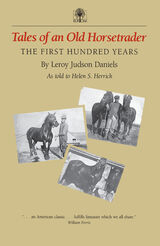 Tales of an Old Horsetrader: The First Hundred Years
Leroy Judson Daniels
University of Iowa Press, 1987 Leroy Daniels was born in 1882 near Adair, Iowa. When he was ten, his father gave him a pony and a checkbook and sent him out to buy cattle. By the time he was sixteen, he was alone on a ranch in Montana with a herd of seventy wild horses to break. At twenty-one, he was trading horses in the Chicago stockyards, where he told Henry Ford that a horse was better than a car any day. At one hundred, he retired to tell his memoirs. The years in between are well worth reading about. Lee Daniels followed a plow all day long, worked coal to make ends meet, raised and traded and sold all manner of four-legged stock. But horses were always part of his life. Daniels traded them in Chicago for decades, sold them to Italy, England, France, and Belgium during World War I, inspected them for the army once the U.S. joined the Allies, bought them for eighty dollars in the morning and sold them for thousands by noon. He handled show horses, work horses, and trick horses, traveled the country over to fill his show barn with the best of them, befriended, understood, and loved them. These pages tell the tale of a unique and vigorous American whose every word reveals his love of this land and its animals. If you weren't lucky enough to live like Lee Daniels, reading about his life is the next best thing.
Tales of Ancient India
Edited by J. A. B. van Buitenen
University of Chicago Press, 1959 "This admirably produced and well-translated volume of stories from the Sanskrit takes the Western reader into one of the Golden Ages of India. . . . The world in which the tales are set is one which placed a premium upon slickness and guile as aids to success. . . . Merchants, aristocrats, Brahmins, thieves and courtesans mingle with vampires, demi-gods and the hierarchy of heaven in a series of lively or passionate adventures. The sources of the individual stories are clearly indicated; the whole treatment is scholarly without being arid."—The Times Literary Supplement
"Fourteen tales from India, newly translated with a terse and vibrant effectiveness. These tales will appeal to any reader who enjoys action, suspense, characterization, and suspension of disbelief in the supernatural."—The Personalist
Tales of Badmen, Bad Women, and Bad Places: Four Centuries of Texas Outlawry
C. F. Eckhardt
Texas Tech University Press, 1999 A badman is not necessarily a bad man, but he is not a man to mess with. He might be a killer, a con artist, or even a Texas Ranger with his own ideas about law enforcement; or he might just be "wuthless." A bad woman might be a criminal too, or she might just be one who didn’t conform to accepted notions of womanly conduct in her time and place. C. F. Eckhardt tells the stories your teacher never told you about Texas outlaws. Some are famous, and some you may never have heard of. All of them were out for their share of the good life in Texas.
Tales of Canyonlands Cowboys
Richard Negri
Utah State University Press, 1997 Richard Negri interviews cattlemen and women about ranching in the rugged canyonlands region of southeastern Utah. Personal stories and anecdotes from the colorful characters who ground out a hard living on ranches of the are in the early twentieth century.
 Tales of Dionysus: The Dionysiaca of Nonnus of Panopolis
Edited by William Levitan and Stanley Lombardo
University of Michigan Press, 2022 Tales of Dionysus is the first English verse translation of one of the most extraordinary poems of the Greek literary tradition, the Dionysiaca of Nonnus of Panopolis. By any standard, the Dionysiaca is a formidable work. It is by far the longest poem surviving from the classical world, a massive mythological epic stretching to over 20,000 lines, written in the tradition of Homer, using Homer’s verse, Homer’s language, his narrative turns and motifs, and invoking his ancient Muses. But it is also the last ancient epic to follow a Homeric model, composed so late in fact that it stands as close in time to the Renaissance as it does to archaic Greece. Like its titular hero, Dionysus, with his fluidity of forms, names, and divine incarnations, the poem itself is continually shifting shape. Out of its formal epic frame spills a tumult of ancient literary types: tragedy, elegy, didactic, panegyric, pastoral idyll, and the novel are all parts of this gigantic enterprise, each genre coming to the fore one after the other. Tales of Dionysus brings together forty-two translators from a wide range of backgrounds, with different experiences and different potential relationships to the text of Nonnus’ poem. All work in their own styles and with their own individual approaches to the poem, to translation, and to poetic form. This variety turns Tales of Dionysus into a showcase of the multiple possibilities open to classical translation in the contemporary world.
Tales of E. T. A. Hoffmann
E. T. A. Hoffmann
University of Chicago Press, 1972 Ranging from macabre fantasies to fairy tales and tales of crime, these stories from the author of The Nutcracker create a rich fictional world. Hoffman paints a complex vision of humanity, where people struggle to establish identities in a hostile, absurd world.
"The editors have made an excellent selection, and the result is a book of great distinction."—Denis Donoghue, New York Review of Books
"The translators have proved fully equal to all the challenges of Hoffmann's romantic irony and his richly allusive prose, giving us an accurate and idiomatic rendering that also retains much of the original flavor."—Harry Zohn, Saturday Review
 Tales of Forgotten Chicago
Richard C. Lindberg
Southern Illinois University Press, 2020 Hidden gems from Chicago’s past Tales of Forgotten Chicago contains twenty-one fascinating, little-known stories about a great city and its people. Richard C. Lindberg has dug deeply to reveal lost historical events and hidden gems from Chicago’s past. Spanning the Civil War through the 1960s, the volume showcases forgotten crimes, punishments, and consequences: poisoned soup that nearly killed three hundred leading citizens, politicians, and business and religious leaders; a woman in showbiz and her street-thug husband whose checkered lives inspired a 1955 James Cagney movie; and the first police woman in Chicago, hired as a result of the senseless killing of a young factory girl in a racially tinged case of the 1880s. Also included are tales of industry and invention, such as America’s first automobile race, the haunting of a wealthy Gilded Age manufacturer’s mansion, and the identity of the telephone’s rightful inventor. Chapters on the history of early city landmarks spotlight the fight to save Lakefront Park and how “Lucky” Charlie Weeghman’s north side baseball park became Wrigley Field. Other chapters explore civic, cultural, and political happenings: the great Railroad Fairs of 1948 and 1949; Richard J. Daley’s revival of the St. Patrick’s Day parade; political disrupter Lar “America First” Daly; and the founding of the Special Olympics in Chicago by Anne Burke and others. Finally, some are just wonderful tales, such asa touching story about the sinking of Chicago's beloved Christmas tree ship. Engrossing and imaginative, this collection opens new windows into the past of the Windy City.
Tales of Heichu
Susan Downing Videen
Harvard University Press, 1989 For a thousand years Heichū has appeared and reappeared in Japanese literature, always a grand but fickle lover, and usually a hapless one. One of the earliest references to him, an allusion in The Tale of Genji to his having blackened his face inadvertently with ink, reflects the comic strand that has run through stories of his career from the beginning. Yet the eleventh-century Heichū monogatari in the uta monogatari form provides narrative occasions for 153 poems of great beauty and force. In this earliest version, Heichū is romantic, pensive, touched as much by pathos as by humor.
In Heichū Monogatari and the Heichū Legend, Susan Downing Videen translates the Heian Tale of Heichū, traces the legend from its origins in the life of the court poet Taira no Sadafun through many literary developments over the centuries, and discusses successive versions critically with translations of relevant episodes and tales.
Tales of Love, Cleverness, and Violence in Tomaso Costo’s "Fuggilozio" (1596): Translated into English
Tommaso Astarita
Arc Humanities Press, 2024 This selection from Tomaso Costo’s Fuggilozio (The Cure for Indolence, 1596) translates entertaining, dramatic, or witty examples of the over four hundred stories and anecdotes of the original. Together, they offer an engaging window into the lively culture and society of Naples and Italy generally. Though the story-tellers are all from the city’s elite, the characters in the stories they tell run the social and professional gamut, from peasants to emperors, and the variety and brevity of the tales offers something for all readers who can smile at human foibles, silliness, and naughtiness, and admire cleverness and guile. Costo, in spite of his introductory claim that the book is meant to guide its audience to virtue and away from vice, also at times indulges in blunt innuendos and jokes that can still surprise us today.
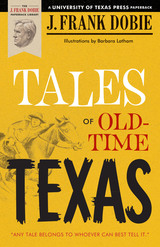 Tales of Old-Time Texas
By J. Frank Dobie
University of Texas Press, 1955 It is for good reason that J. Frank Dobie is known as the Southwest's master storyteller. With his eye for color and detail, his ear for the rhythm of language and song, and his heart open to the simple truth of folk wisdom and ways, he movingly and unpretentiously spins the tales of our collective heritages. This he does in Tales of Old-Time Texas, a heartwarming array of twenty-eight stories filled with vivid characters, exciting historical episodes, and traditional themes. As Dobie himself says: "Any tale belongs to whoever can best tell it." Here, then, is a collection of the best Texas tales—by the Texan who can best tell them. Dobie's recollections include such classics in Lone Star State lore as the tale of Jim Bowie's knife, the legend of the Texas bluebonnet, the story of the Wild Woman of the Navidad, and the account of the headless horseman of the mustangs. Other stories in this outstanding collection regale us with odd and interesting characters and events: the stranger of Sabine Pass, the Apache secret of the Guadalupes, the planter who gambled away his bride, and the Robinhooding of Sam Bass. These stories, and many more, make Tales of Old-Time Texas a beloved classic certain to endure for generations.
 The Tales Of Prince Samuttakote: A Buddhist Epic from Thailand
Thomas John Hudak
Ohio University Press, 1993 During the seventeenth and eighteenth centuries, Thai poets produced epics depicting elaborate myths and legends which intermingled the human, natural, and supernatural worlds. One of the most famous of these classical compositions is the Samuttakhoot kham chan, presented here in English for the first time as The Tale of Prince Samuttakote. The work of three poets, it was begun during the reign of King Naray (1656-1688) and was completed in 1849 by the patriarch-prince Paramanuchit Chinorot (1790-1853).
Translated with enchanting poetic imagery, the poem relates the adventures of Prince Samuttakote and his princess as they tour the heavenly realms with a magic sword. The two are separated after the sword is stolen but are reunited after further adventures. Upon ascending the throne, they teach the moral code of precepts and how all life is affected by it. The poem is important for its depiction of the amusements and daily life of seventeenth-century Thailand and for its use of classic Thai poetic devices.
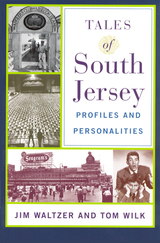 Tales of South Jersey: Profiles and Personalities
Waltzer, Jim
Rutgers University Press, 2001 There's much more to southern New Jersey than the Pine Barrens and the Jersey Devil, and this collection by journalists Jim Waltzer and Tom Wilk tells readers all about it. Oceanside and bayside towns offer a box seat from which to observe the regions rich history and the summery lore of the wonders of nature. Landlocked towns boast their own homespun and hell-raising traditions and idiosyncrasies. Waltzer and Wilk have compiled almost fifty stories about the state's southernmost counties. Although the focus is on Atlantic City and its remarkable people, outsize structures, and quirky events, the storytelling ranges across the wider region to provide an insiders look at history as it was being made. You'll encounter gangsters and gamblers, baseball hitters and hurricanes, famous piers and hotels, landmark theaters and eateries, splashy events and unheralded oddities ¾ in sum, a cross-section of the regions character and characters. The authors divide their book into six sections: entertainment, famous and infamous events, innovations and innovators, leisure and recreation, room and board, and sports legends. Within each section are the rich and varied stories Waltzer and Wilk have collected for New Jerseyans reading pleasure.
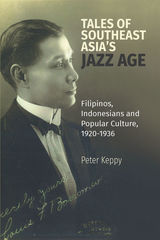 Tales of Southeast Asia’s Jazz Age: Filipinos, Indonesians and Popular Culture, 1920-1936
Peter Keppy
National University of Singapore Press, 2019 Luis Borromeo was the Philippines’s “King of Jazz,” who at the height of his popularity created a Filipino answer to the Ziegfeld Follies. Miss Riboet was a world-famous Javanese opera singer who ruled the theater world. While each represented a unique corner of the entertainment world, the rise and fall of these two superstar figures tell an important story of Southeast Asia’s 1920s Jazz Age.
This artistic era was marked by experimentation and adaption, and this was reflected in both Borromeo’s and Riboet’s styles. They were pioneering cultural brokers who dealt in hybrids. They were adept at combining high art and banal entertainment, tradition and modernity, and the foreign and the local.
Leaning on cultural studies and the work on cosmopolitanism and modernity by Henry Jenkins and Joel Kahn, Peter Keppy examines pop culture at this time as a contradictory social phenomenon. He challenges notions of Southeast Asia’s popular culture as lowbrow entertainment created by elites and commerce to manipulate the masses, arguing instead that audiences seized on this popular culture to channel emancipatory activities, to articulate social critique, and to propagate an inclusive nationalism without being radically anticolonial.
TALES OF THE ARKANSAS FRONTIER: Territorial and Early Statehood Eras
JON DAVID CASH
Parkhurst Brothers, Inc., 2025 Tales of the Arkansas Frontier by Jon David Cash is for both students of history and those who are simply curious about the past. Cash’s accessible style of writing and storytelling introduces the reader to the names and amazing stories behind well-known cities and counties in Arkansas.
 Tales of the Field: On Writing Ethnography
John Van Maanen
University of Chicago Press, 1988 For more than twenty years, John Van Maanen’s Tales of the Field has been a definitive reference and guide for students, scholars, and practitioners of ethnography and beyond. Originally published in 1988, it was the one of the first works to detail and critically analyze the various styles and narrative conventions associated with written representations of culture. This is a book about the deskwork of fieldwork and the various ways culture is put forth in print. The core of the work is an extended discussion and illustration of three forms or genres of cultural representation—realist tales, confessional tales, and impressionist tales. The novel issues raised in Tales concern authorial voice, style, truth, objectivity, and point-of-view. Over the years, the work has both reflected and shaped changes in the field of ethnography.
In this second edition, Van Maanen’s substantial new Epilogue charts and illuminates changes in the field since the book’s first publication. Refreshingly humorous and accessible, Tales of the Field remains an invaluable introduction to novices learning the trade of fieldwork and a cornerstone of reference for veteran ethnographers.
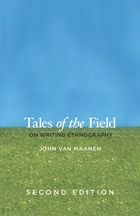 Tales of the Field: On Writing Ethnography, Second Edition
John Van Maanen
University of Chicago Press, 2011 For more than twenty years, John Van Maanen’s Tales of the Field has been a definitive reference and guide for students, scholars, and practitioners of ethnography and beyond. Originally published in 1988, it was the one of the first works to detail and critically analyze the various styles and narrative conventions associated with written representations of culture. This is a book about the deskwork of fieldwork and the various ways culture is put forth in print. The core of the work is an extended discussion and illustration of three forms or genres of cultural representation—realist tales, confessional tales, and impressionist tales. The novel issues raised in Tales concern authorial voice, style, truth, objectivity, and point-of-view. Over the years, the work has both reflected and shaped changes in the field of ethnography. In this second edition, Van Maanen’s substantial new Epilogue charts and illuminates changes in the field since the book’s first publication. Refreshingly humorous and accessible, Tales of the Field remains an invaluable introduction to novices learning the trade of fieldwork and a cornerstone of reference for veteran ethnographers.
Tales of the Metric System: A Novel
Imraan Coovadia
Ohio University Press, 2016 In Tales of the Metric System, Coovadia explores a turbulent South Africa from 1970 into the present. He takes his home country’s transition from imperial to metric measurements as his catalyst, holding South Africa up and examining it from the diverse perspectives of his many characters. An elite white housewife married to a radical intellectual; a rock guitarist; the same guitarist’s granddaughter thirty years later; a teenaged boy at the mercy of mob justice—each story takes place over one of ten days across the decades, and each protagonist has his own stakes, her own moment in time, but each is equally caught in the eddies of change. Tales of the Metric System is clear eyed, harrowing, and daring.
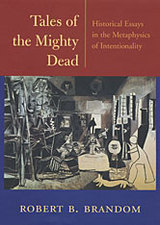 Tales of the Mighty Dead: Historical Essays in the Metaphysics of Intentionality
Robert B. Brandom
Harvard University Press, 2002 A work in the history of systematic philosophy that is itself animated by a systematic philosophic aspiration, this book by one of the most prominent American philosophers working today provides an entirely new way of looking at the development of Western philosophy from Descartes to the present.
Brandom begins by setting out a historical context and outlining a methodological rationale for his enterprise. Then, in chapters on Spinoza, Leibniz, Hegel, Frege, Heidegger, and Sellars, he pursues the most fundamental philosophical issues concerning intentionality, and therefore mindedness itself, revealing an otherwise invisible set of overlapping themes and explanatory strategies. Variously functionalist, inferentialist, holist, normative, and social pragmatist in character, the explanations of intentionality offered by these philosophers, taken together, form a distinctive tradition. The fresh perspective afforded by this tradition enriches our understanding of the philosophical topics being addressed, provides a new conceptual vantage point for viewing our philosophical ancestors, and highlights central features of the sort of rationality that consists in discerning a philosophical tradition--and it does so by elaborating a novel, concrete instance of just such an enterprise.
 Tales of the Prague Ghetto
Siegfried Kapper
Karolinum Press, 2022 A collection of nineteenth-century folklore-infused tales of Jewish life in Prague.
Trained in philosophy and medicine, the writer, translator, scholar, and political and cultural activist Siegfried Kapper (1821–1879) devoted significant effort to the advancement of Jewish culture in Bohemia, Jewish emancipation, and to the commitment of Jews to contemporary Czech society. The three stories in this collection, which first appeared in the press in the 1840s and were posthumously published as a collection at the end of the century, offer a Romantic and folkloric vision of Jewish culture in Prague.
The first story, “Genenda,” displays Kapper’s operatic eye for detail and drama with its account of a dutiful rabbi’s daughter being swept away by a dashing young man, a Christian nobleman disguised as a Jew. “The Curious Guest” is an intricate tale of a quest for wisdom and power. The final story, “Glowing Coals,” is a supernatural tale of romantic desire and revenge, displaying Kapper’s skill at deploying the tropes of folklore for dramatic literary effect. The collection not only provides a colorful snapshot of nineteenth-century Czech-Jewish culture but also resonates with universal human themes that transcend a single national experience.
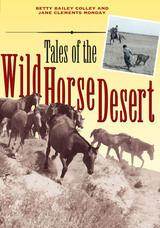 Tales of the Wild Horse Desert
By Betty Bailey Colley and Jane Clements Monday
University of Texas Press, 2001 Highly skilled, hard-working, and loyal to each other and to the ranches that employ them, the Mexican and Mexican American vaqueros who work on the famous King and Kenedy Ranches of South Texas' Wild Horse Desert are some of America's best cowboys. Many of them come from families who have lived and worked on the ranches for over a hundred years. They preserve the memories of ranch life handed down by their grandparents and great-grandparents, even as they use modern technologies to keep the ranches running smoothly in the twenty-first century. This book tells the stories of the vaqueros of the Wild Horse Desert for fourth- through eighth-grade students. It begins with a brief history of the vaqueros and the King and Kenedy Ranches. Then, using in the words of today's vaqueros and their families, it describes many aspects of past and present life on the ranches. Young readers will learn what it's like to grow up on the ranches and how vaqueros learn their work. They'll also discover how much goes into being a vaquero, from using all the different ropes and equipment, to working a round-up, to showing prize-winning cattle and horses. Teachers and parents will appreciate all the supplemental material in the appendix, including a glossary, lists of related books and websites, hands-on learning activities, and even range and camp house recipes.
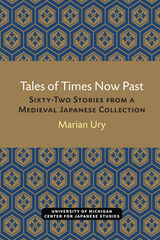 Tales of Times Now Past: Sixty-Two Stories from a Medieval Japanese Collection
Marian Ury
University of Michigan Press, 1993 Tales of Times Now Past is a translation of 62 outstanding tales freshly selected from Konjaku monogatari shu, a Japanese anthology dating from the early twelfth century. The original work, unique in world literature, contains more than one thousand systematically arranged tales from India, China, and Japan. It is the most important example of a genre of collections of brief tales which, because of their informality and unpretentious style, were neglected by Japanese critics until recent years but which are now acknowledged to be among the most significant prose literature of premodern Japan. “Konjaku” in particular has aroused the enthusiasm of such leading 20th-century writers as Akutagawa Ryunosuke and Tanizaki Jun’ichiro. The stories, with sources in both traditional lore and contemporary gossip, cover an astonishing range—homiletic, sentimental, terrifying, practical-minded, humorous, ribald. Their topics include the life of the Buddha, descriptions of Heaven and Hell, feats of warriors, craftsmen, and musicians, unsuspected vice, virtue, and ingenuity, and the ways and wiles of bandits, ogres, and proverbially greedy provincial governors, to name just a few. Composed perhaps a century after the refined, allusive, aristocratic Tale of Genji, Konjaku represents a masculine outlook and comparatively plebeian social orientation, standing in piquant contrast to the earlier masterpiece. The unknown compiler was interested less in exploring psychological subtleties than in presenting vivid portraits of human foibles and eccentricities. The stories in the present selection have been chosen to provide an idea of the scope and structure of the book as a whole, and also for their appeal to the modern reader. And the translation is based on the premise that the most faithful rendering is also the liveliest.
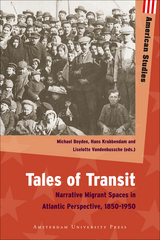 Tales of Transit: Narrative Migrant Spaces in Atlantic Perspective, 1850-1950
Edited by Michael Boyden, Hans Krabbendam, and Liselotte Vandenbussche
Amsterdam University Press, 2013 Traditionally, migration has been studied at either the beginning or the end of the journey. Surprisingly little research has been devoted to what actually happens to people in between. The contributors to this collection draw on a variety of primary and secondary sources, including travel writings, fiction, and diaries, to explore immigrants' liminal experiences on ships and in exit ports on both sides of the Atlantic. Combining scholarship from the field of transportation history with that of social history and translation studies, Tales of Transit reveals the complexity of what people experience as they get uprooted or reattach themselves to a community. A novel addition to the literature of transatlantic movements of the mid-nineteenth and twentieth centuries, Tales of Transit demonstrates in vivid detail how migration was seldom a straightforward progression.
Tales of Trilussa
Carlo Albert Salustri
University of Arkansas Press, 1990 The greatest poet of the twentieth century to write in Romanesco, Trilussa (1887–1950) gained national and international standing, becoming one of those extremely rare poets who have made their living entirely from their own work. John DuVal chose for translation the best poems from Tutte le poesie, Trilussa’s collected poems, which capture the satire and comic-lyric sensibility of this beloved Roman poet.
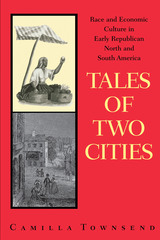 Tales of Two Cities: Race and Economic Culture in Early Republican North and South America
By Camilla Townsend
University of Texas Press, 2000 With a common heritage as former colonies of Europe, why did the United States so outstrip Latin America in terms of economic development in the nineteenth century? In this innovative study, Camilla Townsend challenges the traditional view that North Americans succeeded because of better attitudes toward work—the Protestant work ethic—and argues instead that they prospered because of differences in attitudes towards workers that evolved in the colonial era. Townsend builds her study around workers' lives in two very similar port cities in the 1820s and 1830s. Through the eyes of the young Frederick Douglass in Baltimore, Maryland, and an Indian woman named Ana Yagual in Guayaquil, Ecuador, she shows how differing attitudes towards race and class in North and South America affected local ways of doing business. This empirical research significantly clarifies the relationship between economic culture and racial identity and its long-term effects.
 Tales of Wayward Girls and Immoral Women: Case Records and the Professionalization of Social Work
Karen W. Tice
University of Illinois Press, 1998 Writing case records was central to the professionalization of social work, a task that by its very nature "created clients, authorities, problems, and solutions." In Tales of Wayward Girls and Immoral Women, Karen W. Tice argues that when early social workers wrote about their clients they transformed individual biographies into professional representations. Because the social workers were attuned to the intricacies of language, case records became focal points for debates on science, art, representation, objectivity, realism, and gender in public charity and reform. Tice uses 150 case records of early practitioners from a number of reform organizations and considers myriad books on the specifics of case recording to analyze the competing models of record-keeping, both in the field and outside it.
"An original and important study, this is the first major work I know of to carry out a contextual analysis of case records and to discuss the role case records have played in the development of social work." -- Leslie Leighninger, author of Social Work, Social Welfare, and American Society
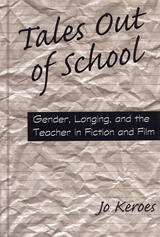 Tales Out of School: Gender, Longing, and the Teacher in Fiction and Film
Jo Keroes
Southern Illinois University Press, 1999
Jo Keroes's scope is wide: she examines the teacher as represented in fiction and film in works ranging from the twelfth-century letters of Abelard and Heloise to contemporary films such as Dangerous Minds and Educating Rita. And from the twelfth through the twentieth century, Keroes shows, the teaching encounter is essentially erotic.
Tracing the roots of eros from cultural as well as psychological perspectives, Keroes defines erotic in terms broader than the merely sexual. She analyzes ways in which teachers serve as convenient figures on whom to map conflicts about gender, power, and desire. To show how portrayals of men and women differ, she examines pairs of texts, using a film or a novel with a woman protagonist (Up the Down Staircase, for example) as counterpoint to one featuring a male teacher (Blackboard Jungle) or The Prime of Miss Jean Brodie balanced against Dead Poets Society.
The portrayals of teachers, like all images a culture presents of itself, reveal much about our private and social selves. Keroes points out authentic accounts of authoritative women teachers who are admired and respected by colleagues and students alike. Real teachers differ from the stereotypes we see in fiction and film, however. Male teachers are often portrayed as heroes in film and fallibly human in fiction, whereas women in either genre are likely to be monstrous or muddled and are virtually never women of color. Among other things, Keroes demonstrates, the tension between reality and representation reveals society's ambivalence about power in the hands of women.
Tales Out of School: Selected Interviews
Robert Creeley
University of Michigan Press, 1994 Since the publication of Robert Creeley’s first book of poems, Le Fou, more than forty years ago, he has emerged as one of the most important and original voices in contemporary poetry. Tales Out of School selects five extended interviews that point to Creeley’s artistic influences and reveal the subjects that have preoccupied the poet’s imagination. The interviews cover a range of themes, including Creeley’s childhood and early writing, the influence of jazz on his work, the history of the Black Mountain School, the relationship of geography to the creative process, and the influences and friendship of other poets, including Pound, Williams, Ginsberg, Levertov, Duncan, and Olson. Taken together, the interviews provide an active context for and complement an understanding of this significant and prolific poet’s achievement.
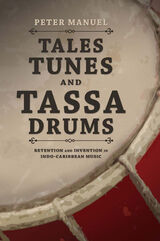 Tales, Tunes, and Tassa Drums: Retention and Invention into Indo-Caribbean Music
Peter Manuel
University of Illinois Press, 2015 Today's popular tassa drumming emerged from the fragments of transplanted Indian music traditions half-forgotten and creatively recombined, rearticulated, and elaborated into a dynamic musical genre. A uniquely Indo-Trinidadian form, tassa drumming invites exploration of how the distinctive nature of the Indian diaspora and its relationship to its ancestral homeland influenced Indo-Caribbean music culture.
Music scholar Peter Manuel traces the roots of neotraditional music genres like tassa drumming to North India and reveals the ways these genres represent survivals, departures, or innovative elaborations of transplanted music forms. Drawing on ethnographic work and a rich archive of field recordings, he contemplates the music carried to Trinidad by Bhojpuri-speaking and other immigrants, including forms that died out in India but continued to thrive in the Caribbean. His reassessment of ideas of creolization, retention, and cultural survival defies suggestions that the diaspora experience inevitably leads to the loss of the original culture, while also providing avenues to broader applications for work being done in other ethnic contexts.
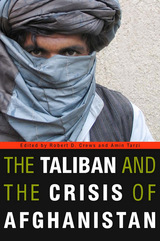 The Taliban and the Crisis of Afghanistan
Robert D. Crews
Harvard University Press, 2009 The Taliban remain one of the most elusive forces in modern history. A ragtag collection of clerics and madrasa students, this obscure movement emerged out of the rubble of the Cold War to shock the world with their draconian Islamic order. The Taliban refused to surrender their vision even when confronted by the United States after September 11, 2001. Reinventing themselves as part of a broad insurgency that destabilized Afghanistan, they pledged to drive out the Americans, NATO, and their allies and restore their "Islamic Emirate."
The Taliban and the Crisis of Afghanistan explores the paradox at the center of this challenging phenomenon: how has a seemingly anachronistic band of religious zealots managed to retain a tenacious foothold in the struggle for Afghanistan's future? Grounding their analysis in a deep understanding of the country's past, leading scholars of Afghan history, politics, society, and culture show how the Taliban was less an attempt to revive a medieval theocracy than a dynamic, complex, and adaptive force rooted in the history of Afghanistan and shaped by modern international politics. Shunning journalistic accounts of its conspiratorial origins, the essays investigate broader questions relating to the character of the Taliban, its evolution over time, and its capacity to affect the future of the region.
Offering an invaluable guide to "what went wrong" with the American reconstruction project in Afghanistan, this book accounts for the persistence of a powerful and enigmatic movement while simultaneously mapping Afghanistan's enduring political crisis.
 Talk about Sex: How Sex Ed Battles Helped Ignite the Right
Janice M. Irvine
Temple University Press, 2023 Praise for Talk about Sex
“Must reading for scholars, sexuality researchers, activists, and public policy and public health planners engaged in efforts to promote education on sex, sexually transmitted diseases, and HIV infection prevention for adolescents in schools.”—JAMA
Talk about Sex is a rich social history about the political transformations, cultural dynamics, and emotional rhetorical strategies that helped the right wing manufacture controversies on the local and national levels in the United States. Although the emergence of a politicized Christian Right is commonly dated at the mid-seventies, with the founding of groups like the Moral Majority, Talk about Sex tells the story of a powerful right-wing Christian presence in politics a full decade earlier. These activists used inflammatory sexual rhetoric—oftentimes deceptive and provocative—to capture the terms of public debate, galvanize voters, and reshape the culture according to their own vision.
This 20th Anniversary Edition includes a new preface and epilogue by the author that examines current controversies over public education on sexuality, gender, and race.
Demonstrating how the right wing draws on the cultural power of sexual shame and fear to build a political movement, Talk about Sex explores the complex entanglements of sexual knowledge, politics, and discourses.
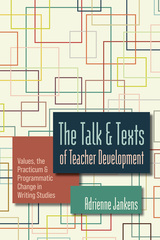 The Talk and Texts of Teacher Development: Values, the Practicum, and Programmatic Change in Writing Studies
Adrienne Jankens
Utah State University Press, 2026 The Talk and Texts of Teacher Development explores the role of writing programs—specifically practicum courses—in developing teachers and articulating programmatic values. Drawing on interviews, curricular analysis, program archives, and teacher research, Adrienne Jankens explores how implicit values shape decisions about curriculum, pedagogy, and programmatic structures.
Through her multi-site analysis, Jankens examines the ways values are reflected in syllabi, committee meetings, and classroom practices. She demonstrates how values that are often unstated or assumed can be made explicit and linked to programmatic action, thus supporting development and aligning instructional goals with broader institutional objectives. Offering a nuanced framework on practicum courses, Jankens also highlights the importance of local contexts and distinguishes among tacit, implicit, explicit, emergent, and articulated values. This layered understanding helps reveal the often hidden mechanisms by which writing program values are enacted in day-to-day teaching practices.
Teacher development is a crucial site for enacting and understanding programmatic values, and making these values explicit can guide meaningful programmatic change. Providing an institutional ethnography of Jankens’s own writing program and situating those findings within broader conversations in writing studies, The Talk and Texts of Teacher Development adds to scholarship exploring the focus of the practicum course, the positionality and experience of graduate teaching assistants in writing programs, and the perennial work of the field to identify its core values and disciplinary identity.
|
|














